





































Middle market companies face unique challenges. To succeed, having access to the right resources is essential. Whether you want to protect, grow or transform your business, you need a team that has depth of knowledge and expertise to advise you successfully.


Armory provides comprehensive capabilities focused exclusively on the middle market, including investment banking, consulting and asset management. Our collective capabilities provide a unique perspective into the middle market, allowing us the exibility to deploy the right resources to identify the right solution to best serve your needs.

With broad coverage in 12 industry verticals, we have a track record of adding value for our clients. Clients choose us because they have con dence in our resources, our expertise and our ability to consistently deliver results.




Seven leaders on how they found success by thinking outside the box
How Toyota’s Christopher Reynolds turns each career challenge into a lesson learned
Crayola’s Warren Schorr guides the innovation behind the company’s strategic moves into wellness, cosmetics, and museums 40
How Elizabeth Ryder helped Nexstar Media Group find its way into sixty million homes across America

46
Societe Generale Americas’ Jamie Kopsachilis actively drives progressive change and champions internal mobility

26 Passion and Purpose
Glenn Edwards brings true enthusiasm to his role while helping make energy sustainable at Trane Technologies
30
At Bluebird Network, Carla Cooper builds on her past CPA experience to maximize efficiency and potential
33
CHRO Pam Teufel knows to listen to employee concerns with a sympathetic ear
As Bremer Bank’s SVP and CISO, Hassan Asghar makes sure he and his team are always ready for the next challenge
of Planview (Gilmore), 80’s Child/Shutterstock.com (lion head), Valerie Ott (Shier)

Mary McCann brings a pragmatic mindset to helping S&P Global navigate risk and regulations
66 Pivotal Leader
How CEO Gregory Gilmore helped Planview reinvent itself to fit the evolving needs of its customers and the market
John Emmart draws from his time as a hospital chaplain to improve the lives of Phelps Health’s employees
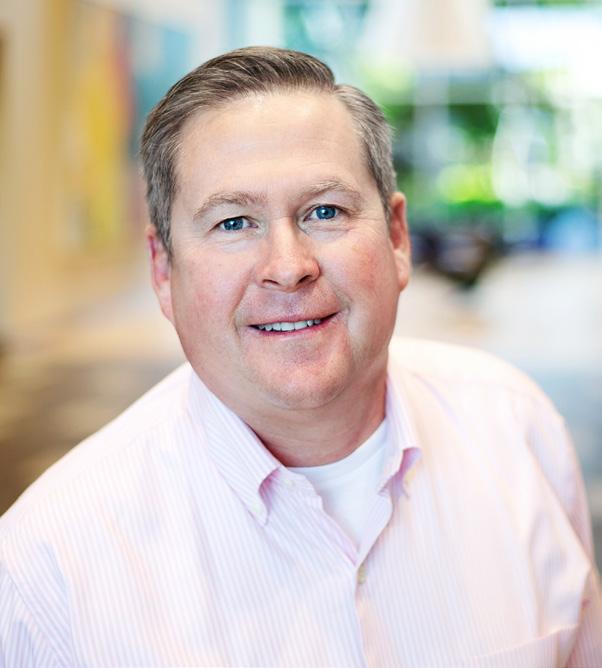
128
Julie Cummings aligns with BKD’s peoplefirst philosophy, improving the employee experience through personalization
135
Sherry Schultz’s childhood vow to respect the journey of others and seek to understand guides her HR leadership
138
How Karen Shier built Trillium Staffing Solutions’ HR department from scratch to support the growing company

“Technical geek” Dan Whinnie couldn’t be happier about his role and the growth opportunities Foot Locker provides
151
Yvonne Freeman champions a customer mindset to continually serve and market to Sabre team members across the globe
75
Envision Healthcare’s Kenneth Zongor oversees the implementation of a new, fully integrated ERP system
82
For more than twenty years at MGM Resorts, Laura Lee has helped mold a company culture that attracts and retains top-flight talent
Jennifer Goschke cultivates cross-functional relationships to better guide her team and 7-Eleven to success
154
Director, Creative Production
Kevin Warwick
Managing Editor
Frannie Sprouls
Editors
Melaina K. de la Cruz
Sara Deeter
KC Esper
Hana Yoo
Staff Writer
Billy Yost
Contributing Writers
Zach Baliva
Cora Berg
Jeremy Borden
Lucy Cavanagh
Joseph Charney
Peter Fabris
Frederick Jerant
Keith Loria
Cristina Merrill
Sara Verdi
Clint Worthington
Stephanie Zeilenga
Designer
Melody Pohla
Photo Editors/Staff
Photographers
Cass Davis
Gillian Fry
Profile® is a registered trademark of Guerrero, LLC.

© 2021 Guerrero, LLC guerreromedia.com
825 W. Chicago Ave. Chicago, IL 60642
Subscriptions + Reprints
For a free subscription, please visit profilemagazine.com /subscribe. Printed in China. Reprinting of articles is prohibited without permission of Guerrero, LLC. For reprint information, contact Reprints & Circulation Director Stacy Kraft at stacy@guerreromedia.com.
CEO & Publisher
Pedro A. Guerrero
Chief of Staff
Jaclyn Gaughan
President, Group Publisher
Kyle Evangelista
VP, Hispanic Division
Head of Audience & Engagement
Vianni Lubus
VP, Finance
David Martinez
Director, Client Services
Cheyenne Eiswald
Senior Client Services Manager
Rebekah Pappas
Client Services Manager
Brooke Rigert
Director, Talent Acquisition
Elyse Schultz
Talent Acquisition Manager
Haylee Himel
Director, Strategic Partnerships
Krista Horbenko
Senior Events Manager
Jill Ortiz
Senior Director, Sales
Ben Julia
Director, Sales Training & Development
Alexa Johnson Content & Advertising Managers

Tyler Durrett
Brennan Elias
Brandon Havrilka
Holly Miller
Elif Negiz
Annie Peterson
Isha Pieter
Angela Reeves
Kelly Stapleton
Hannah Tanchon
Drew Thomas
Ashley Watkins
Disrupting is not something that comes easily to me. I like my processes and routines, and I often find comfort in “knowing” what I can expect to happen next.
But disruption often happens when you don’t expect it, and it’s a matter of how you adjust to those moments. As I was studying journalism in college and interning at different daily newspapers, I had to learn how to be flexible—both within the role itself and in my overall career. I honed my skills and grew comfortable with the various workflows and processes, building my editorial “muscle memory.”
It was then I could take a step back to see the big picture and the opportunities for disruption. I’ve been through countless magazine production cycles and even more daily newspaper cycles. How could I use that knowledge and my own experience as a media consumer to disrupt the magazine experience?
For this Disruptors issue, I worked closely with our designer Melody Pohla to create a more interactive experience. We rotated the Disruptors feature section entirely on its side, but we wanted to do more.
We wanted to find a way to bridge the gap between print and digital.
First was finding a way to let you easily share the stories you learned from and loved. As you flip through the magazine, you’ll find QR codes alongside some of the features. Using your smartphone camera, you’ll be able to focus the lens on the code and get the notification to open the article online. From there, you can share across your social networks.
And second, we wanted to do something special with our cover star, serial entrepreneur and VaynerMedia CEO Gary Vaynerchuk: augmented reality. In a multilayered experience through the free Adobe Aero iPhone app, you can see select quotes within his feature come to life on pages 96, 99, and 162.
These are just two simple steps that we are taking for this issue. Disruption doesn’t lead to successful change overnight. “If we’re talking about disruption,” Vaynerchuk notes in his feature, “you’re talking about changing a well-entrenched institution that will take decades, not days, to make actually happen.”
We’ll be constantly rethinking how we can disrupt and evolve the magazine experience for the better—and we’re glad you’re on this journey with us.
Facebook: @gh.profilemagazine
LinkedIn: @Profile_ExecMag
Twitter: @Profile
Frannie Sprouls Managing Editor Gillian Fry»It was the most unusual job interview of his life. Raymond Keane had done his homework, studying the organization and its leaders. He expected to explain his résumé and discuss his ambitions. However, soon after making his introduction, Keane was sitting cross legged on the floor, in a suit, playing with toy bricks. He wasn’t taken by surprise. The company, LEGO Systems Inc., was part of the LEGO Group, after all, and Keane came prepared to play.
While the LEGO Group executives did ask Keane some of the standard interview questions, their final request was anything but typical. They pointed to several bins of LEGO bricks and asked the candidate to create something to illustrate his background and experience. Then they left the room.
When the team came back, Keane was ready to discuss his creation—an elaborate spaceship. First, he included a potted plant just for fun, which resonates at a company that promotes play and imagination. Then he talked about his own minifigure, which stands next to a keyboard that represents
his lifelong passion for music. Next, he explained the most important and revealing aspect of the build—the two other minifigures who stand next to Keane’s, appearing to learn from their tiny plastic mentor.
Although Keane was at the LEGO Group to discuss a role in their legal department, he earned an undergraduate degree in English. Upon graduation, he took an entry-level job at an insurance company to make ends meet. “I always had a vague idea that I wanted to help people,” he says. “I’ve known for a long time that service is something I’ll take with me no matter what I do.” It didn’t take long for Keane to realize the insurance job was a bad fit. He joined AmeriCorps and volunteered to mentor and teach high school students.
It was a big transition. Keane went from the cubicle to the classroom, where he was teaching music and other subjects while directing a grant-funded program to pair at-risk youth with community mentors. Keane found the experience challenging and rewarding. Social and emotional issues often prevented his students from
concentrating. After attempting various failed remedies, Keane finally found something that worked: LEGO bricks. He introduced the colorful toys into the classroom setting, and it didn’t take long for him to notice an improvement. Students channeled their extra energy to the famous bricks and were content to fidget or build as they diagrammed sentences or discussed a book.
In presenting his own LEGO brick-based build, Keane was able to demonstrate his leadership experience and his understanding of the LEGO brand while tying in his passion for coaching others. Like many Americans, Keane grew up playing with LEGO sets, but he also had firsthand experience of the positive corporate culture. In 2015, while working as a legal manager at an insurance company, Keane took his family to LEGO Systems Inc.’s corporate offices for the LEGO 5K Family Road Race and Children’s Fun Run. The annual event raises money for local charitable organizations. In addition to racing, participants can visit bounce houses, food stations, LEGO Master Builder events, the company store, and other fun activities.
Keane says the 5K was a turning point in his professional journey. “People seemed genuinely glad to be there,” he explains. “The volunteers were smiling, the employees were
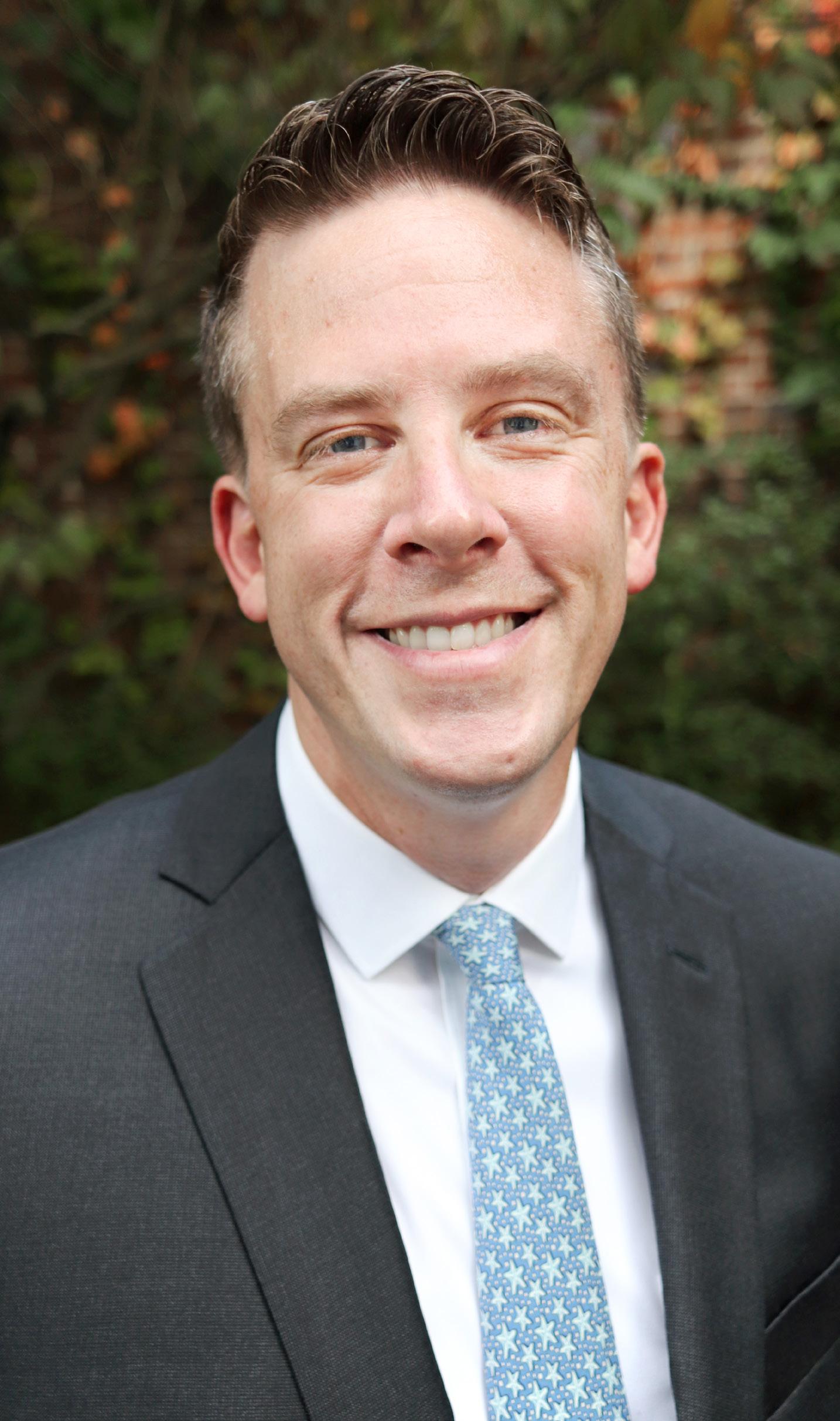
happy, and everyone was having fun. I knew then that the culture was truly special.”
After presenting his spaceship, Keane received a job offer. The LEGO Group invited him to join the organization as a team lead in their legal support function, where he managed employment, corporate, transactional, and IP matters in the US, China, and Denmark.

Keane’s first day on the job was even more unusual than his interview. Upon completing his onboarding paperwork, the new hire was shuttled to Boston Logan International, where he changed clothes and boarded a flight to Denmark to get important face time before his director’s maternity leave. Keane, who had never been to Europe before, enjoyed a private tour of an employeeonly museum, and he was struck by the genuine kindness, interest, and personal attention he received from long-tenured employees and high-level leaders.
Back in the US, Keane settled into his job and enjoyed more opportunities to serve and mentor others. “Knowledge sharing has always been big for me, and I’ve been fortunate to find a company that values it as much as I do,” he says. Now, as senior corporate counsel, Keane advises
his business counterparts in matters related to litigation, employment law, and commercial transactions.
More than five years later, Keane is confident he’s working in the right place. He’s used his expertise to build remote teams to help navigate an organizational response to the COVID-19 pandemic. The experience has also touched on Keane’s passion for service, as the LEGO Group worked to support its community with toy donations and financial contributions to address food insecurity. As employment counsel, he’s helped LEGO Systems Inc. revamp a vacation policy and other initiatives that improve corporate culture and work/life balance.
Like most LEGO employees, Keane has a few favorite playsets. He enjoyed completing a 3,036-piece Tree House made with plant-based materials. The company aims to move to an entirely sustainable brick base in the next decade. Other favorites for his family of five include anything from the Harry Potter Collection.
But perhaps Keane’s favorite build of all time is a custom piece—the small spaceship from his interview, which still sits on his office shelf as reminder of who he is and where he’s been. «
“It’s an honor to represent The LEGO Group, which cares deeply about its customers and the worldwide community it serves. Ray Keane epitomizes The LEGO Group ethos. He cares first about doing the right thing, about doing good for those who The LEGO Group serves.
Eversheds Sutherland congratulates Raymond Keane.”
– Lewis Wiener Partner Eversheds Sutherland
T: +1 202 383 0140
lewiswiener@ eversheds-sutherland.com
Local knowledge. Global reach.
© Eversheds Sutherland Ltd. 2020 Attorney advertising
eversheds-sutherland.com
Doing good, doing right
“Knowledge sharing has always been big for me, and I’ve been fortunate to find a company that values it as much as I do.”
Raymond Keane
After completing his PhD in educational leadership and policy, Mark Scott “pushed all his chips in” on an unusual post-doctoral path. “My motivation has always been about doing purposeful work,” he says. Now he finds that motivation as CEO of the Culinary Academy of Las Vegas, with missions to reduce poverty and improve community engagement through education.
The Culinary Academy offers vocational training in hospitality services through theoretical and applied learning, as well as internships, and the robust model stands out. Though many graduates land traditional hotel and restaurant placements in Las Vegas, the education and skills gained from the Culinary Academy allows students to find success in other industries, such as healthcare.
Born of a collective bargaining process almost thirty years ago, the Academy holds interest from management and labor. Both encourage staff and potential employees to attend courses. “My job is to listen and seek ways to help,” Scott explains, and
the Culinary Academy’s relationship with Culinary Union Local 226 and Bartenders Union Local 165, as well as thirty-five premier hotel and casino partners on the Las Vegas Strip, opens a direct line to member wants and needs.
Scott’s role also involves advocacy. He looks to community organizations, such as Catholic Charities and Shade Tree Shelter, to direct struggling populations toward the Culinary Academy. He also fosters partnerships with government agencies, including the Nevada Department of Training and Rehabilitation.
The majority of graduates, Scott says, come from the most underserved communities, zip codes with pre-pandemic double-digit unemployment rates. “For us it’s important to reach high, wide, and deep,” Scott says.
Scott, a self-professed crier and cheerleader, claims the least intense job of the Culinary Academy’s 229 staff members. After a reorganization, it had doubled capacity and was, pre-COVID, on track to enroll 2,400 students in 2020—not
including unique turnaround projects that help its 35 employer partners train and transition their staff when a steak restaurant becomes a sushi joint, for example. This participant volume does not impact Scott’s dedication to ensure that “each student knows they are important and that they count.”
In 1993, the Culinary Academy opened in a Days Inn motel on Fremont Street, the city’s old downtown. The training center now bursts the seams of a fifty-thousand square-foot building. “Back then, the work was simple. A fry cook was a fry cook,” Scott says. “Now the dining and beverage experience has shifted.” The CEO leads a team focused on preparing students for the modern complexities of hospitality, including digital skills and social/ emotional intelligences, critical thinking, and creativity.
“We know that tech is out there, and customers will expect or accept it,” Scott says. “The question is how do we integrate tech to do no harm.” He calls on management, labor, and employees to respond
 Mark Scott CEO
Mark Scott CEO
and to think about the triple bottom line, employee ROI, and community improvement. “People believe that the hospitality industry will just take care of itself. My job is to build a great team to support decisions.”
Scott describes his work’s essence as cultivating supportive environments that respond to the realities of people’s lives and offer holistic solutions. Dedication to this ideal has only increased since March 2020. In these moments, Scott finds inspiration in lessons his mother made foundational to his upbringing: “It’s OK to cry. At some point you have to stop crying,” Scott says. “Everything has a season. Even the most difficult. Pick yourself up and move forward, even if it’s slowly.”
When COVID-19 hit, the Las Vegas Strip, the economic lifeblood of the region, went dark and sixty thousand union members lost their jobs. Culinary 226 and Bartenders 165 asked for help with emergency food
assistance. Scott did not hesitate. “We know food. We have space. We have tech,” he says.
In forty-eight hours, they created a system for members to pick up, or have delivered, forty pounds of groceries weekly.
As of August 2020, the Culinary Academy had provided over 110,000 food baskets. “This is the most humbling thing I have ever done,” Scott says. “Food insecurity is a prevalent issue. It is our responsibility to step up. We must see ourselves all in the same fight so that we can all be healthy.”
While Scott does not sugarcoat the economic effects of COVID-19, he remains optimistic. As instructed by his mother, he puts one foot in front of the other and envisions a future where what happens in Vegas does not stay in Vegas. He already fields requests for training and curriculum support from around the country. With a shift to a hybrid instructional model, blending online learning
with applied experiences, Scott intends to brand and license curriculum under his new digital initiative, the WISE3 program. Design of micro courses and credentials is also underway. “Bite-sized chunks,” says Scott, who cannot resist the pun and laughs.
Scott joined the Culinary Academy in June 2018, after the 2017 mass shooting. “I could feel that the community would not let that incident define us or permanently impact the draw and interest to the city,” he says. He feels the same about the pandemic. “Threats of keeping Las Vegas down . . . we don’t really do that,” he says, describing a city on standby, ready to turn it all on again.
Scott has a clear message about how to move forward. “People carry significant burdens with them in life,” he says. “Employers will do well to think about that, especially now.” «
“It is our responsibility to step up. We must see ourselves all in the same fight so that we can all be healthy.”
Mark Scott
The mission of Chicago-based 2nd Story is simple: a wellcrafted, well-told story can be a catalyst for change. Founded in 1999, Chicago’s longestrunning storytelling series has told stories with messages as diverse as the storytellers themselves across bars, restaurants, and other intimate spaces all over the city.
CultureBuilds, an extension of 2nd Story, seeks to bring the empathy, compassion, and humanity of the storytelling experience to the workplace. Unlike more traditional HR sensitivity training, CultureBuilds is differentiated by its focus not on one-size-fits-all PowerPoint presentations but in the power of a single story to facilitate growth and spur the pursuit of empathy and understanding in the workplace.
National and global partners have looked to CultureBuilds for growth opportunities in one of the most politically and culturally polarized times in recent history. Artistic Director Amanda Delheimer, Managing Director Lauren Sivak, and Manager of Partnerships LaTanya Lane—all of whom
have engaged in rigorous pedagogical training—took the time to detail their own history with 2nd Story, the differentiating philosophy of CultureBuilds, and how difficult conversations can be an invaluable first step in the never-ending journey to a more equitable, fair, and compassionate world.
Delheimer has been with 2nd Story since 2003, when the organization was still staging more traditional plays. “Our 2nd Story shows were becoming the reason people were most excited about us and why they were showing up for the larger organization writ large,” Delheimer says. “We had a conversation and decided to take what we do best and to put all our energy into it. In 2007, we decided to stop producing plays and focus specifically on storytelling itself.”
Sivak joined 2nd Story in 2014, after six years within the prestigious Steppenwolf Theatre Company’s education and administrative departments. “I realized that while I was an arts education advocate, my real passion was in sustainable growth at




organizations whose work I think is essential,” Sivak explains. “2nd Story is one of those organizations. I deeply believe that we are changing the world one story at a time.”
And it wouldn’t be a modern storytelling arc without podcasts, which is how Lane first became aware of 2nd Story. She eventually wrote and auditioned for 2nd Story performances, later becoming a company member and more intricate contributor to the overall mission. Her fifteen-plus years
of nonprofit and organizing experience certainly don’t hurt either.
“After having built a relationship with this organization for years, there was a perfect intersection where I wanted a change of direction and 2nd Story was thinking of how to support its programming,” Lane says. “I’m working to further the mission of the great work Amanda and Lauren have done.”
CultureBuilds has grown organically from 2nd Story productions. “People were coming to us and asking us to do a 2nd Story show for their leadership groups, their discussion panels, and other events for employers,” Sivak says. “We’ve been doing this work for a very long time, but we just hadn’t figured out how to talk about it. The stories that we tell in our CultureBuilds aren’t crafted by our artists for an
“I deeply believe that we are changing the world one story at a time.”
Lauren Sivak
“We want to facilitate providing information but, more importantly, listening and giving people the opportunity to engage with someone else’s story.”
LaTanya Lane

HR training. That story was crafted by an artist because they think a story can change someone’s heart or mind.”
It’s easy to see CultureBuilds was built almost as an antithesis of the traditional HR training method. “A lot of the topics we talk about are complex, because they can be close to the heart and overwhelming,” Lane explains. “I think humans tend to take care of their hearts by creating this distance between the topic and themselves.
“Our goal is to help you connect with a story and to realize this isn’t supposed to fix everything right here and now,” she continues. “We want to facilitate providing information, but, more importantly, listening and giving people the opportunity to engage with someone else’s story.”
The core idea of CultureBuilds is to address the question about the relationship
between the personal and the professional.
“We feel like our society did itself a disservice when we decided that those two things were somehow fundamentally different,” Delheimer says. “And the moment that we’re in right now specifically requires that we do really complicated personal work in a professional setting, that we pay attention to people when they say they want to bring their whole selves to work. The entry point for Culture Builds is personal stories.”
The Reviews Are In CultureBuilds is a success already, with the difference it’s made through its partnerships and how that impacts 2nd Story both fiscally and culturally.
“It feels like there’s this cyclical process that’s helping us make better art,” Delheimer says. “When we have conversations with
employers, we come back to our artists to see if they have a story that can help them address this question. Many of the activities we do with CultureBuilds are exercises we do to help generate art for our 2nd Story shows.”
“We talk about the work of CultureBuilds and 2nd Story as us going around and planting seeds of trees whose shade we will never sit under,” Sivak says. “If we’re at a global law firm, working with first-year associates, and we’re doing an experience on empathy, we know we’re talking to future lawyers, senators, maybe even presidents. You’re helping them make empathy a daily part of their lives. We can help create positive change in this world.” «
Editor’s Note: At the time of press, LaTanya Lane is no longer at 2nd Story.
“The moment that we’re in right now specifically requires that we do really complicated personal work in a professional setting, that we pay attention to people when they say they want to bring their whole selves to work.”
Amanda Delheimer
Christopher Reynolds has prepared a CEO to testify before Congress, clerked for a renowned civil rights champion, and made partner at one of America’s top 100 law firms. But there is one earlier experience that set the stage for everything that was to come. Reynolds spent his high school years working in a nursing home for a strict boss—his mother.
Reynolds, who today is Toyota Motor North America’s chief administrative officer, credits days of changing sheets and emptying bedpans with putting him on the right path.
“I learned the value of hard work, I learned why education is important, and I learned to
respect those around me,” he says. “I’ve carried what I learned in that nursing home with me my entire career.”
After graduating from Kalamazoo College and Harvard Law, Reynolds worked for Judge Damon J. Keith in the US Court of Appeals. Keith, who had studied under Thurgood Marshall, once issued a landmark ruling that helped end racial segregation in Michigan. Reynolds, himself an African American lawyer, says Keith taught him how to be a Black professional, how to maintain confidence under adversity, and how to be a strong member of a community.
Reynolds would go on to hone his skills in a US Attorney’s Office before joining Morgan Lewis. Life at the big New York firm gave the
young lawyer the chance to add marketing and business development capabilities to his growing repertoire. One of those clients was Toyota. Reynolds represented the company in several legal matters and impressed the general counsel but rejected a formal job offer. A year later, he reconsidered and left New York to join Toyota’s California operations in 2007.
In his first year at Toyota, Reynolds learned some valuable lessons. The big city lawyer who had adopted the New York way came in with guns blazing. He managed the legal department and expected long hours, flawless results, and unwavering dedication. Toyota, however, emphasizes respect and teamwork. Founder Sakichi Toyoda promoted “a homelike atmosphere at work that is warm and friendly.” When Reynolds’s new colleagues staged an intervention, he quickly adapted to his new environment. “Culture eats people for lunch, and I had to decide if I was going to be on the menu or at the table,” he says.
By 2010, Reynolds had settled into his position leading the legal function when
president and CEO Akio Toyoda was summoned before US Congress to testify regarding the unintended acceleration of its vehicles and one of the biggest recalls in history. Reynolds helped prepare Toyoda, who made remarkable statements to the House Committee on Oversight and Government Reform. During the hearing, a contrite Toyoda admitted mistakes and expressed regret. “We pursued growth over the speed at which we were able to develop our people and our organization,” he said. Reynolds looks back on the ordeal as a “crucible experience” for Toyoda, himself, and the entire organization.
In the following months, Toyoda asked leaders to prioritize communication, quality improvements, and people as the company
looked to restore its reputation. Several North American operations united under one roof in Plano, Texas, to promote enterprise-level thinking. Toyota doubled down on its core values, which include respect for people and a focus on leadership development. “We know each employee has something significant to contribute, and we lose out when that potential isn’t developed,” Reynolds says.
Senior leaders have continuously pushed him to new heights. After starting in a purely legal role, Reynolds took on HR and legal affairs duties. In 2019, he assumed oversight of manufacturing plants across North America.
The fourteen complex facilities produce roughly 1.8 million vehicles per year

“Great leadership is our competitive advantage. We know that a person who lacks deep training can thrive in a role if they are a good leader with a great team.”
CHRISTOPHER REYNOLDS
(in normal times), making North America second only to Japan in annual revenue generation. Managing production of the company’s core product is critical—and Toyota has handed the task to one of its lawyers. That’s because the company believes in the power of a good leader.
“Great leadership is our competitive advantage. We know that a person who lacks deep training can thrive in a role if they are a good leader with a great team,” Reynolds says. “I’ve been given opportunities to grow, and I’ve been trained to find similar opportunities for other people.”
For Reynolds, the keys to success in any new situation are simple. He asks questions, sets direction, delegates to his team, trusts employees to execute, and then celebrities their accomplishments. Reynolds and Toyota
are also committed to diversity and inclusion. “We have a deep respect for people, and not just respect for certain kinds of people,” Reynolds says. The company’s plant in Kentucky—its largest by vehicle volume including power train production —is led by a woman, and Toyota holds the tenth spot on DiversityInc’s Top 50 Companies for Diversity.

Since Reynolds came to Toyota in 2007, he’s helped the company respond to a global recession, a massive recall, natural disasters in Japan, and the COVID-19 pandemic. Each of these events have tested both the person and the company. “These challenges form and shape people and companies alike,” Reynolds says.
After many years together, Reynolds is a respected industry leader, and Toyota’s products and reputation are stronger than ever.
“Culture eats people for lunch, and I had to decide if I was going to be on the menu or at the table.”
CHRISTOPHER REYNOLDSCourtesy of Toyota Motor North America In September 2019, Christopher Reynolds and Texas Governor Gregg Abbott celebrate Toyota’s $391 million investment in its San Antonio truck plant.
Some people don’t like change, but Ed Imbrogno is never afraid to try something different. His is not the typical accounting career, as he has built his expertise at firms across five different industries in four states. “The basic principles you can take from one industry to the next, but there are always opportunities to expand your knowledge,” Imbrogno explains. “I enjoy learning new things. I find it personally and professionally rewarding.”
His career has led him to the position of vice president, chief financial officer, and chief accounting officer for PDL BioPharma which has managed patents and other
investments since 2008. And he expects to start a new chapter sometime fairly soon, as PDL is in the process of monetizing its assets and winding down its operations.
“This process has introduced a number of projects that have allowed me to engage in so many different levels,” Imbrogno remarks. “It’s been a lot of work, but it’s fascinating. Dissolving a company is, by design, very structured. We’re looking to be as efficient as possible and provide the best return to our stockholders.”
Imbrogno didn’t always plan on becoming an accountant. He studied computer science when he enrolled at Penn State University but soon realized that path was not for him. As he was pondering what his next step would be,
With a career that extends across five industries, Ed Imbrogno finds motivation in opportunities that allow him to grow as an accounting executive
a friend suggested he consider accounting. “I did well with it, and I continued on that path,” Imbrogno explains. “The opportunities available with an accounting degree were pretty broad, so I just went with it.”
He embarked on his career, starting out as an auditor at a large accounting firm in Pittsburgh before transferring to Greensboro, North Carolina. There he became an audit manager, which he credits for providing invaluable, well-rounded training and exposure to different industries. That led him to a series of opportunities with different companies large and small.

An interesting element of his career is the fact that he has worked in four different industries after his public accounting career,
beginning with a textiles firm in Greensboro. It was during this time he continued his studies at Wake Forest, where he earned an MBA. After a long run in textiles heading up the accounting department, he moved into a financial reporting position for a company then located in Valencia, California, that designed and manufactured 3-D printers. Approximately one year after, he received his first opportunity in biotech pharma, staying in California with Amgen instead of moving cross-country with the 3-D printing company as it was relocating its headquarters. “There is a variety of technical accounting and financial reporting issues at a large biotech company, which I enjoyed,” he says, “and there is also a sense
Ed Imbrogno VP, CFO, and Chief Accounting Officer PDL Biopharma Inc.of pride working in an industry developing novel therapies for patients with serious unmet medical conditions. I am grateful for my Amgen experience.”
Imbrogno then took an opportunity with a Los Angeles-based aircraft leasing company to further his career, but it was acquired by a European-based competitor within a year of him joining. “Sometimes, your plans don’t unfold the way you envision, but you need to adapt and move on,” he says. After a lengthy transition period, he worked in consulting for a bit. This provided an opportunity to return to North Carolina where he worked as the controller for a specialty pharmaceutical company headquartered in Raleigh. Out of the blue, he was contacted about a chief accounting officer role at PDL in Incline Village, Nevada, near Lake Tahoe’s north shore.
“I was very attracted by the opportunity; it was a senior role where I felt I would have the chance to be meaningfully engaged, and I pursued it,” Imbrogno recalls. “After approximately one year at PDL, the CFO left unexpectedly and that created the opportunity for me to step up with expanded responsibilities.”
That unanticipated promotion required that he engage in certain areas more directly than before, such as investor relations, treasury, and board communications. His ability to adapt has been key to his success.
“It’s about being open to explore new opportunities knowing I’ll be challenged. Embracing new responsibilities keeps my career fresh and allows me to grow,” he says. “That’s very motivating for me.”
He is especially proud of his team’s ability to maintain its core responsibilities while also running many processes that are part of PDL BioPharma’s road to ending its operations.
“Every day presents a different project or a different deliverable,” he notes. “In Joy Strotz
addition to our regular accounting and financial reporting responsibilities working for a public company, we have a number of winddown processes operating concurrently, and the fact that we’re able to produce on all fronts is something I’m very proud of. I am fortunate to have such a strong team and to work with a collaborative group at PDL.”
Imbrogno’s career has seen him work not only in different industries but also in different parts of the country, and he’s grateful to have people in his life who support him.
“I’ve had the flexibility to go where my work takes me,” he says. “I’m fortunate to have a very understanding family. We moved from Pennsylvania to North Carolina to California, then back to North Carolina before venturing out to Nevada. When confronted with a career change, I am open to go where the most compelling opportunity takes me, and I’ll be doing that again when my responsibilities wrap up at PDL.”
Valuation Research Corporation knows that success is built upon a foundation of forward-thinking, tenacious, visionary leadership. On behalf of VRC, we congratulate a true leader, Ed Imbrogno, on his many achievements.
Since 1975, VRC has delivered supportable conclusions of value to domestic and international clients of all sizes and types. Our well-credentialed professionals are proud to work with leading public companies to focus our expertise on delivering objective and practical valuation opinions that withstand scrutiny.
We exceed your expectations for transparent, fair value-based financial and tax reporting requirements, and implement sound valuation programs that satisfy regulators and give investors confidence.


“It’s about being open to explore new opportunities knowing I’ll be challenged. Embracing new responsibilities keeps my career fresh and allows me to grow. That’s very motivating for me.”
ED IMBROGNO
Jamie Kopsachilis, a self-proclaimed poster child for internal mobility, excels at transformation. She began her journey in an IT capacity with Societe Generale (SG), the first major French bank to be granted a full US banking license, and then moved to finance, upgrading legacy systems and leading the company’s first offshoring. After serving as a divisional financial officer, she reached out to a colleague leading HR in search of a new opportunity.
This ask demonstrates Kopsachilis acting on one of her axioms. “Be dedicated and driven, leverage relationships, raise your hand, and constantly seek opportunities to learn and grow,” she says. The ask paid off. Kopsachilis became HR’s chief operating officer and later added head of HR services to her purview. In 2020, she celebrates thirty
years with SG and a great deal of personal and professional growth with the company. Her role changed in July 2020 as she transitioned some operational functions to the newly formed total rewards unit to focus on the management of HR strategic initiatives, regulatory projects, and recruitment as HR COO & head of HR strategy and talent acquisition.
“Some of my biggest successes have been in roles where I accepted opportunities and challenges that were outside of my comfort zone,” Kopsachilis says. This, she explains, results from a tenacious desire to follow her values, be genuine, and build on her strengths, as well as bring new perspectives to the table.
Kopsachilis shifted to HR with a keen financial perspective. While working in SG’s finance division, HR had been a client, offering her departmental knowledge from a unique vantage. Kopsachilis also leans on
With thirty years of institutional knowledge built through new opportunities, Jamie Kopsachilis actively drives progressive change and champions internal mobilityPoint your cell phone camera at the QR code to be directed to the online article.
a strong consulting background for her collaborative project management skills. And “I was an employee outside of HR,” she says, which layers on a lens of personal experience when evaluating user experience and process efficiencies.”
“Jamie’s knowledge and expertise in HR and business operations make her an asset to both her organization and her strategic business partners,” says Deb Watters, senior vice president and managing consultant, and the team at USI Insurance Services. “She is creative, practical, and always knows the right questions to ask to keep a project moving forward. It has been a pleasure to work and learn from her.”

Kopsachilis seeks transformation for others’ careers as well. The firm sees many internal mobility success stories, and Kopsachilis dedicates herself to facilitating internal moves for other employees. “It is better to help people find the next challenge than to lose the talent,” she explains.
To support internal growth and retention, Kopsachilis fosters leadership-level conversations around methods for better understanding staff potential and has been a longtime mentor for staff. Employees can self-identify skills and competencies that leadership and recruiters can easily draw upon when looking for new talent or expertise.
As Kopsachilis helps shepherd in the new, she pays homage to SG’s legacy. The organization has a rich history stretching back more than 150 years and operates in 67 countries with over 147,000 employees. Kopsachilis says this history can be witnessed in SG’s modern and collaborative workspace that is juxtaposed with remnants of the bank’s deep European roots, such as the intricate mosaic
Kopsachilisfloor tile and stained glass panels inspired by the interior architecture of the Boulevard Haussmann Branch Bank in Paris.
More than these flourishes, leadership takes the responsibility for caring for its employees very seriously. She remembers her first benefits package presentation, assuming they would want to go with the least expensive option. Instead, she witnessed a conversation about concerns around wellness and the economic impact of benefit changes on all levels of employees.
Kopsachilis leads by seeking to market SG’s fundamental ethos to a diverse group of potential employees. She seeks more than a set of candidates with specific sets of hard
skills. “Some of the best hires I have made are people that are resourceful—those with grit, drive, and passion,” she says.
In both hiring and employment, Kopsachilis says that due to SG’s smaller size in the Americas, individuals have greater opportunities to work on a broad array of projects that have a significant impact on the staff they support. SG sponsors eight active employee resource groups, a signal of the company’s continued focus and commitment to diversity and inclusion, Kopsachilis says.
Since the founding of SG’s Americas Women’s Network (AWN) over fourteen years ago, Kopsachilis has played an active role in the network and is currently its president. It

boasts over four hundred members and allies with chapters in New York, Chicago, Houston, and Montreal. The AWN makes a significant impact on helping move the needle on gender diversity at SG, and with the CEO as an active sponsor of AWN, there is a deep commitment to a diverse and inclusive culture from executive leadership.
To help AWN achieve its goals, Kopsachilis brings to bear some of her ideas that are essential for advancement. Beyond self-advocacy, she says, “it is critical to have advisors, mentors, and sponsors—people willing to provide honest and critical feedback, as well as individuals who will put their political clout on the line to support and advocate for you when you are not in the room.” She sees this work, and her work on the SG Diversity Council, as fundamental in trying to ensure that employees can genuinely bring their whole selves to work.
Participation with the network, and allyships with other ERGs, provides a huge benefit in her HR role. “In HR it is imperative to embed diversity into all our processes,” she says.
Kopsachilis will receive a card from SG filled with notes of congratulations on her thirty years with the bank. She will thumb
through a digital catalogue and pick out a commemorative gift and receive two additional PTO days for the year. These are details she initiated as part of a transversal team dedicated to improving recognition and engagement. A well-received twentyfive-year club formal reception was also introduced to recognize the value that long-tenured staff provide.
Along with her thirty years, Kopsachilis will celebrate HR transformations she has overseen or helped implement at SG: digital and transparent onboarding, a revamped and interactive orientation experience, a recognition program, and highly competitive and inclusive benefits and policies.

Perhaps most exciting and fulfilling for Kopsachilis is to see her HR staff now seek new challenges, ferret out improvements, and ask themselves, “Why do we do it like this?” She truly embodies and promotes the SG brand: “The future is you.”
Achievers is proud to partner with Societe Generale to Create a Culture That Means Business™. Achievers’ employee voice and recognition solutions bring your organization’s values and strategy to life. Activate employee participation and fuel a culture of performance to experience data-driven business results.
Congratulations to Jamie Kopsachilis on this well deserved spotlight. With your unwavering commitment and dedication, Société Générale couldn’t be in better hands. We’re proud to be your longtime friend and partner in immigration.
“Some of my biggest successes have been in roles where I accepted opportunities and challenges that were outside of my comfort zone.”
JAMIE KOPSACHILIS

Glenn Edwards bookends a conversation with the two words that best sum up his intellectual property and leadership career: passion and purpose. The vice president, chief IP counsel, and deputy general counsel at Trane Technologies has twenty-six years of IP experience that he says he would not have accumulated without those two deeply entrenched characteristics.
“This area is a marriage of science, engineering, technology, and law,” Edwards explains. “Even as an engineer early in my career, a seed was planted that this was an area I should investigate.”
At Trane Technologies, Edwards has continued his journey of increased responsibility, wider leadership, and, most recently, enhanced sustainability efforts—the kind of challenges the IP expert needs.
Trane Technologies, the result of a reorganization of Ingersoll Rand, had initially seemed a good fit for Edwards because of his previous experience in medical and safety devices. The company is focused on climatized environments in all forms, but he says the transition has been easier than expected.
“As I’ve advanced in my career, I think I’ve acquired the skill set to adapt to a lot of different technological environments,” Edwards explains. “It allows me to be more flexible and
true enthusiasm to his role while helping make energyGlenn Edwards VP, Chief IP Counsel, and Deputy General Counsel Trane Technologies
understanding of processes and operations. Intellectual property touches all elements of a company, so I have the pleasure to work with every function.”
That senior status means a little less time on every detail of the technology and more emphasis on technology strategy, implementation and differentiation, leadership, collaboration, and the complex transactional, trade secret, and legal compliance work that goes along with working in a multinational public technology company.
Edwards’s skill set doesn’t go unnoticed by his external partners. “Glenn’s ability to deliver transformational change starts with his strategic vision and expertise and is compounded by his strengths in cultivating talent and leading and developing collaborative teams,” says George Tebbutt, partner at Haseltine Lake Kempner.
Passion comes into play again when adjusting to that technological shift. “Once you find what you really love doing, that passion will help overcome any obstacle,” Edwards says. “It really makes the impossible possible if there’s that interest in IP.”
Edwards passes passion for his role along to developing talent in Trane’s mentoring program. “I really enjoy mentoring younger people because you can encounter someone who maybe isn’t in the legal function, but they might have an interest in pursuing the law,” Edwards explains. “I let them know a technical degree is not necessarily required; they may be able to practice in the broad field of intellectual property. I want to talk to anyone who even thinks they might have an interest in the area.”
He offers this advice for those looking to grow in their role, IP or otherwise. “In many cases it’s better to regret something you have done than not tried at all,” the lawyer advises.

“Gain those experiences. Find out what you like and don’t like for a career path. That’s how I developed personally and professionally to be the leader I am.”
One of Edwards’s more passionate points of interest lately has been in helping Trane retune its already successful sustainability goals. “We have the view that one company could change an industry and then that one industry could really impact and change the world,” Edwards says. “We initially had 2020 goals on reducing our environmental footprint and helping our customers find ways to achieve their own sustainability goals.”
Trane Technologies met these goals so quickly that its leadership elected to look ten to twenty years down the line. “We wanted to be ambitious and really challenge ourselves as to what is possible,” Edwards explains.
A significant highlight of those goals is what Trane calls the Gigaton Challenge. “By 2030, we want to remove a gigaton of carbon emissions out of the atmosphere,” Edwards says. “We will pursue that goal by our activities as a company, how we operate our buildings and ship goods, and the services we offer our customers to help them in achieving those goals as well.”
Edwards says that commercial HVAC systems contribute significantly to those emissions, so Trane is uniquely poised to take on the task. “This kind of challenge is really energizing and makes me excited to be a part of this organization.”



Additional efforts have led to the company’s reexamining and optimizing many of its operating norms: its recycling practices, equipment design, and indoor air quality. “Some of that may seem contradictory,” Edwards explains. “We want high air quality, but that may consume more energy to deliver. However, we have the ability to positively impact all those challenges with products and services developed by our company.”
There’s also a different kind of sustainability that Edwards stresses is absolutely crucial for attorneys: career sustainability. “This is a stressful profession, and while there is no perfect formula for work/life balance, I had a mentor a long time ago who described it best,” Edwards remembers. “Life is about juggling many different balls. Sometimes you can let them drop, and they’ll bounce back up. There’s just one you can’t let drop. That one is glass. Your family. That always stuck with me.”
It’s there, maybe, that Edwards finds the most perfect melding of passion and purpose.
IP experts who think like you www.hlk-ip.com




“We admire Glenn’s ability to maximise the commercial use of IP, employing strategic and creative thinking to transform teams, share his vision and empower individuals to deliver success.”
European patent, trade mark and design attorneys
“Once you find what you really love doing, that passion will help overcome any obstacle.”
GLENN EDWARDS
Carla Cooper, CFO at Bluebird Network, lives by the axiom “we are only as good as those around us.” She guides her team forward with healthy communication and makes sure that everyone understands both the game plan and the “why,” thus exposing each of them to the idea that there is not one standard path to success.
Cooper learned the ins and outs of the business while working at her father’s accounting firm in St. Louis before establishing her own firm, Cooper & Associates, in 1995. There, she broadened her capabilities as a CPA and built her confidence in serving clients with a variety of interests, industries, and needs. She also gained a better understanding of information management and key industry metrics.
Her expertise gave clients confidence, allowing her to take charge knowing she
needed little direction. Cooper has always been able to “see the big picture and ask the right questions.”
Cooper’s years as a CPA were rewarding. She enjoyed providing insight to banks that needed to expand their loan granting capabilities. As a self-proclaimed “problem-solver,” the project-based nature of Cooper’s services scratched her itch to think outside of the box and find solutions to the issues her clients faced. She strived to become a partner with her clients and provide them with tools that went beyond the norm to help them run their businesses successfully.
In 2013, Cooper became director of regulatory accounting and subsequently vice president of finance for Fidelity Communications. Cooper was nurtured by Jan Torrisi-Mokwa, a coach who guided her and Fidelity through her tenure there. Torrisi-Mokwa made a lasting impression and helped Cooper build her own leadership
style—a style that is about vision, team, and setting goals to achieve success.
It was at Fidelity that Cooper made the connections with the telecommunications provider that approached her to be its CFO: Columbia, Missouri-based Bluebird Network. “I was excited to come to Bluebird and be given the opportunity to build on a program of growth and success,” she says.

Bluebird’s mission is to create the largest regional fiber network infrastructure in the Midwest. The company wants to build and deliver fast, high-quality, fiber-based internet and transport service options required by businesses. In conjunction, they own a colocation facility buried underground: the Bluebird Underground, affectionately called “The Cave.”
On the way to fulfilling its mission, in 2019 and 2020 Bluebird has added over three thousand fiber route miles in Illinois and surrounding states and has expanded its fiber densification in seven Missouri cities. It’s currently planning the largest fiber build
in Columbia’s history and is set to complete an 11,600-square-foot addition to Bluebird Underground next month.
And the company does not plan to stop. “It is exciting to be part of a growing company with a strong team,” Cooper says. “This company has an agenda of wellness, health, and safety. Treating everyone with respect is very important, but to ensure everyone returns home to their families safe and healthy at the end of every workday is paramount.”
Cooper has set various initiatives into motion at Bluebird to help employees maximize their potential and efficiency. She has helped establish new capitalization policies that are more in line with industry. Additionally, she is part of a team that emphasizes diversity and safety efforts, formalizing them to a new level. She strives to model the strong familial and forward-thinking culture she finds so crucial to Bluebird's identity. “I believe it is important to respect and appreciate the past, but be ready for the future,” she emphasizes.
Another effort she is attempting is expanding the communications between departments, asking, “How can the finance department help you do your job?” Cooper wants to empower her team with relevant financial knowledge, knowing the outcome will be more powerful. Once they know the goal and the “why,” the team figures out how to get from A to Z. As companies grow and new faces join the office, it is crucial that the culture does not erode. She believes this effort comes from the top down.
Like many professional women, Cooper carved out her road to achieving her goals while balancing a personal life and motherhood. “Everybody’s path is their own, and success is relative,” Cooper says. “The

balance between work and family is difficult for women and men alike.” She made many choices for the sake of her family, and she emphasizes that she does not see any of them as a sacrifice, just part of her journey.
“It is very important for women to realize that they are not alone,” Cooper says. She notices that many women tend to fall into a similar mentality. “They think, ‘If I just work hard, I will be rewarded.’ It doesn’t just happen like that. Women must stand up for themselves and communicate their need with facts that support their positions. It will be a healthier environment when women learn to applaud themselves, strive to promote themselves, uplift themselves, and likewise edify each other.”
“It will be a healthier environment when women learn to applaud themselves, strive to promote themselves, uplift themselves, and likewise edify each other.”
CARLA COOPER
Congratulations to Tina Seashore for all that she does to support the needs of Oshkosh Corporation employees during this challenging time.
Oshkosh Corporation was founded in 1917 with a patent and a mission: “to design and build innovative products that power global progress.”
By BILLY YOSTMore than one hundred years later, 15,000-plus team members are putting more than 850 active patented technologies in place around the world.

As vice president of global rewards, Tina Seashore ensures the success of Oshkosh’s people-first culture—the Oshkosh Way— around the globe.
Seashore earned her bachelor’s degree in human resources at the University of Wisconsin–Oshkosh. Though she started her career
HR expert Tina Seashore focuses on not only driving the success of Oshkosh’s people-first culture but also mentoring the next generation of leaders
To live out its mission, Oshkosh identifies four values to help ensure behaviors are aligned with the company purpose and drive employees to do great work.
1. We put people first.
2. We do the right thing.
3. We persevere.
4. We are better together.
Source: Oshkosh Corporation Code of Ethics and Conduct
in store management, Seashore joined Bemis Company Inc. as a compensation and benefits director. There she built her HR expertise, transitioning to director of global compensation and earning her executive MBA from her alma mater in 2014.
Then, she joined Oshkosh in 2015. “I was ready to take on additional responsibilities and ready for a new challenge,” Seashore told Women magazine in 2017. “I literally grew up during my time with Bemis Company and saying goodbye to so many colleagues was difficult, but I was ready to move to a place where no one knew me. I wanted to make a difference, mentor others, and learn an entirely new manufacturing organization.”
Oshkosh Corporation, a Fortune 500 company, is a leader in designing, manufacturing, and servicing a broad range of access equipment as well as commercial, fire and emergency, military, and specialty vehicles and vehicle bodies through its portfolio of brands. Though Oshkosh is based in Wisconsin, the company has 147 facilities across 22 countries.
In her current role, Seashore leads and creates the strategy, design, and governance framework for seven key areas: global compensation, global benefits, global mobility, global HR technology, global HR services, executive compensation, and US perquisites.
“You must be quite creative, not only with your time—not everyone is on Central Standard Time—but also with how you drive to a common strategy while providing for local flexibility,” she told Women magazine.
There are many challenges when holding a global role, but one way to overcome them is through building a strong team. Seashore mentors and coaches a team of twenty-five, providing them with an environment for growth and development.
And Seashore’s mentoring extends beyond her HR team. She leads one of the mentoring circles as part of Oshkosh Women’s Network, sharing her experiences and translating them into what can help others.
“There are many women who want to grow in their career, and they’ll ask me, ‘How did you do that?’” Seashore told Women magazine. “I believe it’s all about leveraging your strengths, stepping outside your comfort zone, having good self-awareness, knowing your personal brand, and being the best person you can be.”
This is Seashore’s fifth year as Oshkosh’s VP of global rewards, but she has her sights set on leveraging her HR expertise as a chief human resources officer. “To be able to take all my experiences—the good, the bad, and the ugly—and build an entire HR team and be its leader makes me giddy,” Seashore said.
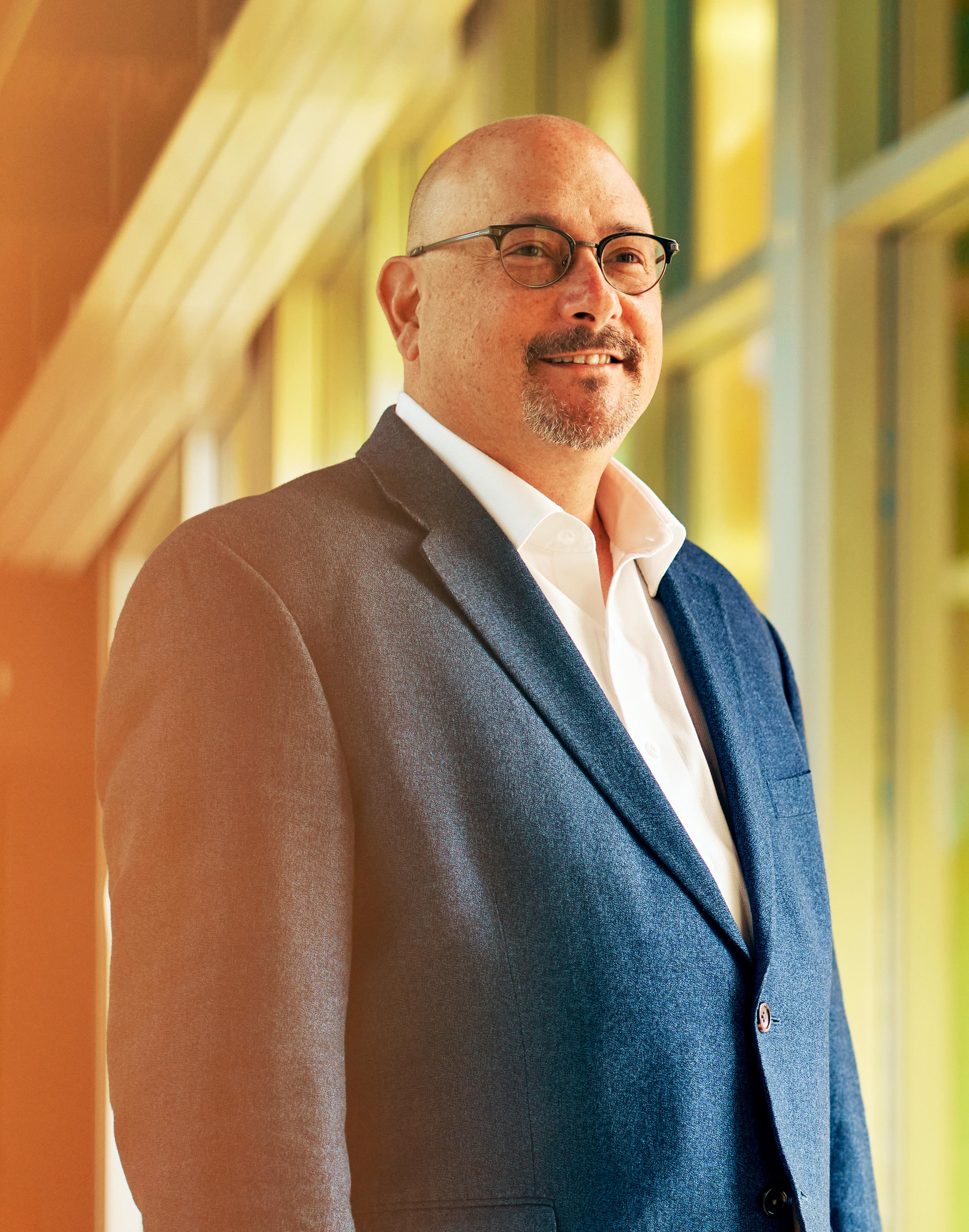
With the announcement of the Philadelphia-based Franklin Institute partnership, the most popular name in crayons continues to prove that its brand integrity exceeds far outside the lines.
Crayola IDEAworks: The Creativity Exhibition—opening in February 2021—is the latest evolution for Crayola, whose current Crayola Experience children’s discovery centers have allowed young visitors immersive opportunities to explore their creativity.

This partnership, which will travel to other museums and learning institutions across the country, takes open-ended cre-
ativity to another level, applying it to design, innovation, and invention.
RFID wristbands will accompany visitors on their journey through raining colors, bright lights, and design-centered innovation stations, helping shape an individualized creative profile for its wearer. Problem-solving opportunities are everywhere, and visitors are challenged first to identify the problem, even before brainstorming solutions.
The truth is that this singular experience could constitute the entirety of this article. But this partnership is just one of dozens undertaken by Vice President of Business Development and Global Licensing Warren Schorr, who, during his forty-minute interview with
Profile, traversed the Crayola headquarters to send pictures of new licensed products (digging through boxes while somehow staying on the line), walked his interviewer through Google Image searches of Crayola’s masterful wade into new markets, and provided a compelling and visionary product strategy.
The VP is quick to point out that his purview includes neither crayons nor markers, which from the outset may seem like working at Nike but steering clear of shoes. But this is precisely why Schorr has been so effective in his role. His job is to take a brand name known primarily for its connection to art
supply boxes and school bells and bridge the gap with consumers who will continue to love and trust the reliable brand in any number of new markets.
“It is critical in licensing to be able to communicate a clear vision and strategy, but another piece of that is how one pivots and alters strategy based on external stimuli.” On March 16, 2020, Schorr called his president with a prediction that his strategy for the year would be changing imminently. The onset of the COVID-19 pandemic would require an unprecedented pivot for Crayola.
The results from Schorr and his team would make People Magazine, the New York Times, and Good Housekeeping, just to name a few. Crayola quickly launched a barrage of health and wellness products, including branded hand sanitizer, face shields, desk partitions, and, of course, masks. A key partnership was launched with SchoolMaskPack.com to create a Crayola-branded, direct-to-consumer mask solution for parents and kids. The initiative and the products garnered a billion impressions.
“Everyone started looking at the innovation, technology, and consumer solution that was incorporated into the masks,” Schorr
says. “Suddenly all the retailers, who had already completed their buys for the Back to School season, were seeing the press and opened themselves back up to buys.”
Ultimately, Crayola wound up back in brick-and-mortar retailers by going directly to the consumer. “I think that knowing when, and how fast, to pivot a strategy is critical,” Schorr adds.
If you didn’t see it live, you should Google “Crayola + Bloomingdale’s.” The resulting images include brilliantly colored dresses by renowned fashion designers and window displays of dresses crafted entirely out of Crayola crayons. The Bloomingdale’s partnership was Crayola’s first serious fashion initiative and set up the brand’s excursion into consumer markets that only seem like left turns if you’re not Schorr.
The Bloomingdale’s campaign was a partnership with both the retailer and twelve fashion designers. The campaign was then followed by a Clinique partnership to relaunch their Chubby Stick at all of the cosmetic company’s retail counters around the world.
“People think of Crayola as a young brand, primarily for kids, but our relationship is with parents of all ages.”
WARREN SCHORRPoint your cell phone camera at the QR code to be directed to the online article.


“That campaign generated a billion impressions in the first month,” Schorr remembers. “Clinique wanted to relaunch their Chubby Stick, and we realized we could leverage not just our color equity but our relationship with moms. Most people think of Crayola as a young brand, primarily for kids, but our relationship is with parents of all ages.”
In fact, according to Smarty Pants’s 2020 Brand Love survey of 311 brands, three of the top five brands among parents are streaming providers. Of the remaining two, one is Hershey’s and the other is Crayola. “That’s because for 117 years, we’ve helped parents and teachers raise creatively alive kids,” he explains.
The partnership with Clinique led to an almost two-year collaboration with Sally Hansen, which ultimately led Crayola to launch its own line of Crayola Beauty branded cosmetics in partnership with ASOS, Sephora in Europe, and, most recently, in their own e-commerce store on Amazon.








“We validated the brand in fashion, validated the brand in cosmetics, migrated from collaborations to our own brand, and most recently moved from traditional yellow and green Crayola branding into trend-right packaging that appeals to adults and just looks
cool to anyone,” Schorr says of the brand’s ability to nimbly evolve.



So how does brand licensing compare to the large studio-based programs? “Studios focus first on entertainment and how you experience the media content,” he explains. “Secondly, they try to get a product on the retail floor, and, if possible, look to leverage that content in either a theme park or an attraction. The goal is to surround the consumer with the brand.
“We do the same thing, but we start with our products as the centerpiece and now have evolved into branded experiences,” he continues. “You might say we are just doing it in reverse order.”
When asked to clarify where Crayola would go next, Schorr laughs. His response is the same question a child might encounter at the Crayola IDEAworks exhibition: “Where do you think we should go?”
“For 117 years, we’ve helped parents and teachers raise creatively alive kids.”
WARREN SCHORR
The end of Nexstar Media Group’s 2019 marked the close of another major chapter in the company’s growth. With its nearly $7 billion acquisition of Tribune Media Company, Nexstar added more than twenty million viewers to become the largest US television company.
The acquisition plan also included a number of divestitures to comply with Federal Communications Commission (FCC) regulations. It was a deal that made headlines and was reviewed under considerable FCC scrutiny before being greenlit. And in the middle of it all was Elizabeth Ryder, who still isn’t sure just how she wound
 Elizabeth Ryder
EVP and General Counsel
Nexstar Media Group Inc.
Elizabeth Ryder
EVP and General Counsel
Nexstar Media Group Inc.
hroughout her career, Elizabeth Ryder has cared about community. As Nexstar Media Group’s top in-house lawyer, she harnesses her extensive knowledge of media and communications law to bring valuable local programming to communities across the country.

In addition to her role as trusted counselor, Elizabeth is a leader we admire. Blending creativity and insight, she is shepherding Nexstar through a period of enormous growth, all while inspiring those around her.
Elizabeth, your friends at Selendy & Gay congratulate you on this recognition and salute the innovative leadership you bring to Nexstar.
We look forward to many more years of collaboration.
www.selendygay.com
Selendy & Gay fuses values with results to disrupt the traditional law firm model.
up teeing up one of most widely discussed deals of the year.
“I started out as the sole attorney for the company,” says Ryder, who is in her eleventh year at Nexstar. “They had never had a general counsel before.” When Ryder joined, Nexstar owned or serviced 52 stations. That number now stands at 196 stations (owned or serviced) in 114 markets in 38 states.
“I remember when a lease dispute at one of our stations seemed like a complicated issue,” she says. “And now I just have to pass it off to someone else to deal with because of the magnitude of the deals we’ve been working on.”
With the integration of the Tribune Media Company, Ryder says Nexstar is focused on strategies to better monetize its new and news assets. “We’ll be in something like sixty million television households, and a lot of people in those markets also visit our websites,” Ryder explains. “So we’re doing a lot of work on how we can monetize that information and help our advertisers reach the target audience that they want.”
The Tribune acquisition has also included the addition of select attorneys from the organization integrating into the Nexstar legal team. “They’ve been an invaluable addition and have brought a plethora of experiences with the stations,” Ryder says.
“Their working knowledge of the broadcast industry really helps balance the workload here and keep us all sane.”
During her own twenty-four years of practice, Ryder has evolved from an attorney who was only casually aware of FCC rules and regulations to one who understood the nuts and bolts of the organization’s operating procedures at the most formative levels.
The legal department has established core principles and policies—such as the legalities of marijuana advertising in certain markets, sports gambling, and the litany of FCC compliance obligations—and made those widely available.
“The answer to FCC questions doesn’t change whether you’re in Sacramento, California, or Panama City, Florida,” Ryder says. “Having access to those materials via the company intranet makes it so people don’t have to necessarily wait for an answer from the legal department. That standardization is probably one of the best things we ever decided to do.”
Those standards and best practices were thrown a considerable curve ball by COVID-19. While Ryder’s legal team was able to transition into working from home with relative ease, Nexstar’s operation with essential designation in thirty-eight
“Letting my staff do their work without interfering is one of the hardest things I’ve ever had to do. But I have hired good people who I trust to do their jobs. And we’ve gotten so big that I just need to trust and not worry so much.”
ELIZABETH RYDER
states does make for some extremely tricky operational considerations. “It’s been very different state by state,” Ryder explains in her July 2020 interview. “New York took a very different approach than Texas, and it’s been important for our SVP of human resources (who also is an attorney) to keep up with all of the changes occurring in all the states we operate in.”
The pandemic hit the sports industry particularly hard and virtually wiped out stations’ broadcasts of NFL preseason football games, among others. With the continuing cancellation of entire sports seasons, a fair amount of programming ingenuity and troubleshooting will occur at stations across the country.
Ryder says in these times, especially, it’s been important for her to continue to delegate, a tough proposition for a self-described “control freak.” “Letting my staff do their work without interfering is one of the hardest things I’ve ever had to do,” Ryder admits. “But I have hired good people who I trust to do their jobs. And we’ve gotten so big that I just need to trust and not worry so much.”
Her husband noticed that outside of the office, Ryder seemed much less worry prone when they would take vacations that included relaxing near the water. He took
it so much to heart that upon returning home from a trip, they bought a small boat so she can “be the much sunnier version of myself.”
Ryder still expresses wonder at what she’s helped Nexstar accomplish in just a single year, let alone the last eleven. “This has been an incredible ride, and I feel very fortunate and blessed,” Ryder says. “I had a different career before I even decided to go to law school, so it’s just kind of a wonder to find myself in the middle of a multibillion-dollar transaction.”

Ryder’s accomplishments don’t go unnoticed by external partners. “As Nexstar Media Group’s top in-house lawyer, Elizabeth has guided the company through a period defined by remarkable growth and innovation,” says Jennifer Selendy, managing partner at Selendy & Gay. “Fusing deep industry expertise and strong, practical decision-making, Elizabeth is leading Nexstar to new heights.”
While the staggering acquisition of the past year prevents Nexstar from purchasing any more television stations in the near future, per FCC rules, Ryder says the company’s already mammoth portfolio offers endless opportunities for new challenges and new audiences in the ever-changing media landscape.
“The answer to FCC questions doesn’t change whether you’re in Sacramento, California, or Panama City, Florida.”
ELIZABETH RYDER
As vice president of finance at Dominion Energy, Prabir Purohit has been an ace for the Richmond, Virginia–based company.
go,” he explains. “Mirant, a power producer, went under and emerged from bankruptcy, so I thought it was time to look for other opportunities. I went to business school, and I found a job in the financial industry.”
By KEITH LORIABorn and raised in India, Purohit studied aerospace engineering at the Indian Institute of Technology. He received his master’s in the same subject from Iowa State University and later earned an MBA from Emory University with a concentration in finance. Early career successes included working as director of investment banking at Bank of America and senior analyst at power company Mirant Corporation.
“As a foreign person trying to find a job, aerospace is not the best option, so the power industry seemed like one of the places I could
While at Bank of America, Purohit was introduced to his current boss, and his impressive background within the finance and engineering space made him a perfect fit for Dominion Energy. He was immediately placed on the company’s mergers and acquisitions team. “I was happy to join a team at Dominion Energy that was talented and growth oriented while having a strong focus on company values,” he says.
“For a while, I was also responsible for the financial analysis group,” he continues. “M&A is more externally focused, looking at
As vice president of finance, Prabir Purohit has led fruitful M&A transactions to transform and grow Dominion Energy

strategy and growth. The financial analysis group evaluates organic growth projects. These projects need to go through a thorough financial and business risk analysis before they are approved.”
Currently, Purohit manages M&A and the treasury function, which involves all of Dominion Energy’s capital markets activity and all cash management—processing invoices, managing accounts, and moving cash around. One of the company’s most notable M&A deals was the 2019 acquisition of SCANA, which expanded Dominion Energy’s operations in Georgia and the Carolinas.
“We started working on that as part small team within the company as soon as I got here in 2016. SCANA was the only small utility on the entire East Coast,” he explains. “Besides the size, the attractive part was that its operations were in an area of South Carolina that was seeing significant customer and demand growth.”
SCANA was building a new nuclear plant at the time—something no one in the US had done for more than three decades. The amount of capital it was planning to spend on the project was approximately $10 billion—a good proportion of the value of the company itself. Its contractor on the project, Westinghouse, filed for bankruptcy protection, which added significant uncertainty to SCANA’s balance sheet and valuation.
“They ended up abandoning the nuclear plants, and their stock price traded down amid political and regulatory concerns,” Purohit recounts. “Our approach to that was if we can somehow resolve the political and regulatory concerns about the nuclear plant, we can successfully merge with SCANA— their service territory and customers.”
Dominion Energy was able to resolve the concerns, and Purohit and the Dominion Energy team negotiated a winning deal,
“Since I’ve been here, we have monetized pretty much all our businesses that are not contracted and exposed to movements in commodity prices, gas prices, and oil prices.”
PRABIR PUROHIT
McGuireWoods knows only a collaboration of bright minds and different viewpoints can create the innovative solutions our clients need in today’s marketplace.
We congratulate Prabir Purohit for his leadership and impactful organizational growth as Vice President of Finance at Dominion Energy. We value our partnership.

merging with the utility. That was a win for shareholders and customers throughout South Carolina.
What Purohit has learned dealing with M&A transactions for an investor-owned public utilities company is that it’s not the same as it would be for any other company. It’s not just the board you’re dealing with, but also the regulators and customers who are important stakeholders of any utility.
“One of the benefits of how we approached it with SCANA is we proposed a customer benefit package for the regulators before we had a deal with the board,” he explains. “That was the difference that helped us get the deal done, because no one else had a plan for the regulators and customers.”
Another big achievement of Purohit is boosting Dominion Energy’s credit. When he first showed up on the job, Dominion’s credit profile was lagging somewhat with agencies because its credit indicators were below the expected threshold.
“One thing we, in the treasury and M&A team, focused on was to improve credit,” he
shares. “Since I’ve been here, we have monetized pretty much all our businesses that are not contracted and exposed to movements in commodity prices, gas prices, and oil prices. Although these businesses are profitable, they are not viewed by agencies as being credit friendly.”
That included the sale of the Fairless Power Station in Pennsylvania and the Manchester Street Power Station in Providence, Rhode Island, as part of a $1.2 billion sale to Starwood Energy Group. That same year, Dominion Energy also sold its share in Blue Racer Midstream, a joint venture formed in 2012 with Caiman Energy to own, operate, develop, and acquire midstream assets in the Utica Shale and certain adjacent areas in the Marcellus Shale. That brought in another $1.5 billion.
“This July [2020], we announced a deal with Warren Buffet’s Berkshire Hathaway Energy. We’re selling our entire gas pipeline business,” Purohit says, adding that the deal, factoring in debt, totals about $10 billion.
“Truist Securities is proud to support Dominion Energy and its leadership in
providing innovative clean energy solutions, renewable power, and environmental stewardship to customers and stakeholders,” says David Smith, managing director of energy investment banking at Truist Securities. “We congratulate the Dominion Energy team for this recognition.”
But Purohit isn’t only about work. He’s also a huge tennis nut, playing with his local tennis club and rooting for his professional favorites at the US Open for the past twelve years, missing only this year because of the COVID-19 pandemic.
Looking ahead, Purohit notes that times are changing as investors are getting more interested in ESG (environmental, social, and governance) initiatives across all sectors. That will lead to a transformation in the utility industry.
“One of our goals within Dominion Energy is trying to transform the company to adapt more to that type of environment. That could mean technology, more renewables, electric vehicles, etc. We need to be ready for what’s coming in the future,” he says.
“One of the benefits of how we approached it with SCANA is we proposed a customer benefit package for the regulators before we had a deal with the board.”
PRABIR PUROHIT
“We’re a people business. We have to constantly focus on engaging our people to fix our systems.” It’s an axiom that Pam Teufel brings into her work every day as chief human resources officer of New Brunswick, New Jersey–based Saint Peter’s Healthcare System. Given the challenges that the healthcare industry has faced both before and during the COVID-19 pandemic, she’s especially diligent when it comes to meeting the needs of personnel.
Teufel didn’t intend to go into the field of HR. Initially, she started her career as the evening anchor for an all-news, AM radio station, getting her communications degree from Ithaca College. But it wasn’t long before
a manager at her part-time job recognized her interpersonal skills and recruited her into human resources at Wegmans Food Markets. Within three years, she had taken on a new HR challenge and gained labor union experience during her time at diagnostics company LabCorp.
One of her clearest memories is when LabCorp acquired Unilab, which meant inheriting a partially unionized workforce. As soon as the deal closed, a group of cytotechnologists and medical technologists filed a petition to join the existing union. Teufel recalls spending sixteen weeks flying from San Diego to Seattle to ensure employees really understood what it would mean to join a union. What she quickly realized was that, rather than just fighting for more

money, the employees had some legitimate complaints about their work environment to address: inadequate processes and malfunctioning systems made it difficult to get their jobs done.
“I think my biggest lesson there was that people want to do good work. Challenging work is rewarding. A challenging workplace is a problem,” Teufel admits. With the lab director’s help, those systems were slowly fixed, and the employees ultimately voted not to join the union.
Because Teufel had built such a strong relationship with the Seattle lab employees, the staff ultimately filed their own decertification petition and left the union. A major component of her HR work—and with unions in particular—is to sit down with employees directly, hear their concerns, and fix the systems they need to do their jobs. “Unfortunately, sometimes when you get in a union environment, it becomes us against them,” Teufel explains.
The truth is that labor negotiations often involve creating a better work environment—a top priority for Teufel. In Teufel’s career, she has won three decertification elections and defeated several union organizing attempts. The largest decertification was of the California Nurses Association while working at Scripps Health in Encinitas, California. That same year, Scripps landed on Fortune’s Top 100 Places to Work List.
To that end, Teufel’s job—and, she argues, the job of management in general— is to figure out how to streamline the business system for everyone. “Working as a manager is a privilege, not a right. If you’re not focused on continual systematic improvement, you’re missing an essential management competency,” she explains.
Threading the needle between best practices and securing a strong, ethically minded corporate culture is no easy feat. “One overused phrase in healthcare that I despise is ‘Well, their clinical skills are really good, but their people skills are terrible,’” Teufel says. As such, in the past, health systems would tolerate physicians who brought
in revenue but didn’t work well within the organization.
At Saint Peter’s, Teufel prides herself on not standing for that kind of uneven hiring. “Your clinical skills are the minimum qualification for the job,” she stresses. “We expect professionalism and for every employee to live up to our service standards.
“If you openly harass your coworker, you can’t work here,” Teufel adds. “Even if you have the best clinical skills in the business.”
In addition to maintaining high standards for personnel, Teufel spearheaded a total technology transformation, including HR4U, a centralized service center for any employee to reach HR, and Cornerstone talent management, which provides a seamless experience from onboarding to succession planning.
Teufel has also redesigned Saint Peter’s total rewards strategy. “I had an employee that was here for twenty years making $14 an hour,” she admits. “That’s the type of stuff that makes you want to cry.” Teufel convinced the CEO and CFO to move the minimum pay to $15 an hour in 2019 and auto-enrolled everyone in their 401(k) plan, with nearly 98 percent of employees contributing. “You work your whole career
in healthcare, you deserve to retire,” she asserts. And these efforts help Saint Peter’s employees get closer to that goal.
“I’m an extremely principled person,” says Teufel, who acknowledges that this can frustrate colleagues for whom the ends justify the means. “But it also helps me stand up and be that voice when other people may be intimidated.” That voice has allowed her to make significant changes for the better at Saint Peter’s, whether it’s employee compensation, engagement, or ensuring the company’s values and virtues stay in practice.
Teufel's advice for other healthcare HR leaders navigating similar struggles? “Go with what works for all of us—stay true to your core values, communicate and follow through, and recognize employees for who they are—your most valuable resource.”

“I think my biggest lesson there was that people want to do good work. Challenging work is rewarding. A challenging workplace is a problem.”
PAM TEUFEL
Some managers might enjoy taking a tough approach with their team, but for Nuverra Environmental Solutions Chief Information Officer Greg Tipton, that’s just not his style. “I’m really laid back,” he says. “My team does a great job of knowing what needs to get done. I just provide direction, and they take it from there.”
Indeed, trust is a major theme in Tipton’s professional life at Nuverra. With the leadership team’s support, Tipton has taken several steps, including the incorporation of blockchain technology, to ensure the company is as transparent as possible with customers.
Tipton joined Nuverra in December 2013 after twenty-three years at Motorola. He was recruited by Larry Strohmaier, an old friend and former Motorola colleague who was Nuverra’s CIO at the time. Nuverra was
in need of major technology solutions, as the company had email delivery issues and needed an electronic ticketing solution, just to name two challenges. Strohmaier also promised his Chicago-based friend something else at the Scottsdale, Arizona-based company: a warmer climate.
Tipton notes that shifting from a processoriented company such as Motorola to the oil field services industry was a bit like entering the Wild West, but he was equipped with deep knowledge and best practices.
“I ended up reverting back to some fundamental ideas that were taught at Motorola such as change management, ticketing, access approval, system monitoring, uptime availability, creating standards, and virtualizing servers,” he says. “Things that are second nature to me coming from Motorola are things that this industry didn’t necessarily grasp.”
How
Fortunately, Tipton had the full support of the Nuverra leadership team, which was eager to take steps that would differentiate the company from industry competition. Tipton led the charge in converting a paperdependent company into a digitally savvy one with improved processes, reduced payment cycle times, and other improvements.
Additionally, Tipton helped lead the incorporation of LiquidFrameworks’ FieldFX, a Salesforce application that digitized Nuverra’s paper process and further strengthened the company’s position in the marketplace.
“We chose FieldFX because it sat on the Salesforce platform and removed much of the paper out of our process,” he says. The implementation took about eighteen months and gave Nuverra the ability to share data with its customers.
“Being able to do this gives us a huge advantage. Some of our competition has already done this, but many of the smaller companies have not. Because they haven’t moved to a paperless process, they have to throw people at what their customers are asking them to do. We can just build an inte -
Greg Tipton CIO Nuverra Environmental Solutions
gration and pass data back and forth without adding headcount.”
LiquidFrameworks’ Travis Parigi notes the great partnership the company has had with Nuverra and Tipton. “Greg has been tremendously proactive about embracing technology in an industry that can be archaic in its processes,” says Parigi, CEO and founder of LiquidFrameworks. “He is unquestionably a technology leader.”
In addition to providing electronic ticketing solutions, Tipton is especially proud of his role in helping Nuverra embrace blockchain technology, which he says reduces cycle time for invoicing and allows Nuverra’s data to be automatically validated using customer data for improved invoicing cycle time.
“When these oil fields are discovered, there’s a lot of money involved,” Tipton says. “There’s a lot of money being spent, and some companies (including haulers) take advantage of the situation. Since we are considered a hauling company, our data is scrutinized, which creates delays in our invoicing process.
“I’m always looking at new ways to do things easier and better. You have to embrace technology to take advantage of it.”
GREG TIPTON
“Many haulers, including Nuverra, are paid on commission, so depending on how many barrels the driver pulls from the tanks, the driver will be paid [a different amount],” he continues. “This creates a possibility that an unethical competitor could pad their numbers. But by using technology, we are able to validate our numbers and build trust with our customers by being transparent with our data.”

As a lifelong lover of technology, Tipton strongly believes in utilizing technology to the best advantage. He fondly recalls playing text-based games on the Osborne computer his father brought home in the early 1980s, and admits that he’s been one of those people standing in line outside of his local Apple store.
“I’m always looking at new ways to do things easier and better,” he says. “You have to embrace technology to take advantage of it. There are a lot of folks
who believe in having hardware on-site and having a physical phone line to your desk, but things like that make it tough to manage IT on reduced budgets. The second you start virtualizing servers and moving folks to a new infrastructure, it makes things much easier and allows you to run things smoother, especially from a resource standpoint.”
He also remains grateful for the backing of the Nuverra leadership team.
“My management team embraces change, even though a lot of the drivers and folks that are working at the yard level don’t necessarily like change,” he says. “They support what I’m doing, which is really nice. The technology is amazing, and the oil field definitely needs the technology in place to do what our customers are asking us to do.”
 Courtesy of Nuverra Environmental Solutions
Courtesy of Nuverra Environmental Solutions
When Hassan Asghar joined Bremer Bank in 2017, he was assigned the task of building a security program from the ground up and contributing to the leadership team. While he has made great progress in his nearly four years there, Asghar says the work he and his team do is never done.
“I can never feel at ease,” he states. “We’re still constantly learning and evolving, and 2020 has been a weird year with more remote work because of COVID.”
These challenging times have seen Asghar and his team do some of their finest work.
“Even during the pandemic, we didn’t see any disruptions or significant impacts
on our environment. Being able to get that all done while keeping everything secure, while also progressing with our digital transformation efforts that we’re working on was, I thought, really impressive,” Asghar explains.
That success is a testament to Asghar’s leadership and his staff.
“You can’t be successful without a strong team, so having all the right people, including the ones we onboarded from outside, was important,” he notes. “And then there’s partnering with our IT counterparts, with our risk management, operations, communications, and others so that everybody gets what we’re trying to do and we’re all on the same page.”

As Bremer Bank’s SVP and CISO, Hassan Asghar makes sure he and his team are always ready for the next challenge that may come their way
He adds that the diversity within his team is vital to its success. His group, which is almost evenly split between men and women, includes people who come from different nations, speak various languages, and bring a variety of skill sets to the table.
“It’s a team of people from all kinds of backgrounds and all kinds of experiences, from really seasoned security professionals to interns who converted to full-time employees,” Asghar states. “I strongly believe in getting different perspectives, and we make sure that everybody is heard.”
Asghar was born in Pakistan and came to the United States on a student visa, graduating from Luther College in 2005. He began his career at Deloitte and worked in the IT

risk and audit space, where he developed an interest in technology implementation and cybersecurity. Then he worked for MoneyGram, where he learned about IT audits and became the IT audit manager while also consulting the security team.
That led to his job at Optum, part of UnitedHealth Group, where he oversaw IT risk and the compliance function. He was extremely happy with the opportunity and the team he built at the company, and he was nominated to and successfully completed UnitedHealth Group’s Executive Development Program.
“It was a really, really good experience, just a great company and a very well-run organization,” Asghar says. “I didn’t think
Hassan Asghar SVP and CISO Bremer BankWhen Hassan Asghar came to America from Karachi, Pakistan, he had about $120 in his pocket.
“I came here on a student visa,” he remembers. “My first semester, there was a tuition fee of about $6,000 which I brought as a cashier’s check, but the rest was something I had to figure out.”
He managed to pay for school through loans and multiple jobs, and after graduating, he started working at Deloitte, which sponsored his H-1 visa application. After being on an H-1 visa and continuous progression in his career, his next employer, MoneyGram International, sponsored his green card. After eighteen years of being on multiple visas and a green card, he became a US citizen in January 2019.
“I’m grateful for having the opportunity,” Asghar explains. “I feel I was lucky to be in a good position and have good support. My parents and family, colleagues, mentors, and friends always encouraged me, and I never lost sight of my goals and my desire to continue to get better.”
I was going to leave. Then the opportunity at Bremer was presented, and after meeting the Bremer executive team and learning more about Bremer’s purpose, values, and involvement in the community, I finally decided to make the move.”
Throughout his career, Asghar has developed an effective approach to leadership that is focused largely on streamlining processes and being customer centric.

“Number one, I would say I love to make things simple; I don’t want to overcomplicate things,” he confirms. “Any time we can simplify, that is something I cater towards. I always care about whoever at the end of our day is our customer. If our customer is an internal partner or an external partner, we
want to make sure that we are doing what it takes to meet their needs.”


He also relies on his team and encourages them to continue growing and learning.

“These folks are extremely smart,” Asghar states. “I want them to stay curious. I want the teams to not just listen to what others have to say and say yes if they don’t believe it. I want to hear their perspectives and use that as a tool to better meet our business and customer needs. This industry is always changing, and we can never be static, so we have to make sure that we’re adaptive and agile.”
That approach has made Asghar and his staff ready for any challenge that comes their way.

“I want to hear their perspective and use that as a tool to better meet our business and customer needs. This industry is always changing, and we can never be static, so we have to make sure that we’re adaptive and agile.”
HASSAN ASGHAR
Being practical sets lawyers apart from the pack, Mary McCann says. She knows that lawyers must be smart, creative, and analytical, but in looking back on her career journey, she says that focusing on being practical truly prepared her for an in-house position as head of litigation and a member of the legal leadership team at S&P Global. She learned this practicality during a nine-year tenure with the firm Cahill Gordon after graduation from St. John’s University School of Law. While she relished the position, McCann knew that her long-term goals did not include making partner. Rather, she felt she would eventually serve in-house and
 Mary McCann
Associate General Counsel and Head of Litigation
S&P Global
Mary McCann
Associate General Counsel and Head of Litigation
S&P Global
It is Weil’s honor to collaborate with Mary McCann and the S&P Global legal team to optimize outcomes in the face of complex legal issues. Innovative solutions. Entrepreneurial spirit.
Strategic business partners.

wanted to have outside experience to draw on. “I didn’t want to be in court every day,” she explains. “I enjoy the strategic aspect of litigation and advising internal clients on litigation and regulatory risk.” Being in house, McCann says, allows you to be proactive instead of reactive when assessing litigation risks. This long-term plan certainly did not stop her, she adds, from doing her all for Cahill and their clients.
Her plan paid off and her efforts forged her into a better lawyer. “If you work hard and make relationships,” she says, “those relationships can help you get to the next place.” McCann’s supervisors, impressed with her work, facilitated a secondment at Deutsche Bank, where she tested her goal of working in-house. Colleagues at Cahill then put in many good words about her skill and commitment when she applied for a S&P role in 2014.
“Since her time at Cahill, we have observed firsthand how Mary’s abilities both to connect with the people she advises and to offer sound and practical legal advice have made her invaluable to S&P Global,” says Tammy Roy, partner at Cahill Gordon & Reindel.
McCann began working mostly with the ratings division and now applies that knowledge, as well as her practicality, to her current role as head of litigation globally. “You have to make arguments around sustainability for the business,” she says. Though you might have a strong legal argument, she explains, it’s critical to analyze reputation, risk, and financial impact. “Sometimes the law is very clear. When it is less clear, a good lawyer needs to guide management on what’s best for the business while abiding by the rules.”
Litigation for S&P means, among other duties, a great deal of risk and regulatory navigation. Though McCann knew she wanted to practice law, landing in the financial sector was more happenstance. However, once there, she discovered an interest in the regulatory aspect of the field, specifically the breadth of interpretation. “Regulation has a huge impact on business,” she says and holds up duties such as helping to prepare for annual regulatory reviews as situations that stretch her knowledge and skills.
Such preparation is hardly her only opportunity to advise around regulation and litigation risk. Looking down her calendar
from an individual day, McCann recites a breathtaking index of activities: conversations with auditors, outside counsel, lawyers from other divisions, and officers, along with case law research, analysis of other institutions’ litigation, and other general work on litigation matters. And no two days are alike.
McCann forms close relationships with S&P division lawyers who provide her with the expertise around business and business priorities. With this, McCann can offer better guidance and talk through various risk possibilities.
McCann describes the team at S&P as “smart and compassionate.” Not a traditional financial institution, the company includes regulated and unregulated business and, though it has a lot of name recognition, is relatively small. This, McCann says, means the company feels “very collegial and very people oriented, with a focus on maintaining and managing talent.” From where she sits, she sees that they take compliance and legal advice seriously, a cultural norm that makes her job easier.
S&P’s tight-knit culture has really shone through during the changes brought on by COVID-19. S&P management was leading
“Sometimes the law is very clear. When it is less clear, a good lawyer needs to guide management on what’s best for the business while abiding by the rules.”
MARY MCCANN
town halls to focus on employee questions. Along with big-picture concerns, employees will ask the head of the people function and other members of upper management about things like buying ergonomic office chairs for their home and the issues are given weight, she says, showing that management understands the importance of details.
For the past two years, McCann has led a lean litigation department of three. Mirroring some of the general trends in S&P’s culture, her compact team harnesses the power of clear and constant communication.
“Mary brings a special mix of smarts and practical judgment to every issue,” says Christopher Garcia, cohead of Weil, Gotshal & Manges’ white collar practice. “She couples this with a collaborative approach that, together, brings out the best in the outside lawyers with whom she works.”
As a result of the financial crisis, McCann saw rating agencies undergo public scrutiny. “They had to figure out how to withstand legal challenges on numerous fronts, including
from regulators and private plaintiffs, and I think they have come out better,” she says. This was a real moment when questions of practicality, how much to fight and when to settle, came to the forefront. Of the current financial situation, McCann steers away from comparisons to the Great Recession. “This is such a different experience,” she says. “It’s an incomparable moment.”
Through this moment, however, McCann will continue to lean on her team and the supportive S&P culture. Her career, she says, has benefited from working with great lawyers. Every expectation is that it will continue to, as well as the hard work that fosters those relationships.
“It’s rare to be in-house and to have so many different roles and experiences,” she says, considering her career. She names trust and assistance from mentors—such as her current manager, General Counsel Steve Kemps—as reasons why she has been able to advance. Probably this success also derives from that heavy helping of practicality.

David Benthal
“If you work hard and make relationships, those relationships can help you get to the next place.”
MARY MCCANN
Cahill has thrived for a century by focusing on the most significant opportunities and complex challenges facing the top financial services firms and other multinational corporations. Our premier transactional and litigation groups have developed impressive records of accomplishment in high profile cases and headline-grabbing deals. The firm is specifically chosen by clients because of our experience, depth of knowledge and facility in managing challenging situations.
Cahill is known for innovative trial strategies and financing solutions that draw on the strengths of the entire firm and reflect a wider perspective than that typically afforded by the specialized niches and micro practices that make up a large law firm. A passion for challenging and distinctive work is at the heart of our firm culture and explains why Cahill consistently wins cases and ranks among the most active firms in the financial league tables year after year.
Among our ranks are lawyers who joined Cahill following distinguished careers at federal and state agencies, including the Securities and Exchange Commission and the Department of Justice.
Cahill applauds the leadership and dedication Mary McCann brings to her role at S&P Global and is proud to join in recognizing her achievements.
 By KEITH LORIA
By KEITH LORIA
Planview CEO Gregory Gilmore knows the importance of changing with the times. With more than thirty years of experience in sales, consulting, and operations management, his résumé includes tenures at Ernst & Young, Texas Instruments, James Martin & Co, and ABT.
“I saw how the impact of process and aligning work and strategy was so impactful to organizations, and it became a life passion for me,” Gilmore shares. “Getting to see how companies dealt with their issues and problems—and how they transformed themselves—has left an indelible mark on me that I’ve brought into my career.”
He joined Austin, Texas-based Planview in 1996, attracted to the company by the vision of the company’s founder. Ever since, Gilmore has been a driving force behind Planview’s explosive growth over the past two decades, as the company pioneered the work and resource management category for enterprise software.
Now, nearly twenty-five years later, the key to Planview’s continued success? Rewiring the entire company.
“The first thing I did when I arrived here was establish the idea of value streams. One of the things I learned at Ernst was process without context is death, because you have process with no beginning, no end, and no defined outcomes,” he says. “We built a
solution-delivery value stream, a customer service value stream, and a value-based team selling (or go-to-market) value stream. Today, we’re leveraging agile management principles throughout those value streams to become more nimble and be a better journey partner for our customers as they embark on their own transformation journeys.”
Under Gilmore’s leadership, the company grew the total addressable market from $300 million to $8 billion in just two years and increased revenue from $70 million in 2013 to more than $240 million in 2019. Planview expanded its global footprint to over 700 employees serving more than 3,500 customers. He’s also led an executive team that has evolved to become more people centric.

“I believe and subscribe to the concept of servant leadership, and I think about the five tenants of servant leadership: model the way, inspire shared vision, challenge the process, enable others to act, and encourage the heart,” Gilmore explains. “For me, the most important thing we can do is be human-centric in our leadership style, putting people at the center of everything we do—whether that’s our customers, our employees, or our shareholders.”
His goal is to enable every person in the company—including his leadership team—to have the ability to lead these five principles and motivate everyone to accomplish more than they ever thought possible.
Gilmore adds that the world of work has changed in recent years due to new management and delivery methodologies,
Gregory Gilmore CEO Planview Inc.“I believe strongly that bad news doesn’t get better with age. It’s better to deal with facts and truths.”
GREGORY GILMORECourtesy of Planview Inc.
changing demographics, team-centric dynamics, and now a virtual way of doing things. During this same period, Planview invested heavily in its products, capabilities, and employees to be the best long-term partner for customers as they transform strategy to delivery.
“Not only did we shift what we deliver for our customers, but several years ago, we set out to reinvent ourselves and transform into a company that could quickly pivot to fit the evolving needs of the market and our customers,” he explains. “It’s our own agile transformation, where we have transformed and embraced a full rewire of the business, culture, measurement, performance, and our way of working.”
In his role as CEO, he feels it’s his job to set direction and strategy, allocate resources, measure results, and enable people to act.
“The one thing about the CEO chair is you have to embrace ambiguity—there’s no day that looks like the last,” Gilmore notes. “One of the mistakes a strong operational CEO can make is to actually constipate the ability of the organization to scale because others don’t feel like they are enabled to act. I take it very seriously that I need to understand my span of control. I want to set clear direction and make
sure we collectively understand the resources we are committing to that strategy.”
When the results aren’t what they need to be, that’s when it’s time to go back and transform.
“I believe strongly that bad news doesn’t get better with age. It’s better to deal with facts and truths,” Gilmore says. “My hope is that people will associate Planview with this idea of rewiring strategy to delivery. Without what we do, organizations simply can’t transform in the way that I think they need to.”
The thing he is most proud of with the transformation is that in April 2020, Planview was named a leader in Gartner Research’s Magic Quadrant for Enterprise Agile Planning Tools.
“We’re a company that has been around for thirty years, so our ability to pivot and achieve a leadership position in a critical industry analyst assessment is affirming to me,” he shares.
Reflecting on his career, Gilmore likens it to building a wall.
“Every opportunity was a brick,” he shares. “What I tell my kids and the young people I mentor is to lay the cornerstone and don’t be afraid to lay those bricks.”
“For me, the most important thing we can do is be human-centric in our leadership style, putting people at the center of what we do.”
GREGORY GILMORE
In the 1960s, a business executive and an airline salesperson get on a plane. After some conversation on their personal travel experiences, they agree there must be a better way to coordinate things to help improve the travel experience. And thus, Sabre Corporation was created from a partnership between IBM and American Airlines—a tech company that’s in the business of travel. Yvonne Freeman takes a similar approach as Sabre’s vice president of global total rewards and people, systems, and operations: she is an HR exec in the business of helping customers.
Freeman sees team members as her customers. “HR should market their company’s offerings to their customers and then must deliver or people will not continue to shop,” she explains. In her design models for great
workplaces, Freeman considers how people make purchasing choices based on preferences and proven value. Time is currency, and she helps create an environment where team members will want to spend their time.
Twenty-five years ago, HR was mostly seen as an administrative function, Freeman explains. Now she sees the role of her department as figuring out how to motivate and incentivize Sabre team members to give their best in return for a great team member experience. “We care about our team members experience and want to help support them in their life and their work,” she says.
Early in her career, Freeman learned through mentorship that “that HR program designs and communications must have balance,” she says. A balance of art and science are key to her vision. With intentionally balanced art and design—considering what team members ask for, competitive practices, financial
VP Yvonne Freeman champions a customer mindset to continually serve and market to Sabre team members across the globe
implications, and fit within a company’s existing portfolio of offerings, as well as creating a great team member experience—what HR creates and offers will resonate with everyone.
“You have to put it all together, stir it up, and put together something that makes sense to all stakeholders, including your customer base,” she says. Solutions need to consider the interests of team members, the company, and shareholders. “Most of what HR does is based on logic and common sense.”
Championing a balance of both reactive and proactive responses is another foundational lesson in Freeman’s career. Importantly, she insists on HR designing out in the open, with input and collaboration from across the organization. “I approach things by taking people along in the journey,”
Freeman says. “I like to connect with others and think holistically.” Freeman honed this wide lens and strategic thinking throughout her career growth from an individual contributor to executive across different industries.

Parsing her time, Freeman spends much of it leading and supporting, both with her team and throughout the company. To do this, she is constantly striving to innovate and improve things, seeking out and removing pain points, improving processes and offerings, and coaching and helping others overcome obstacles and think differently. For Freeman leadership is, again, a fine balance, one of motivation, prioritization, feedback, and leading by example.
Freeman’s six direct reports oversee sixty team members working around the world.
Building this team, Freeman attracts “people who like challenge.” She explains, “anybody can tell you that you can’t do something. The key is to figure out how we can.” The individuals who can adopt that mindset and deliver are the ones she seeks to join her team.
In her year and a half at Sabre, Freeman has helped influence HR to “show up like a tech company,” she says, as they evaluate the constant attract-motivate-retain cycle. “We have got to know our employee base, how to speak to the base,” she says. The HR exec looks to create an experience and relies on four Cs to do so: compete, control costs, comply, and communicate. Within her team, she also adds a fifth C: camaraderie. Partnering with companies like Workhuman, Freeman helps bring programs like a global
“Anybody can tell you that you can’t do something. The key is to figure out how we can.”
YVONNE FREEMAN
Yvonne Freeman VP of Global Total Rewards & People, Systems, and Operations Sabre Corporation
recognition program to life to help connect team members around the world and celebrate accomplishments.
In the face of the COVID-19 pandemic, Sabre finds itself in an interesting position. While they impact travelers a great deal— likely anyone who has ever booked an airline ticket or made a hotel reservation around the world has come into contact with Sabre technology—the company is not totally end-user facing. In this moment, Freeman and Sabre have embraced the moment of the crisis as a “liberation of flexibility.” Ideas that had previously started to gain ground, like workfrom-anywhere, have accelerated.

Freeman also continues critical transformations around transparency. Laying out agendas and possibilities, she knows it is important to be open and vulnerable. “Great ideas can come from anyone, anywhere,’” she says. She understood early on that many of her team members weren’t used to leadership asking for input and opinions. Culture change requires another delicate balance.
Both Sabre and Freeman value giving back to the community. The company offers every team member one paid day off to volunteer each quarter. Freeman spends her volunteer time serving on the Neuro Assistance Foundation board and is also dedicated to Carry the Load. “What you learn is that it’s not about you,” she says.
This humility also sits at the center of her HR ethos, one that has been essential when leading through a global crisis. “As the travel landscape evolves,” she says, “we shape that future.”
When Mike Dodson was approached to become CFO of tech company Quantum, he had no idea of the experience he would be in for.
The finance department was in shambles, the company had covenant compliance and liquidity issues with the lenders, and was in the midst of a massive Securities and Exchange Commission (SEC) investigation resulting in a multiyear financial restatement. “It was a wilder ride than I could have ever imagined,” he says.
Luckily for Quantum, Dodson had built up a reputation as a problem-solver. Two years later, Quantum is in better shape than ever—restructured, resized, and back to productivity.
Problem-solving has been a fixture in Dodson’s career. For a decade before he joined Quantum, Dodson moved from one CFO role to another across several big tech companies. Each place had their own set of obstacles to overcome, from IPOs to restructurings to SEC investigations. “I seem to gravitate towards challenges,” he muses.
Then, in 2018, he was approached by one of Quantum’s board members and—at the time—the biggest shareholder, Eric Singer, to consider the CFO job at the company. “We had worked together in the past, and he knew my background and that it matched up well with the challenges at Quantum,” Dodson notes.
After discussions with the board members and the then-CEO, Dodson understood the difficulties of the job but also recognized Quantum’s potential. “I don’t know why I’m
drawn to these challenges,” Dodson says. “It’s like you’re standing in front of Mount Everest and you just want to climb to the top—I can’t help myself.”
Of course, the mountain got higher the Sunday before he was set to start: the CEO resigned for personal reasons. The nomination committee called Dodson up and asked him to take over, an offer he accepted. On his first day, Dodson was set to pull double duty as CFO and interim CEO.
As Dodson describes it, Quantum was hanging by a thread by the time he arrived, which meant he had to act quickly to get a handle on the company’s biggest problems. One of the most crucial elements that guided him through was his close partnership with Mark Rothman, chairman of the audit committee and the board’s lead director addressing the SEC investigation and lender relationships. Dodson’s partnership with Rothman was critical in bringing him up to speed on the company’s regulatory and lending issues.
Then, he evaluated the current financial, accounting, and information technology
“It’s like you’re standing in front of Mount Everest and you just want to climb to the top—I can’t help myself.”
MIKE DODSON

leadership, which he found wanting. “They were just not very strong, for lack of a better description,” he says. So he overhauled the leadership team and brought in a chief accounting officer he’d worked with in the past—someone he knew was highly competent and pragmatic in his approach. He also brought in a new chief information officer he’d worked with in the past and an experienced head of internal audit, further solidifying the foundation for his new approach.
Each of these leaders then rebuilt their teams, almost from scratch, and set to work restating multiple years of financial statements. “It was a mountain of work,” Dodson says. The team sifted through years of accounting records representing tens of thousands of transactions to piece together the proper accounting treatment and roll up the corrected financial statements.
Another major element of Dodson’s changes was dealing with their CPA firm, a large outfit that he felt had not served the
company well before his arrival. The firm was proving to be a very expensive service provider that didn’t exhibit the willingness to be nimble and responsive to the level required to address the significant challenges the company needed to urgently address.
With strong support from the board, the company went out to bid and chose to go with a regional firm that proved to be the perfect fit, willing to “roll up their sleeves” and audit five years of financial statements from scratch in less time and at a lower cost than it would have required to proceed with the incumbent CPA firm. “Had we not replaced the incumbent CPA firm, I’m not sure we would have made it,” he admits.
It wasn’t an easy move—and went against conventional wisdom as well as how Dodson had addressed similar restatement projects in his past—but it proved to be a key factor in the successful completion of the financial restatement.
Another significant factor needed to secure the future of Quantum through this challenging period was to find the right CEO, one who would prove to be a true partner for Dodson. “If you don’t bring in the right person, you could sink the ship,” he says. Luckily, the board was able to attract a solid replacement in Jamie Lerner, an executive with more than twenty-five years of experience in executive leadership roles at tech companies like Cisco and Seagate. “Lerner exhibits boundless energy; he’s enthusiastic,” Dodson says. “He had a vision of what to do with the products and the technology that was really different than what the company had done in the past.”
Dodson prides himself on a strong partnership with Lerner, which he cites as one
of the major components of Quantum’s strong recovery from the situation Dodson walked into. “I’ve had some really good, strong relationships with CEOs over the years, but bar none the best I’ve had is with Jamie,” he says.
The core of that partnership is a strong sense of collaboration—Lerner’s the storage expert, Dodson’s the finance expert, and they each defer to the other’s areas of expertise. “He’s more enthusiastic and outgoing [than I am], but we share core values and think alike. When we look at a problem, whether I talk first or he talks first, it’s like we’re in each other’s mind,” he says.
In connection with his turnaround efforts, Dodson selected the investment banking firm Armory Securities, which helped assist Quantum in raising financing to provide much-needed flexibility. “Mike is a seasoned and talented professional with the unique skills Quantum needed,” says Eben Perison, CEO of Armory. “Over the course of a year, he was able to operate in a truly difficult situation and worked flawlessly with Jamie and the management team to achieve Herculean results.”
Compared to where the company was two years ago, Dodson feels good about where Quantum is now. In 2019, the company entered profitability for the first time in years. Now, of course, with the COVID-19 pandemic, Quantum faces the same problems every company around the world is dealing with. But with a solid, self-selected team and strong collaboration with his CEO, Dodson is optimistic about their ability to weather this new challenge.
“It was a wilder ride than I could have ever imagined.”
MIKE DODSON
Fully customized enterprise-wide software can be expensive. Instead, a common alternative relies on installing an off-theshelf platform and then altering aspects of it to conform to the particular needs of the business. It’s often a double-edged sword. Although it’s less expensive than a full-custom system, it carries its own extra price: the possibility of wiping out those carefully designed tweaks upon upgrade.
At the same time, skipping upgrades can also mean skipping new functions and efficiencies. Just consider the differences in capabilities and usefulness between your current

cell phone and the one you used in 2010, and you’ll appreciate the situation.
That’s what Envision Healthcare Corporation, which delivers physician and advanced practice provider services to more than two thousand clinical departments nationwide, faced. “Our current on-site system is about ten years old,” says Kenneth Zongor, Envision’s senior vice president and chief accounting officer. “It still executes its intended functions, but lacks the efficiencies newer technology brings to bear.” And the company faced challenges in its ability to install some routine updates because of the numerous customizations introduced over the years that could have been impacted.
But now that’s changing. After a rigorous yearlong evaluation process, the company is implementing a new cloud-based enterprise resource planning (ERP) system based on the Oracle Cloud platform.
Zongor joined AMSURG—a company that provides strategic and operational management of surgery centers and is now part of Envision—in 2010 as its vice president of financial reporting. The intricacies of his new job presented a steep learning curve that was mitigated somewhat by his own broad experience, which includes terms at Arthur Andersen, Ernst & Young, Deloitte & Touche, and Carr, Riggs & Ingram.
“As a public accountant, I was exposed to all kinds of industries. I saw how things were done across a big spectrum, and it gave me a varied perspective,” he says.
Bringing the new ERP online presents enormous challenges—in terms of both processes and people. “It’s an absolutely sweeping initiative,” Zongor says. “Every component of the admin side of our business will be touched by this.”
Envision’s old system integrated with multiple external systems, including billing, scheduling, time and attendance, and other functions. And some aspects were quite complex. “One big challenge is payroll,” Zongor says. “We have to accommodate different pay elements according to geographic location and specialty, and allow for differentials within those rates based on the shift type—for example, on-call and night shift hours.”
When the system is fully integrated, it will simplify many aspects of the business. “We see it as an application that will work across the board,” Zongor says. “In the hiring process alone, it will simplify both the recruiting and employment processes—assisting with the production and signing of contracts and also sending the relevant data
to the onboarding team, the credentialing team, and then to payroll and benefits.”
In turn, he added, clinical staff will have timely and efficient access to that information. “For example, the payroll app will let you use a chatbot to answer questions, and it’ll be easier to change your withholding or benefit deductions,” Zongor says. “And practice managers will be able to receive more timely updates on procedure volume to assist them in managing their current and projected clinician staffing.”
In addition, he notes, the new ERP will eliminate a significant amount of manual input, which will mitigate the chance of human error. “We want our clinicians to be confident that the administrative function of each practice is operating efficiently and delivering accurate data to manage the business,” he explains, “so they can concentrate on patient care.”
And while the new ERP will allow Envision to incorporate the platform’s incremental improvements, “we now must adapt our data delivery methods to accom-
modate the software,” he says. “It’s going to drive change across the entire organization, and people don’t always accept change right away.”
As he guides his own 350-person staff into the new system, Zongor relies on a leadership philosophy he developed in high school.
“Football was my passion, and I played for a private high school,” he says. “We had only 250 students, but we were consistently ranked as a top program despite playing against much bigger schools. Nobody was a superstar, but we were disciplined. Our coach always told us, ‘You don’t have to be bigger, or hit harder. What counts is being in the right place at the right time. It doesn’t matter who you are—if you don’t play your part, the team won’t be successful.’
“I’ve carried that over to the business world,” he continues. “We have many people, but a common goal. It’s important to treat everyone, at every level, with respect and be grateful for what they do. People like to be challenged, and to feel as though they’re contributing to Envision’s success.”
“It’s important to treat everyone, at every level, with respect and be grateful for what they do. People like to be challenged, and to feel as though they’re contributing to Envision’s success.”
KENNETH ZONGOR
For the first time, the Trade Desk made its industry-leading digital advertising courseware and certification platform free of charge through the end of 2020. The learning platform, called Edge Academy, provides online training in digital and data-driven advertising, including connected TV (CTV).
“This accelerated focus on data-driven decisioning is putting immediate pressure on skills development across the advertising industry,” said founder and CEO Jeff Green in the company’s April 2020 news release. “Our revamped training platform will help meet this demand for new skills and certifications. And making these courses available at no cost will provide anyone looking to use this opportunity to break into one of the world’s
fastest-growing industries with the most contemporary skills.”
The eleven-year-old global technology company launched its Edge Academy in 2013 and prior to the revamp, more than eleven thousand professionals received certifications. A range of leading advertising agencies, brands, and universities have partnered with the Trade Desk as well. Edge Academy provides three certifications: marketing foundations, data-driven planning, and trading essentials.
“There are many different content modules that can help you learn, from the basics of how to use a buying platform all the way to the virtues of using CTV or VOD [video on demand] as a channel,” Philippa Snare, senior vice president of Europe, Middle East, and Africa, told ClickZ. “You can also learn how CTV connects with display on the traditional
Founded: 2009
Headquarters: Ventura, California
Employees: 1,300+ worldwide
Industry Accolades:
• Fortune 100 Best Medium Workplaces, three years running
• Best DSP, ClickZ MarTech Awards 2019
• Best Demand Side Technology, AdExchanger Awards
Source: The Trade Desk
We at CNM LLP believe our clients deserve all the experience and expertise of a big fir m, plus the personalized care of a more responsive team.
CNM is reshaping and transforming the way exceptional quality and client service is delivered. As we help you achieve excellent results, inspire positive change, and improve your profitibility, we’ve fulfilled our mission.
or native advertising you might already have running.”
The COVID-19 pandemic has forced many companies to pivot and think on their feet to adjust to the new normal. But the Trade Desk has always sought to build a new normal—for advertising technology.
In 2004, Green had founded and launched AdECN, which was the world’s first online ad exchange that functioned similarly to the stock market or commodities market. Microsoft acquired the company within four years, and Green left not long after. A few weeks later, he launched the Trade Desk alongside former Microsoft employee Dave Pickles, who is currently chief technology officer.
Green’s intention was to put his ideas for the future of advertising technology into practice without “the bureaucracy and internal politics,” he told Forbes contributor Amit Chowdhry in 2017. “A more transparent way of transacting business had to be established,” he explained. “The new trading floor of Internet advertising would facilitate price discovery, and liquidity, in the way the public markets had for hundreds of years. It was then that I embarked on a journey to bring this vision into reality.”
By 2016, the Trade Desk had gone public. Green told Chowdhry that he believes the
company is building a business that will be around for one hundred years. “Since the IPO, we’ve been able to scale the business more quickly than before through technology and global expansion. I’ve been able to focus on growing the business rather than having to raise capital,” Green mentioned. “I repeatedly remind our team that this is a marathon, not a sprint, and we continue to measure our performance by how much value we’re creating for our clients.”
As marketers across the world adapt to the changes in media consumption brought on by COVID-19, the Trade Desk is ready. Being home has shifted how consumers receive their news and what devices they’re using, Snare explained to ClickZ. This is especially true of Generation Z with TikTok, which integrated its ad offerings in Asia Pacific with the Trade Desk in March 2020. “There’s a beautiful love affair rekindling for high-quality content and production,” she said.
CNM LLP is proud to work with The Trade Desk on its SOX & IT compliance programs. At CNM, we view every client relationship as a partnership. We believe in the value of long-term collaborations and pride ourselves in cultivating lasting Technical Advisory relationships with the individuals and companies we serve. cnmllp.com

“Making these courses available at no cost will provide anyone looking to use this opportunity to break into one of the world’s fastest-growing industries.”
JEFF GREEN, CEO
In 1909, several small creameries joined forces to ensure all cheese made in the Tillamook Valley in Oregon would retain the same high quality. Thus, Tillamook County Creamery Association was born.
Throughout its 111-year history, the farmer-owned cooperative’s growth can be seen by the variety of dairy products and the opening of additional creameries while providing “Dairy Done Right” for its customers across the United States. And during her seven-year tenure as its CFO, Linda Pearce saw the growth firsthand.
“Tillamook is a very dynamic, fast-paced, growing company,” she noted in a 2018 University of Oregon alumna profile. “We are constantly evaluating a number of long-term strategic projects.”
Prior to the COVID-19 pandemic, Tillamook was in the midst of expanding its presence east of the Rocky Mountains. One of the steps was to implement a $15 million ERP overhaul to provide the systems needs to grow quickly. And between 2013 (when Pearce came on board) and 2018, she oversaw five straight years of double-digit growth, increased shareholder returns, and a rise in company valuation of 225 percent.
The co-op also renovated and upgraded its fifty-year-old visitor center at its factory on
Highway 101. “We are so excited about this transformation,” Pearce told the Portland Business Journal ahead of the center reopening in 2018. “We had the best architect, the best builder, the best chef—we will be offering amazing food, along with local, popular Oregon brands of beer and wine. It’s a mustsee for the 1.3 million visitors who stop by for a visit every year.”
Just before the pandemic hit the United States, the co-op launched its first cream cheese product. “That launch time was great because we got on the shelf, we got the authorizations we wanted,” CEO Patrick Criteser told Food Business News in April 2020. “We’re getting a lot of trial because people are buying a lot of groceries.”
While many businesses came to a halt during the pandemic, Tillamook stayed strong because a majority of its products are available in grocery stores. Food Business News reported that Tillamook’s two biggest products—ice cream and cheese—were up around 50 percent in both March and April, with demand skewing toward larger pack sizes and storable formats like block cheese.
“I think it’s a combination of people wanting to store more things in their refrigerators, but also maybe being more inclined to take the time to shred their own cheese, slice it, and use it when cooking recipes,” Criteser told Food Business News
Deloitte celebrates the forces in our community who are helping people live healthy and fulfilling lives. We believe that together we can help change the world for the better.

But in order to provide dairy for its customers, Tillamook needed to care for its employees. Nearly seven hundred employees were still physically going to work at the manufacturing plants, and several hundred more were working remotely. So in early May 2020, the co-op announced a $4 million relief plan to help its employees, communities, and industry partners to recover from COVID-19.
Tillamook expanded sick leave, offered premium pay for frontline manufacturing workers, and maintained full wages and benefits for all employees—even those who working at the temporarily closed visitor center.
“For our employees and our farmers, we’ve all been very proud of the role that we’re playing in meeting the increased demand for at-home food in the nation in a time a crisis,” Criteser told KOIN 6.
When we share a common goal, the sun rises on endless opportunity. That’s why we believe in the great promise of a better tomorrow for our clients and communities.
Congratulations to Linda Pearce and Tillamook County Creamery Association for their recognition as industry leaders and innovators.
The company also pledged to support local nonprofits and businesses—including the Oregon Food Bank, Oregon Community Foundation, and the Tillamook County Action Resource Enterprises—as part of its commitment to community enrichment efforts. And in the fall, Tillamook partnered with Eva Longoria to pledge 10 percent of its sales during September to help financially struggling farmers as part of its “All for Farmers” initiative. On October 12, National Farmers Day, Tillamook donated $1.6 million to the American Farmland Trust.
Tillamook also committed $100,000 to help restaurant chefs whose businesses were hit hard during the pandemic. “Being a farmer-owned and farmer-led co-op gives Tillamook a resilient edge,” Criteser told Deli Market News. “Our co-op is holding up well, and we are grateful to be able to help others, like farmers and chefs, in their time of need.”

When you go above and beyond, the sun rises on limitless potential. That’s why we believe in applauding your achievements—and the possibilities they inspire.
Congratulations Linda Pearce and Tillamook County Creamery Association for recognition as industry leaders and innovators. Moss Adams is proud of its longstanding collaboration with Tillamook. Discover how our forward-looking, industry-focused accounting and consulting services help businesses thrive at mossadams.com.
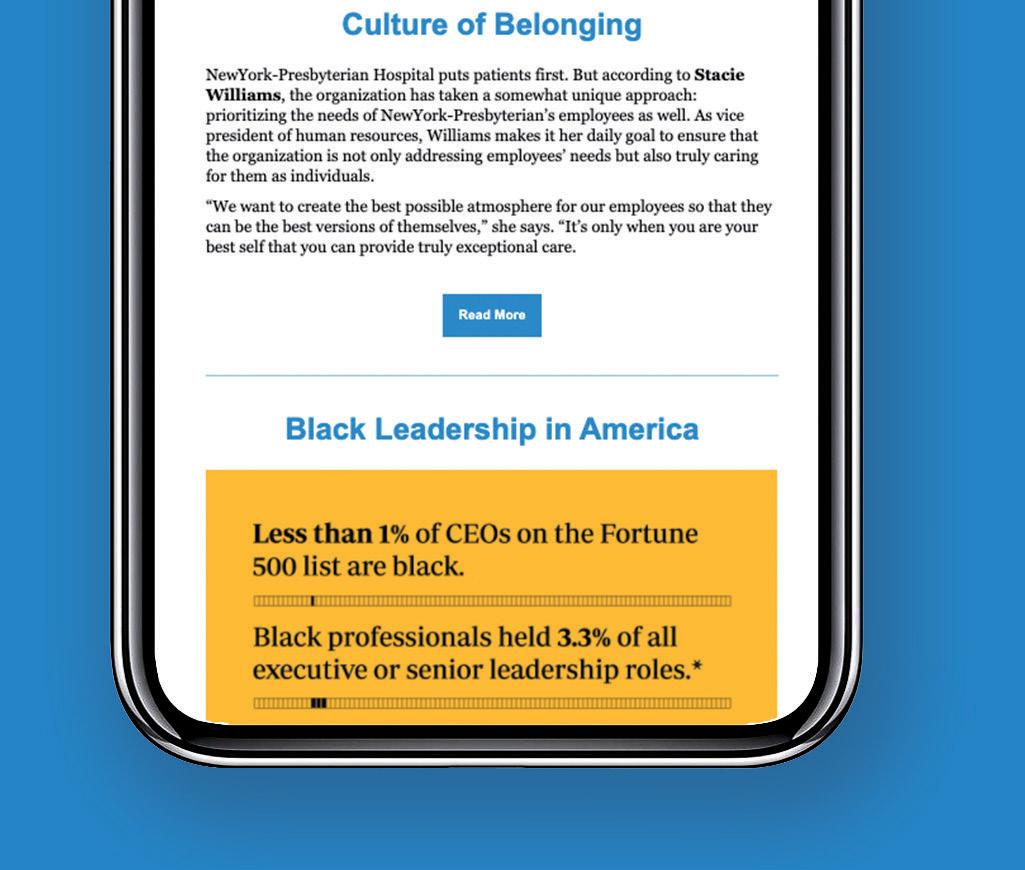
Twice

How seven leaders pioneer new ways of thinking to find success within their companies and functions




Disruption isn’t for everyone, but it’s the only way Gary Vaynerchuk knows how to live
returned to the wine world, what he calls a top-ten all-timer for “least
welcoming
and
industries,” and flipped it on its head with Empathy Wines, his most recent triumph at the time of speaking in September 2020. Through Empathy, Vaynerchuk began bypassing
distributor
all
retail channels and going directly to wine growers, innovating a direct-to-consumer e-commerce service that he later sold to Constellation Brands. These
are
calls
Vaynerchuk
byproducts of
what
an “addiction to the game.” His love isn’t money; it’s an obsession with building a business. Some people love music, some love cooking.
“If you want to know the secret or what I think of the law of attraction—I think that they only go so far. You can be at home and sit on the couch all day and wish you had two Lambos and a yacht or a $100 million dollar business, but unless you actually put the work in, you’ll never get to the place where that becomes your reality,” Vaynerchuk says in a 2018 DailyVee video titled “The Law of Attraction,” which has probably already been added to the B-school 101 curriculum of more than a few universities. The
Vaynerchuk’s
entrepreneur’s
dopamine
the
hobby, passion, and life is collectively fueled
by
and
born out of creating something from nothing. His relentless embrace of hustle culture is why he’s a touchstone for anyone seeking a definition for success. It’s why every
media outlet on earth wants an hour with the man. Profile got exactly nineteen minutes.
entrepreneur
rejection of the most widely propagated new age success model is precisely why he has attracted such a wide audience. He goes where he thinks he can do something better and does it. He doesn’t imagine success and will it into being—he gets down and dirty thanks to a work ethic that borders on manic. Vaynerchuk
early
made
investments in Facebook, Twitter, Tumblr, Venmo, and Uber. He cofounded Resy—a




restaurant
that
reservation
challenges OpenTable—and sold it to American Express in 2019. Vaynerchuk
service
THERE’S NOT AN ENTREPRENEUR ON THE planet who would decline an hourlong sit-down with Gary Vaynerchuk. Right this very instant, his calls to action and words of advice are undoubtedly being scrawled on whiteboards in start-up spaces worldwide. And for good reason. The wine critic turned advertising disruptor turned New York Times bestselling author turned de facto patron saint of hustle culture currently lords over the
in
powerful
most
independent advertising
cofounded
agency
media. VaynerMedia
by “Gary Vee,” as he’s better known, over a decade ago. Since then, he’s not only perfected the art of distilling a powerful message into a couple of sentences, he’s proven that an elevator pitch can often carry just as much weight as a TED Talk. The forty-four-year-old Vaynerchuk eschews the typical influencer mantras of self-actualization, a mentality popularized by Rhonda
Byrne’s 2006 self-help bestseller
Byrne’s Jason Morena
was
three-step process of positive visualization— ask, believe, receive—doesn’t get a lot of play in Gary Vee’s world.
Secret .
and my motivations as objectively as I possibly can,” Vaynerchuk explains. “There was a lot of adversity in my youth. I was a terrible student, because even at that young of an age I understood who I was, and I didn’t fear not succeeding in a system that wasn’t going to bring me any value. That’s what I ask you to do.”
Gary Vaynerchuk disrupts every industry he enters. A few of his more well-known success stories:
LIBRARY (1998): After graduating college and joining his father’s wine business, Vaynerchuk utilized a strong web presence to turn the $3 million business into $60 million in five years.
VAYNERMEDIA (2009): “The Wine Guy” and his brother AJ cofounded an advertising company specializing in social media—with no help from Madison Avenue. It became the fastest growing independent ad firm in history.
WINE
RESY (2014): Vaynerchuk elects to take on OpenTable, the standard in online dining reservations, by cofounding Resy. Pre-COVID, the platform handled about 2.6 million dining customers a week and was acquired by American Express in 2019.
EMPATHY WINES (2019): A return to his roots, Vaynerchuk disrupts again with a direct-to-consumer wine business that almost immediately acquires interest from Constellation Brands and is purchased in July 2020.
him
imbued
Gary Vee says he’s grateful his
parents
“But
with self-awareness, humility, and emotional
intelligence.
my
on
because of that adversity, I had huge
shoulders. Fortunately, it made me competitive and ambitious.”
chips
Vaynerchuk is still able to recall clearly one of the most important days of his life. In his official biography on his site, he readily admits that his father “literally dragged him into the family business.” It was there where his intense work ethic made his future clearer. Following his graduation from college, the call was his alone to make. “My first day of actual work, I was done with school forever. This was the last thing I was doing for my parents to fulfill their expectations for me. I’d spent all these years feeling like a caged animal. But I remember this day in late May. Other than having my children, it was the greatest day of my life. I was so happy and ready to do what I knew I was made for. It wasn’t glamorous; it was working in my dad’s liquor store, but I knew my best was yet to come that day. I just know that is very different from most people’s first day of work ever.” He cuts himself off in the middle of his own story. Because he wants to make one thing clear: you cannot skip the process and go straight
Good Morning America and the photo shoot for this issue, Vaynerchuk was available for an interview that probably lasted the length of a car ride. At times, the clatter of New York City—and Vaynerchuk’s own fervent way of speaking—made it sound like he was running through traffic to his next meeting. Profile ’s goal was simple: find out exactly what makes Vaynerchuk the King of Disruptors and the spoiler of entrenched industries—but also why he’s such a breath of fresh air in stagnant markets. “I think a lot of it comes down to the feeling of being an immigrant and growing up in a family business,” Vaynerchuk says. “I’ve been honing this craft since I was six years old. Lemonade, baseball cards, you name it. I’ve been this ambitious for as long as I can remember.” His
of
founding
as
store
Empathy Wines feels especially poignant considering his hustle in his family’s
he helped his father build a web presence during the early days of e-commerce. “I mean, I literally was fourteen with dreams of one day buying a vineyard in Napa Valley and having this great winery. Twenty years later, going full circle and having made a deal with one of the biggest wine companies in the world, there’s a different level of pride and emotion than anything I’ve ever done.”
liquor
The hallmark of Vaynerchuk’s style, the rabid tenacity and frenetic desire, have been with the disruptor from the very beginning. The immigrant experience coupled with a “no BS” willingness to understand himself cuts any air of pretension. “I’ve really taken the time to try and understand myself
 GARY VAYNERCHUK CEO, VaynerMedia Chairman, VaynerX
GARY VAYNERCHUK CEO, VaynerMedia Chairman, VaynerX
understand yourself. Don’t apologize for what you
love to do. And if it happens to make a lot of money,
like entrepreneurship or a potential basketball
player or actress, well, that’s lovely. But if it doesn’t,
then that’s just as awesome.” DISRUPTORS PROFILE 96 Q2/21
like a schoolteacher or a government employee, Tyler Babin

of wine aficionados accessible to the average consumer.
VaynerMedia made such a splash because it was willing to embrace social media as a viable medium to reach consumers when more traditional advertising firms stayed on the fence. A lot of ad firms will now claim to have been on those front lines, but there’s a reason VaynerMedia made such a ruckus. It was already there. “I think a lot of that comes down to inclusivity,” Vaynerchuk says. “If you look under the hood of my outward energy, I think I’m just inclusive by nature. I’m antiestablishment,
anti-closed doors, I’m anti-ivory towers. I think that’s refreshing to some because I help people realize that they can do it too. Even at VaynerMedia and VaynerX, most of the things I believe in marketing people tend to not want to accept. But it’s an absolute reality, and I think it’s helped people get into advertising that felt like they couldn’t.”
I’m
VaynerMedia and VaynerX remain the entrepreneur’s biggest coup precisely because of the industry they were upsetting. “The ad
advertising,

DISRUPTOR. IT’S A WORD THAT’S already started to lose meaning, but it’s one that Vaynerchuk has personified for forty-four years. “I think a lot of people lack the patience for disruption. People want to be in magazines, and they want to be called disruptors, but they don’t actually love disrupting. They just want money,” Vaynerchuk says. “If we’re talking about disruption, you’re talking about changing a well-entrenched institution that will take decades, not days, to make actually happen.” When asked how he was able to
wine, restaurants, and a slew of other industries so quickly, Vaynerchuk says it’s not about him, it’s about passion. “Bro, for the last six months, I sit down at 8:00 a.m. on Google Hangouts and I’m there until 7:30 p.m. Straight. I don’t care where the collateral is from or the accolades or financial impact. This is my addiction.” It’s not just high-profile success in disruption that has made Gary Vee a household name in business. His Wine Library TV YouTube channel made the stuffy world
disrupt
is

to success. “People hear it, but they don’t understand it. It’s so easy to get into better shape physically: go the gym and eat right. It’s astonishingly simple. But people want to use apple cider vinegar and steroids instead. They want to bypass the journey, the process. But when you sign up for entrepreneurship, you’re signing up for all of it,” he emphasizes. “I signed up for the bad stuff. For everything. I’m addicted to the process. You have to be, or you will not survive.” Maybe more important than inspiring
letting aspiring entrepreneurs know they’re not cut out for it, Vaynerchuk says. “I’m probably the loudest advocate that you’re probably not an entrepreneur,” the CEO says, frankly. Vaynerchuk muses that if he weren’t a disruptor, he could be the happiest teacher in the world. “Do not ever apologize for what you love to do. If it happens to make money, that’s lovely. I just want to be obsessed with the process. I just happened to be a disruptor.”
entrepreneurs
world on Madison Avenue is maybe the least welcome industry in the world,”
the CEO says, firing off in succinct, rapid-fire bursts of explanation. There is no animosity in his tenor, but it’s clear that this David versus Goliath undertaking left a fair number of bodies on the battlefield. Vaynerchuk
even more resilient. “Almost any independent agency that’s gone onto any kind of success was started by an executive that already had a lot of juice in the business. VaynerMedia was started ten years ago by a wine guy, and it’s the fastest growing company in the history of the industry. Everything I come into, I’m going to disrupt.”
continues,
Gary Vaynerchuk’s early investments in Facebook, Twitter, and Snapchat exemplify the entrepreneur’s preternatural sense for seeing a good thing coming. Most recently, Vaynerchuk called the shot of the Joe Rogan Experience, the most downloaded podcast on the planet. Vaynerchuk said in an interview during 2019 that Rogan would soon be bought up by a streaming service in what he deemed a “Howard Stern 2.0.”

In May 2020, the deal was struck as predicted, even down to the $100 million payday Vaynerchuk forecasted. “The reason I knew is because attention always eventually
gets
attention
monetized. Whoever
has
has leverage,”
later posted on his website.
Vaynerchuk
That’s the sell. It’s never a question of whether Vaynerchuk would actually sit still at a desk for hours on end grading papers, swearing too much and writing rants in the margins. It’s that when he gets in front of you, he convinces you to believe— that he could be a teacher, an astronaut, a starting NBA point guard. And because Vaynerchuk’s passion is so pure you find yourself wanting to believe him, wanting to root for him at every turn.
For the rest of us, we need to find our own passions. We need to lean into what we love, regardless of a streak of bad luck, a creative rut, or, in the case of 2020, a worldwide pandemic. When Gary Vee says he’d be just as happy making fifty grand a year doing something he loved, rather than spending twelve hours on

Hangouts

plotting the next big deal, it’s easy to believe him.
you opened up your restaurant and COVID happened. This happened. That’s the game.” It may sound cold, but that’s precisely the point Vaynerchuk is so desperate to convey. For Vaynerchuk, if you’re not as motivated to build during a crisis as you are in an economic upswing, the proposition itself is already a losing one. A disruptor isn’t dissuaded by unfortunate circumstances. They build despite them.
Having spent most of 2020 indoors hasn’t tempered Vaynerchuk’s enthusiasm. If anything, it’s only highlighted his passion for entrepreneurship. “For me personally, the last six months have been really great, because I’m grateful for what I have, not for what I lost during COVID,” Vaynerchuk says. “When you take this life on, that includes the reality that at any moment, everything can change. Entrepreneurship doesn’t care that
“VaynerMedia is one of the largest independent advertising firms in the world, and was started only ten years ago by a wine guy. The ad world on Madison Avenue is the least welcoming. Almost every independent shop that’s gone on to any kind of success was started by an executive that already had a lot of juice in the business. And Vayner’s one of the fastest growing in the history of the onehundred-year-plus industry. It had a starting point of no chance.”
Managing a technology park demands a certain type of individual who is comfortable dealing with the unknown regularly. There’s no formal training. “Nobody goes to school for that,” says Carol Stewart, associate vice president of Tech Parks Arizona for the University of Arizona. “You have to be predisposed to finding your way and finding new solutions day to day.”
By PETER FABRISoccupied
Stewart drew upon disaster preparedness plans for guidance. “We did not have a plan for a pandemic,” Stewart says. “We had to adapt for the situation.” Though many of the six thousand employees shifted abruptly to remote work, that wasn’t an option for all. Ongoing lab experiments would have been jeopardized with a blanket shutdown. Management quickly devised policies to safely keep the flagship campus, the UA Tech Park at Rita Road, open. Communication with each individual company increased to ensure tenant needs were met. Janitorial staff beefed up cleaning regimens. Air filtering was enhanced. New cameras were installed to improve security and monitor
density of spaces.
the
during
was
A perfect example of handling the
the COVID-19 pandemic.
unknown
In March 2020, executives at Tech Parks Arizona faced an unprecedented situation and needed to adapt quickly. “We were in a fetal position for twenty-four hours,” Stewart says. “Then we developed a strategy, and everybody had to pivot at a rapid pace.”
Point your cell phone camera at the QR code to be directed to the online article.The park also offered technology platforms and online services to help employees work remotely.
About 75 percent of tech park employees switched to telecommuting. It was a fairly smooth transition with all of the businesses able to continue to operate. That’s a sharp contrast from most other technology parks, Stewart says. “There are two hundred research parks around the world,” she notes. “And within the parks are technology incubators, which from my experience are the heart of successful parks. These incubators support early stage startups with critical business support giving them the best chance at success.


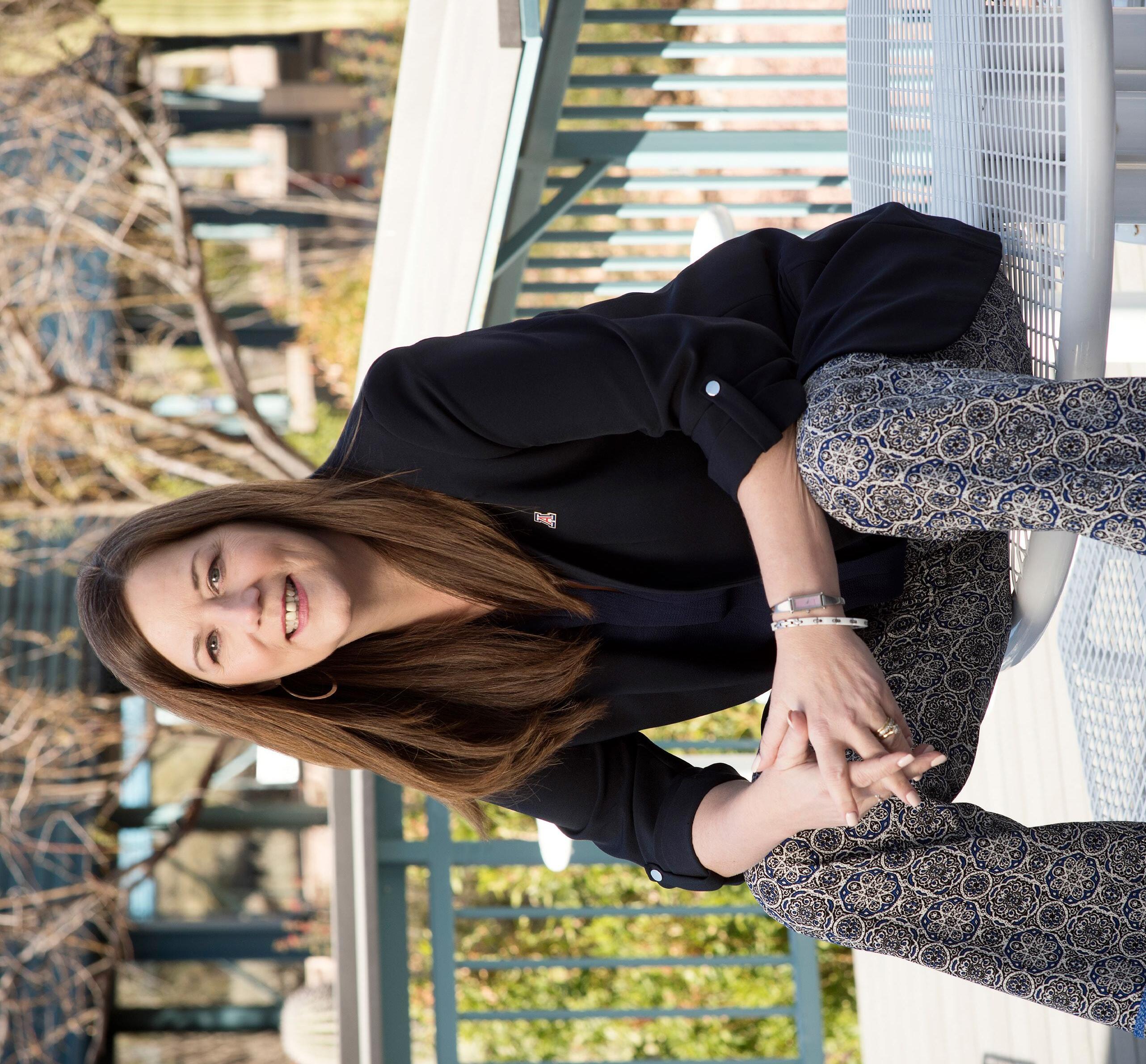
“This is a very critical time for startups,” Stewart adds. “Nationally, we are seeing 40 percent to 70 percent of startups close. However, we have not lost one here.” Stewart continues to check in daily with executives of each company to find ways park management can help them thrive. While business activity continued at the flagship tech park, construction at two new sites had to be assessed. UA Tech Park at
 CAROL STEWART Associate VP of Tech Parks Arizona University of Arizona
CAROL STEWART Associate VP of Tech Parks Arizona University of Arizona
Stewart is a widely recognized leader in the technology park world, having served as the CEO of the Association of University Research Parks,
represents
which
for
two hundred research parks across the world. In this role, she influenced national policy in Canada, created standardized
programs
the Bridges, part of a large multiuse development in central Tucson, calls for 1.8 million square feet of office and laboratory space that could support up to ten thousand employees. Site preparation and infrastructure work was briefly paused, and then quickly ramped up to keep the project on schedule.
their
tech parks, helped establish national and international business networks, and assisted countries with the development
national science and technology policies.
of
December
in
Tech Parks Arizona, a quarter century old when Stewart took the
2018, with a track record of success and potential for rapid growth— an exciting reason to make the move. With Tech Parks Arizona entering a new, vibrant phase, the opportunity to take best practices and lessons learned to a new level was too much to pass up. Working with a seasoned team, Stewart found ways to continue to recruit new businesses amid the pandemic. “It’s all about relationships,” she says. “How do you form relationships when you can’t even have a business lunch? You
reins
The University of Arizona Center for Innovation at Oro Valley was also in early construction phases when the nationwide shutdown occurred. This project will have roughly 4,000 square feet of office and lab space dedicated to incubating nascent bioscience businesses. Construction work also resumed after a brief shutdown, and the project is on schedule. Tech Parks Arizona’s growth is familiar to Stewart. She guided the David Johnston Research and Technology Park, affiliated with the University of Waterloo in Ontario, Canada, from its inception to over 1 million square-foot of innovation facilities. “It went from a cornfield to a world-renowned research park that is anchored by a globally ranked business incubator,” Stewart says.
“You have to be predisposed to finding a way and finding new solutions day to day.”
have to get creative, and that’s what we did.”
research
in Tucson. The remote business lunches literally captured the flavor the Southwest. With its strategic advantage location, numerous amenities, ample space, and endless potential to a talent pipeline of intelligence
and
away
expertise, prospects for Tech Parks Arizona remain bright. Indeed, though Tucson is thousands of miles from Waterloo, and a
climatologically, it’s beginning to feel like home.
world
One answer was developing a program called “Tamales and Tech Parks”—virtual meetings catered by a local eatery. Because Tucson is rich in thriving food traditions and
culinary
bit
a
brought
distinctiveness, Tech


Parks
revered
of Tucson food to people across the nation. The restaurant shipped their
locally
from
tamales to
companies interested in opening locations
executives
“It’s all about relationships. How do you form relationships when you can’t even have a business lunch? You have to get creative, and that’s what we did.”
blockbuster movies as Legendary Entertainment’s CFO. From his office at Burbank Studios, Hohauser can see Warner Brothers and Walt Disney Studios. He’s accustomed to being surrounded by the action. Hohauser took his first post as a CFO in the film industry in 2007 and has worked in the entertainment industry for twenty years, taking an unusual route to Southern California. A
gig
volunteer
musical
codirecting an
theater production at the Wharton School
amateur
Marvel
Ron Hohauser has an old PowerPoint presentation that lays out a plan to raise $525 million and finance ten movies. The first movie in the lineup was Iron Man , and that plan, which Hohauser helped create as the financial lead at Marvel Studios, led
Entertainment’s transformation from a licensor of film rights into a major production powerhouse. The feat is just one of Hohauser’s many professional accomplishments. He’s helped raise more than $2 billion since 2004 and today helps green-light
to
By ZACH BALIVAA behind-the-scenes look at how Ron Hohauser stacked up Hollywood accomplishments and turned himself into a film finance powerhouse


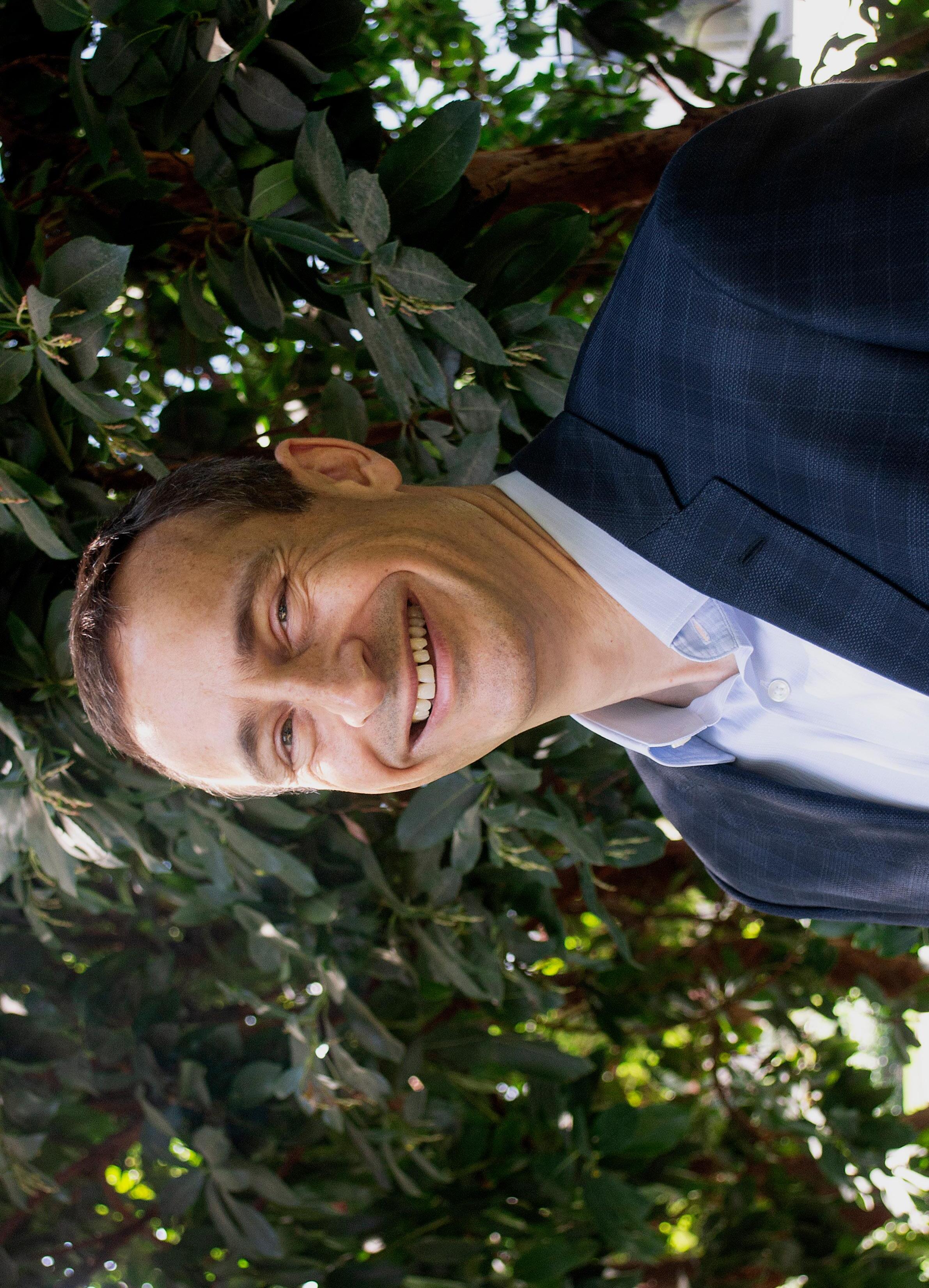
former
a
recruited to an investment bank with an entertainment and film advisory group and moved to Los Angeles in 2001. In
2004,
licensed
Marvel
Livent colleague working as the president of Marvel Studios hired Hohauser in a senior finance role. The company, which had been licensing its iconic characters to companies like Sony, was “leaving a lot of money on the table.” SpiderMan , for example, set several box office records on its way to grossing $821.7 million worldwide in
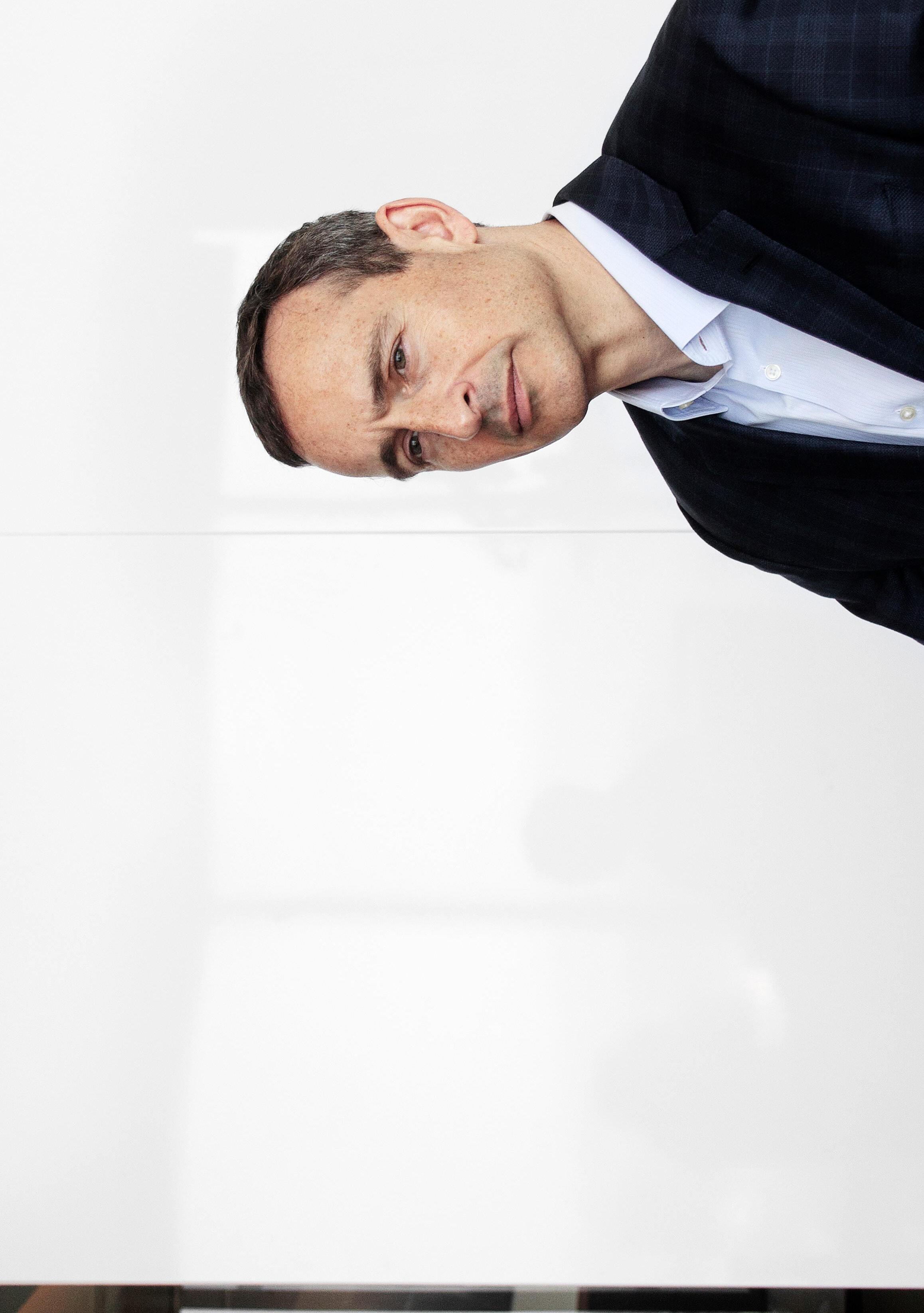
the character to Sony for $50 million. As part of a small team, Hohauser built a finance strategy that would reposition Marvel as a true film production company. With the plan in place just two years later, he left Marvel for the chance to lead a new organization as CFO. In 2006, he cowrote a business


2002.
put the young MBA student on a new path. “I loved collaborating with other people on a big project that made audiences feel something,” Hohauser says. “When it ended, I missed it. I set out to find a way to be involved with something like that every day of my life.” He moved to New York, convinced a Broadway producer to let him work for free, and ultimately landed a paying job. From there, he joined Livent,
Broadway
a
theatrical production company. Things were going great until the company’s CFO discovered and exposed accounting fraud by previous management that led to jail time and multimilliondollar settlements.
Hohauser found himself part of the leadership of a turnaround team as de facto head of production finance and honed his hard finance skills and business training within the industry. He was
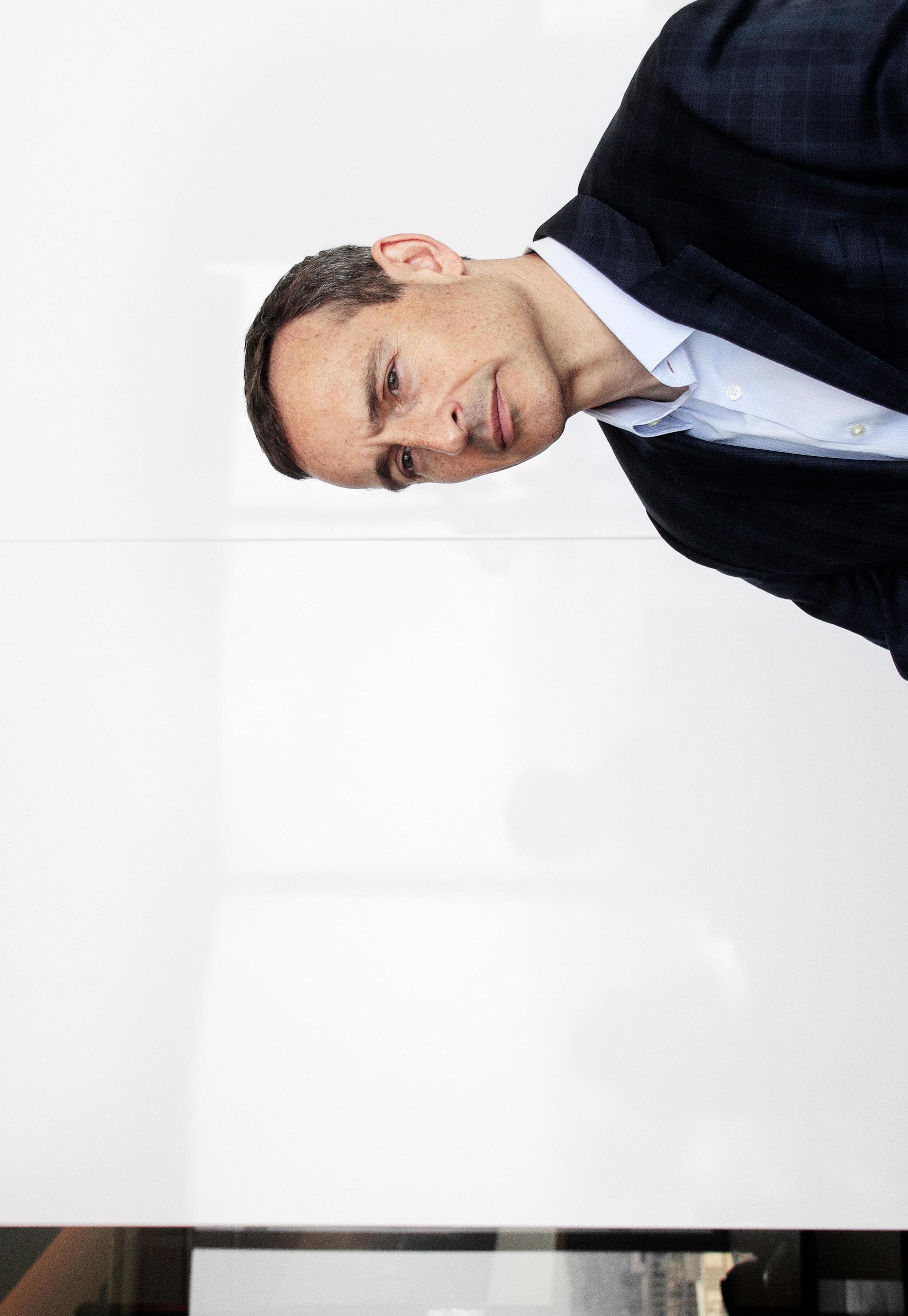


former
with
plan
movies, including P2 and Never Back Down , underperformed. With the company hemorrhaging cash, Hohauser was
Paramount executive Rob Friedman and leading entertainment attorney Josh Grode to acquire Summit Entertainment and raise $1 billion in equity and debt financing. The event forced Hohauser to develop new critical skills. While many CFOs have accounting backgrounds, Hohauser’s background was pure finance. He had never been involved in the operational or accounting sides of the business. Thankfully, the company Summit acquired had

first
Financing to power your creativity






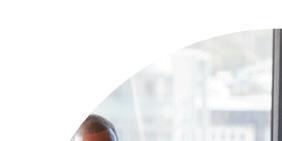
Let’s
power your
forward, together.
five ©2020 CIT Group Inc. All rights reserved. CIT and the CIT logo are registered trademarks of CIT Group Inc. MM#8101

Finally,
sleep.
losing
and
Summit struck gold with Twilight in 2008 and grossed $226.5 million. In the following twelve months, it surpassed $480 million. In 2012, Hohauser,
Friedman orchestrated the sale of Summit Entertainment to Lionsgate for $412.5 million. The era taught Hohauser many valuable lessons. “You can’t perfectly predict the success or failure of any one movie,” he says. “And therefore, your company needs to be capitalized in the right way.” In addition, he learned to produce a portfolio of products instead of betting the farm on only one big movie with which the company would rise or fall. Lastly, he learned to structure every deal to manage the downside while retaining maximum profitability. Hohauser’s most optimistic predictions for Twilight had the film earning $80 million at the box office—and because the company had managed costs to mitigate risk, Summit reaped the financial rewards when the vampire movie became a surprise hit. These lessons learned directly guide Hohauser’s strategy today as CFO of Legendary Entertainment. Prior to Hohauser’s joining the company, Legendary made its name cofinancing hits like Warner Bros.’ The Hangover , The Dark Knight , and Inception , and later collaborated with Universal. But then the company lost money on big-budget movies like Blackhat and Seventh Son . Legendary was doing exactly what Hohauser had learned not to do—tying success or failure to one big project. Legendary’s original ownership group sold the company, and the new owners tapped Hohauser and
Grode
“You can’t perfectly predict the success or failure of any one movie.
And therefore, your company needs to be capitalized in the right way.”




a lot in his career and still enjoys the challenges of navigating the complex, challenging, unpredictable, and rewarding industry. “It’s a roller coaster,” he says. “I encourage anyone with talent and a dream to take the ride. Just be prepared to work hard. Be really, really good at something . . . and hold on tight.”
The film business is notoriously fickle, and the COVID-19 pandemic underscored the importance of financial discipline. Hohauser and his team watched with great interest as movies like Trolls World Tour replaced theatrical releases with premium Video on Demand (VOD) debuts. The movie raked in $100 million in the world’s biggest digital premiere to date, and Universal retained higher gross profits than a comparable theatrical release would have earned.
CIT congratulates Legendary Entertainment CFO Ron Hohauser on being a thought-leader who is making a lasting impact. As a top fifty US bank that aims to empower people to power their businesses forward, we’re proud to put our deep expertise in the film industry to work to help established companies and newcomers alike turn today’s ideas into tomorrow’s outcomes.
Enola Holmes (starring Millie Bobby Brown of Stranger Things ) was slated for release during the pandemic, but Hohauser and his colleagues sold the film to Netflix for a profit. The accomplished film finance CFO has seen
BHI.
at
the company’s external partners. “As one of Legendary’s bankers, Ron is someone I am comfortable and confident working with,” says Melanie Krinsky, head of entertainment
“He knows banks are concerned about the long term, where the financial plan completes the often unpredictable worldof filmmaking.”
lending
Fifth Third Bank’s Kevin Khanna is in agreement. “Ron has a keen ability to drive a business toward success,” says Khanna, senior vice president and head of corporate banking. “I’ve known him, both personally and professionally for a long time, and I’m always impressed by the results he delivers.”
“It’s a roller coaster. I encourage anyone with talent and a dream to take the ride. Just be prepared to work hard. Be really, really good at something . . . and hold on tight.”
industry.
PROFILE 112 Q2/21 DISRUPTORS
dated eleven standalone brands and websites, all the while bringing customers along to a completely different go-to-market model, new brand rollout, website, and marketing collateral and messaging. Part of building trust, for Culp, comes from discovering a noble cause for the work. “We are the center of the backyard lifestyle. This is more elevated than just a providing a vessel that holds water,” he says. He leads his team to connect with consumers on an emotional level. When such beliefs are real, Culp feels, they touch all corners of the company, all the way to the employees in the factory. “They’re not just spraying fiberglass,” Culp says. “He is making memories for the family who will own that pool.”
dream of a pool to their first pool party.” Latham was built by a collection of strong, independent companies that Culp describes as very effective but historically siloed. The company’s recent pivot means working as a unified organization. This transition has required immense trust from its dealer partners.
Along with these large visions, Culp knows he must be responsible for the ROI and results of the effort. “In today’s business, we plan in reality, not abstractions.
process.
this
of
says
“Building trust takes being open to conflict, full transparency, blatant honesty, and listening,” Culp
shifted,
have
pool builders saw Latham primarily as a manufacturer. Though Latham’s focus
Culp attests that “we have always worked on behalf of the dealer,” with goals that include increasing the capacity to serve and providing a bridge for end consumers. Restructuring -
may
and -
refocusing didn’t only mean reassuring deal
ers. Culp collapsed and consoli
“With trust, respect, and focus, you can mobilize an organization to move mountains,” says Joel Culp,
marketing
chief
officer (CMO) for Latham Pool Products, the largest pool manufacturer in the world. For Culp, this is not a theoretical claim. “This past year, we moved mountains,” he says of his team. They have, at least, moved a lot of pools. Since jumping into the company in February 2018, Culp has also helped move Latham’s model from business facing to client facing.
“Our customers were asking for help with the entire pool-buying process, from start to finish,”
consider,
to
Culp explains. “People dreaming about a pool are thinking about the entire backyard. There are many
things
excitement
and with
comes lots of questions. Latham wants to be their guide, shepherding them from the first time they
their
Reality leads to commitment and accountability,” he says. Culp’s department is integrated into every very real element of Latham. They focus on strategies, including product innovation, based on consumer trends and managing company vision and financial goals.
retooled
Latham’s
website demonstrates the excellent strategic execution. The challenge, Culp explains, was to create a rich experience for the end consumer and a functional platform for dealers. The result is a delicate balance that speaks to varied users. Culp came to Latham because he saw a once-in-a-lifetime opportunity. “With the right investment, things could really change,” he says. It was indeed a year of change at Latham Pools. He is ready for the next moment, thrilled to see where the brand goes next.
communication
passion,
skills and an ability to sell internally.
In essence, Culp explains, he looks for people who will ask, “Why not?”
During the past year’s massive lift, Culp describes his team of seventeen mountain movers as flawless. While there were mistakes, they corrected and had excellent strategic execution. Culp also gives credit to the many outside partners who saw the opportunity, along with the increased demand for work, and made a huge investment in mission and vision.
In every aspect of creating this experience, the CMO enacts his basic process: assess the strategy, then build. This includes creating his team. He begins with intentional and careful hiring, seeking people who can enact strategy. His primary goal is finding good culture fit with company values. “I worry less about pedigree and experience,” he says.
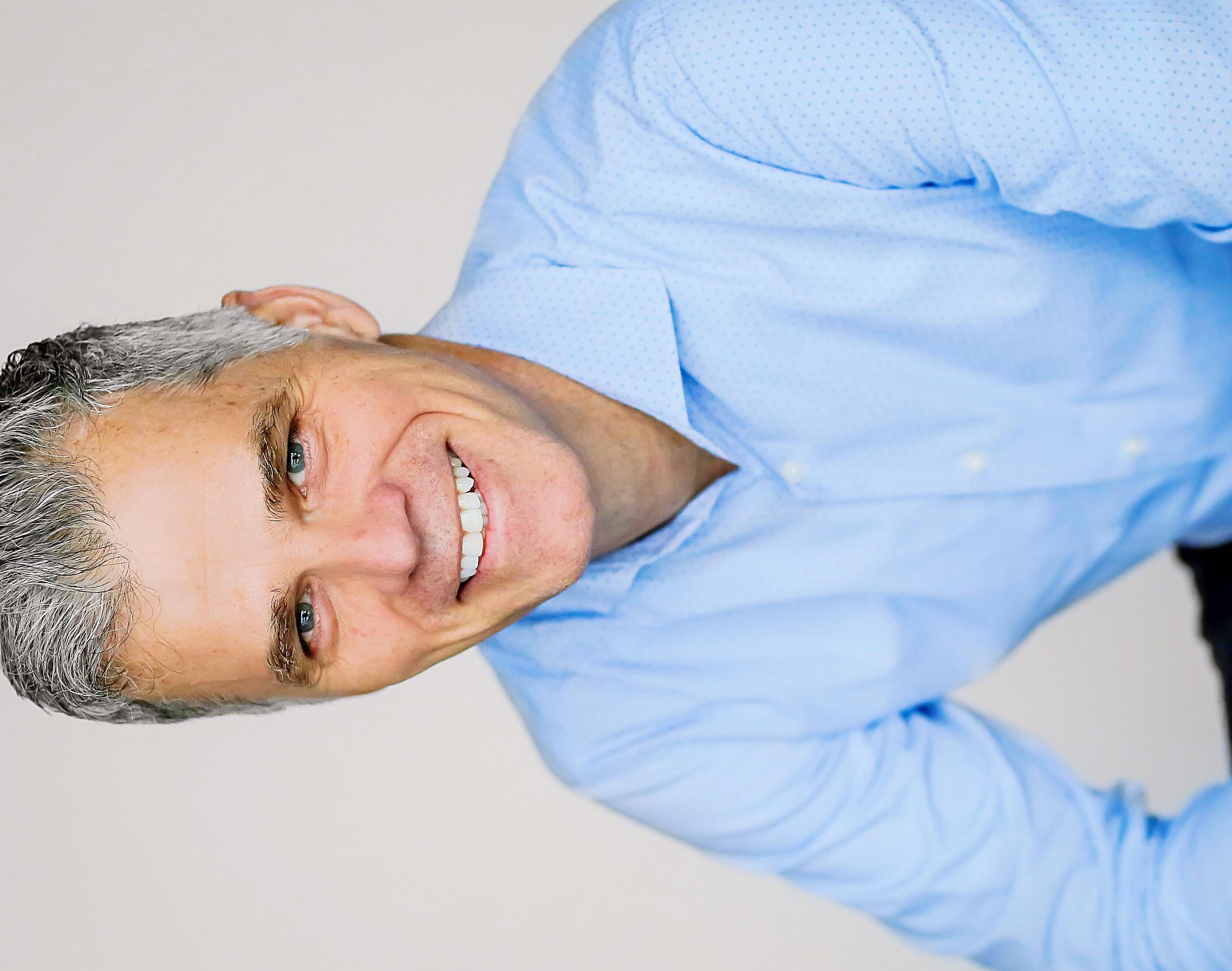


Far more, he is concerned with how people think, and he prizes accountability and transparency. Understanding the cross-functionality of marketing, he prioritizes
quality,
life
and
Latham is reinventing itself through, as Culp describes it, a time of unprecedented demand and growth. Culp guides his team to champion products and, he says, respond to a consumer reevaluation of

home
describes
a desire to “get back to a simpler lifestyle” of backyards and family time. Paired with this culture shift,
Culp
believes
design, caliber, and aesthetic innovations in pool technology and compressed installation time—from weeks to days—as elements that increase consumer interest. Following these trends,
Latham’s growth will be sustainable. Culp runs on a constant cycle of elevated future planning conversations and diving into the nuances. Right now, looking at the company’s runway, he prepares to explore new directions while working in an evolving marketing climate. Instead of multiple-year planning horizons, he sprints toward annual strategies. Analytics also play a huge role.
Culp
“Having access to data is one thing,” he says, “but being able to pull it apart at a local market level is another.” His team thinks and responds locally, by zip code, rather than regionally or nationally. In this time of refocus from traditional forms of advertising, “clever marketing and taglines are important, but the experience is really that interactive actions speak louder than words,” Culp says.
in



career
wouldn’t
Muehlberger
Bryan
infrastructure and
technology,
support
St.
which led to many different roles and receiving the 40 Under 40 Award from
Business Journal in early 2006. In March 2006, Muehlberger joined Express Scripts, a pharmaceutical benefit management company in St. Louis, where he was quickly promoted to a director-level position and took over application development. In early 2008, Express Scripts was working on a new consumer engagement initiative that Muehlberger worked on alongside the product management and marketing
the
be where he is today if he wasn’t willing to take a few risks. Throughout his career, Muehlberger has never shied away from accepting challenging jobs and taking on new responsibilities. “What I’ve always believed in my life is sometimes when you go out on a limb and do something that is outside of your comfort zone, that’s when you grow the most,” says Muehlberger, who is currently the chief information officer and executive vice president of technology for California-based Beachbody, a worldwide leader in health and fitness.
Louis DISRUPTORS PROFILE 114 Q2/21
By KEITH LORIA





the technology division at Express Scripts to join the product management and marketing teams and lead a new innovation effort that became known as “Consumerology,” which was defined as the application of behavioral sciences to healthcare. It quickly became the company’s primary differentiator in the market.
teams. The initiative explored how to leverage behavioral sciences and the principles of behavioral economics and apply them to healthcare—so that the company could ultimately better understand how its members made healthcare decisions.
“It really allowed me to get a feel for solving complex business problems from a technology point of view and how technology really is a primary enabler of innovation and growth,” Muehlberger says. “Had I not done that, I don’t think I would be where I’m at today and I don’t think I’d have the same insight as I do when it comes to working with both internal stakeholders and external partners.”
From a career standpoint, it was a pretty risky bet. “I was probably fifteen years into my career in technology and all of a sudden I’m going over to marketing and product management,” he recounts. The next challenge came when he was downsized from Express Scripts in 2012 following a mega-merger. Though he had landed a job in St. Louis in short-order, he left that
“We had an issue at the time where people weren’t recognizing how home delivery could be beneficial to being compliant to their home therapy recommendations by their
Muehlberger explains. “For example, how taking your Lipitor on a regular basis prevents you from having a heart attack and prevents you from ending up in the ER.”
physicians,”
The goal was to spread the word regarding the advantages of home delivery and how it could improve drug therapy adherence. “Because of my relationships with the business at this point and time, they recognized me as a potential candidate to help,” Muehlberger notes. “They needed somebody who had both technology savvy and business savvy.”
Muehlberger, who earned a degree in computer science from the University of Missouri and an MBA from Washington University, left
“What I’ve always believed in my life is sometimes when you go out on a limb and do something that is outside of your comfort zone, that’s when you grow the most.”
personnel issues. It was a truly transformational effort.”

After almost five years at Red Bull, Muehlberger wasn’t looking for something new when he was approached by a recruiter about Beachbody, which was right around the corner from Red Bull and had a reputation as struggling company. Nevertheless, he agreed to meet
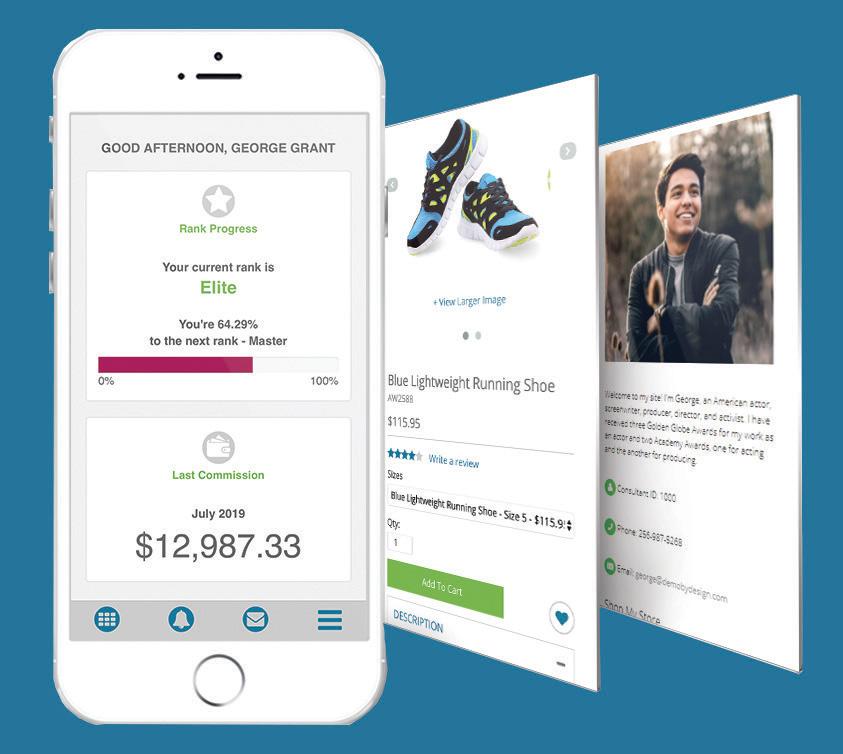
Beachbody’s
with
leaders and founders. “I was really inspired by some of the things they said, and I think a lot of the perceptions in the market were not 100 percent accurate,” Muehlberger adds. “Here I was cruising along at Red Bull, things were going really, really well, and I had a great set of initiatives we were working on. But at the same time, I was kind of getting a little bored, a little
says.
Muehlberger
company for a vice president of IT and chief information officer opportunity at Red Bull in Santa Monica, California, in early 2013. It was a big step that offered him the chance to utilize all of his professional experiences, and it also meant a big move for his family. Once again, he was out of his comfort zone. “It was a brand-new environment, both personally and professionally,”

“I didn’t have my network to rely on anymore—everything was new. I was either going to succeed or I was going to fail at this. I was challenged with a much larger team that had a lot of different challenges. They were a struggling IT function and struggled with delivering
their
on
commitments and keeping budgets, and they had
antsy. So again, I decided to step outside my comfort zone.”
Beachbody’s
partnership. “It’s exactly what X-Team does best for fast-growing companies, providing on-demand, high-performing teams of engineers to help drive that growth forward.
needs have scaled, we’ve scaled right alongside them and it’s been an excellent partnership.”
As
For Muehlberger, it’s been an exciting career trajectory. “It just kind of all fell into place,” he observes. “And I think it comes from the mindset I’ve always had. I like to tinker and break things apart—when something is broken, I try to figure it out. I always like to problem solve and then put myself into situations that are way outside my comfort zone.” And then he succeeds.
ByDesign Technologies is proud to serve Beachbody so it can make a positive impact on the lives of their customers and coaches. As its primary technology provider, we supply the tools, expertise, and insights that manage their genealogy and commissions effortlessly and support their best in class products.
X-Team provides high-performing, on-demand teams of developers for the world’s leading brands since 2006. Companies like Beachbody, Riot Games, FOX Broadcasting, Coinbase, Sony, and more call upon X-Team when they need to build multiskilled, forwardmoving teams that know how to add value from day one. Learn more at x-team.com.
Joining Beachbody meant running a bigger technology team and also working for a company that was not a subsidiary of a parent company. The switch also came with challenges, including layoffs and low morale. “We kept our eye on the prize, and kept our focus and our heads down,” Muehlberger explains. “And the wheels just started turning in the right direction. We rebuilt the management team, got our budget in order, and started delivering on our mission. Now we’re in a great position as a company where morale is up, and people want to join Beachbody. We’re one of the few companies that are growing in this weird COVID environment that we’re in right now.”
He added that Beachbody has international growth, acquisition growth, and organic growth opportunities and that the company is “blowing numbers out of the water” while facing a new set of interesting challenges.
Muehlberger has enlisted the help of X-Team to make that growth possible. “It's been incredible to witness Beachbody’s tremendous growth over the last few years and maybe even more impressive to witness their ability to navigate and accelerate their business in the midst of the new ‘work-fromhome economy’ we now live in,” says Chief Business Officer Jake Foley, who has spearheaded the
“I always like to problem solve and then put myself into situations that are way outside my





security
in
has
leadership from the SANS Institute to bolster her IT acumen. That class, and on-the-job learning, gave her a solid grounding in what she needed to know. Temples’s
career
teams
been rich with projects in which she led
of people with diverse skills and professional
cross-functional
backgrounds. DISRUPTORS PROFILE 120 Q2/21
So, it’s not surprising she had an innovative perspective on leading IT security staff. She discovered one vital component that was lacking: esprit de corps among the security team and with other groups that regularly interacted with the department. Building personal connections is not something that comes easily to most IT workers. So, she encouraged her team members to step outside of their comfort zones by initiating social gatherings such
A consulting gig to assist GreenSky implement security tools turned fortuitous. The consulting stint went so well that she was offered the chance in January 2017 to join the company full time to be a leader in IT security— despite no IT management experience. Her kids were older, and the timing was right. “I was lucky that they took a chance on me,” recalls Temples, who is currently vice president of IT security and business continuity. The new role wasn’t foreign; in some ways, she had “always worked with technology folks.” At its heart, the position is largely about strategy and project implementation—areas where she excels. Still, she had much to learn. While she didn’t have to become an expert in nuts and bolts IT systems, she needed to develop a deeper understanding of IT infrastructure and security.
firms
Most cybersecurity chiefs have an IT background, given that technical acumen is essential to the security team’s success. But Lori Temples is proving that a topnotch IT security leader can hail from a business background, showing how such a résumé can be advantageous in guiding a missioncritical function at leading fintech payment technology developer and operator GreenSky. Temples made her mark in customer-focused banking services. She served as vice president of convenience banking at SunTrust (now Truist) and later developed products in Home Depot’s financial services division. Later, to allow her to spend more time with her young children, she launched her own consultancy, helping financial
like CheckFree (now Fiserv) and eBank with business strategy in the evolving digital landscape.
services




Rob Hainer as team building events and cornhole tournaments.
for many, but Temples’s unusual perspective on IT security is a perfect fit for GreenSky.
“Lori is an innovative IT and security leader who is an expert in addressing the cybersecurity challenges that can impact business availability. Together, we have strategized and rapidly executed throughout this pandemic, ensuring high company resilience and employee safety.” –Daniel Martin, vCISO, Veristor, provider of transformation business technology and security solutions
to install workstations at home and how to use multifactor authentication remotely as well as access their applications through a virtual private network (VPN). The transition went as smoothly as could be hoped. Relationships established
Temples’s outreach efforts with operations leadership bore fruit.
through
desk,
“I really had to push them,” she says, “but after a while, relationships became so much stronger.” These events fostered better teamwork, so Temples reasoned other areas in IT would also benefit. “I said, why don’t we do this with other IT departments— operations,
system administration, DevOps, and network teams?”
help
Outreach with other groups is essential when it comes to IT security, Temples notes. These relationships spur deeper understanding of counterparts’ needs and priorities. Knowing that Task A in cybersecurity must be completed to enable advancement of a mission-critical project in operations inspires cybersecurity personnel to prioritize Task A. This principle was evident when the COVID-19 pandemic struck. Stronger bonds within IT and across the company in general helped GreenSky rapidly shift to a working-fromhome model.
this part of the job seriously and works hard to bolster her technical knowledge.
her
But
project management and people management skills add another dimension that those rising through the IT ranks often lack.
“If I had come up in IT, I would have approached this job like a technologist,” Temples says. That strategy has its merits and works
“I was never so proud of my team supporting all areas of the enterprise to make sure our associates were safe,” Temples says. With the dangers of cybercrime always lurking, Temples continues to reach out across the organization. “Everyone in the organization needs to know about cybersecurity,” she says. “It’s something all associates should be invested in. Our associates are our first line of defense.” Her team conducts monthly simulations to maintain vigilance against phishing schemes. Fake emails sent by Temples’s team tempt workers to click on links embedded in the messages. Employees are challenged to identify these phony emails and are eligible to win prizes if they report
to
them
cybersecurity. In addition, they have a robust awareness program that includes monthly
training, Cybersecurity Month, and other fun security-based events.
newsletters,
To be sure, an IT security leader must be able to understand how various systems interact and what is needed in the big picture to keep them secure. Temples takes
During March 2020, Temples led a cross-functional team to make the transition within a week and a half. Among the IT security challenges to allow customer service representatives work effectively from home was to equip them with appropriate hardware that contained the appropriate security tools. The security team worked closely with peers in networking, help desk, systems administration, facilities, and other functions to get employees up and running remotely efficiently and safely. “We had to make sure tools were added to all of their equipment before call center people went home,” Temples says. Tutorials were created to demonstrate how
the customer, Miller says. Planet Fitness is unique in that it focuses on the majority of the population who are first-time or casual gym goers, so it was imperative that the digital experience be tailored to their needs.
“Forty percent of our members have never been to a gym before— they don’t know where to start,” Miller says. “Planet Fitness is dedicated to providing a judgmentfree zone where everyone is welcome, so we designed the digital experience to provide some of that basic initial guidance.” By the time COVID hit in early 2020, Miller and his team were already two years into a planned three-year rollout process, and they were in a good position to accelerate their digital strategy. In addition to insights into the brand’s customers and business needs, they had onboarded partners and stakeholders, acquired
During the early days of the COVID-19 outbreak, Planet Fitness was forced to temporarily shut down more than two thousand gyms. Luckily, the brand was well positioned to keep its members engaged at home, thanks to Chief Digital Officer Craig Miller, who had spent the past two years preparing the brand for a digital transformation. When Miller first came on board in early 2017, Planet Fitness was in a rapid growth phase and had become one of the largest fitness brands in terms of membership. Recognizing that a digital disruption was inevitable, Planet Fitness hired Miller to build and execute an innovative strategy designed to keep members engaged, whether they worked out at the gym or at home. The foundation of any digital strategy, no matter the industry, relies on a deep understanding of
By STEPHANIE ZEILENGACraig Miller, chief digital officer of Planet Fitness, on leading the brand’s digital transformation and connecting with members during the COVID-19 pandemic
necessary funding, aligned the digital strategy to the larger business model, and taken steps to execute digital assets, including a new mobile app and enhanced website. “When we had to shut down our gyms, we had no way to stay connected with our member base and customers except through digital,” Miller says. “So we put our digital strategy on steroids and literally pivoted overnight to accelerate some of the initiatives we already had planned for 2020 and 2021.”
on profilemagazine.com
Facebook Live. The classes, led by Planet Fitness trainers, are accessible for people of all fitness abilities. “This was a way for us to stay connected with our members while the gyms were closed, and we did in a totally unique way,” Miller says. The campaign was a huge success, netting more than five billion impressions within three months.


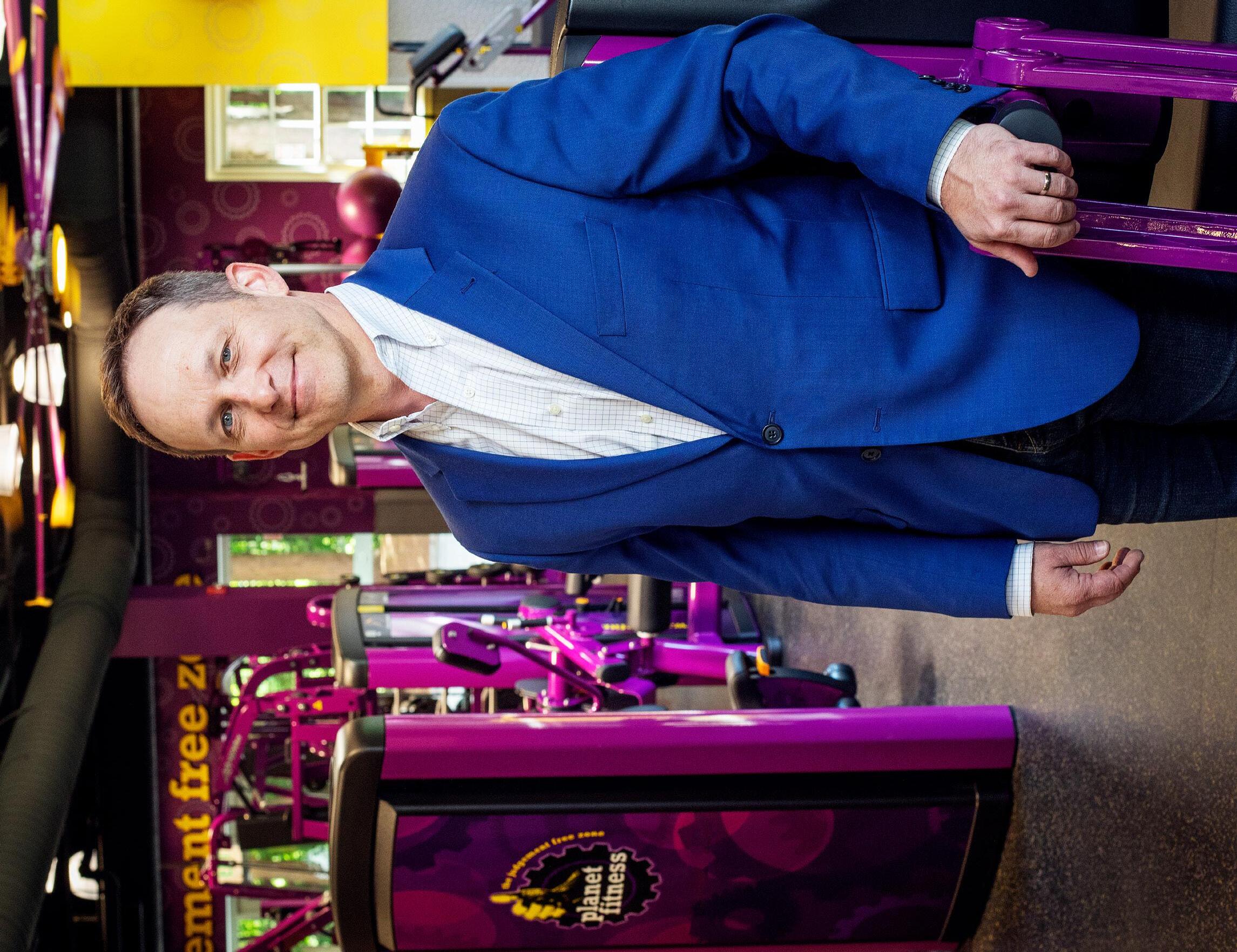

streamed

A big part of Planet Fitness’ argument against their gyms being a part of the problem is the size of their clubs, which average 20,000 square feet. “We’re better positioned to institute social distancing and tracking than most any other business out there— we’re able to shut down every other machine to keep capacity down, and because members have to sign in, we always know who is in our clubs when,” Miller says. “When you add information from healthcare organizations saying that the best preventive is fitness, exercise, and healthy nutrition, then that creates a whole different narrative. Not only are we not a risk, but we can actually be part of the solution.”
executing
in
digital transformation is not the
Miller and his team also got to work preparing for the gyms to
They
reopen.
adding
ways,
incorporated the app into the gym experience in
innovative
easily
a crowd meter so members could tell whether their gym was at capacity and installing scannable bar codes to gym equipment so members
access instructional videos. “This is an example of us meeting the needs of our audience,” he says. “If you’re a new gym goer, it can be intimidating asking for help. Now they don’t have to.”
could
Although gyms were at first vilified as accelerators of the COVID-19 outbreak, Miller says Planet Fitness’ access to a wealth of data helped change the narrative. “We knew the story around gyms being a health risk just wasn’t true because of what we were seeing from our gyms that were allowed to reopen,” he says. “Out of around thirty million check-ins, we only had 131 COVID cases identified in our gyms, and none were contracted there. These numbers are a fraction of what the statistics were showing across the population.”
a DISRUPTORS PROFILE 124 Q2/21
“I tend to challenge thinking a bit because I believe if something seems impossible, we’re just not thinking about it in the right way.”
when his team is working on a difficult problem. “That’s always gone a long way to earn the respect of my team,” he says. “I’m all about transforming a vision into reality and getting the work done.”
the groundwork for the brand to weather the COVID-19 storm well.

“We believe we’ll come out of this stronger than before, due to our size, our financial strength, and our high-margin model,” he says.
No business can truly serve its customers without a digital presence, on the web and on their many devices. Digital relationships let you serve and understand them in new and powerful ways. Follow the lead of Planet Fitness and let Applied Visions get your business in shape for the future.

Part of Miller’s success is no doubt his “nothing is impossible” attitude. “I tend to challenge thinking a bit because I believe if something seems impossible, we’re just not thinking about it in the right way.” He also believes in leaving titles behind
technology but rather the changes that must take place within the organization. “I’ve been doing this a long time for a lot of different brands and industries,” he says. “Driving alignment across stakeholders and the company culture can be difficult, because people typically don’t like change. It’s process that takes education, building trust, and confidence.” He strongly believes that his work with Planet Fitness had laid
Before John Emmart took up the mantle of chief human resources officer at healthcare organization Phelps Health, he felt the call to ministry. “I assumed I was going to be a parish pastor,” he says, but instead he found himself working as a hospital chaplain before eventually transitioning to work in HR. It’s a calling that has informed his career in both the sacred and secular realms, and his dedication to people and outcomes plays heavily into Phelps’ people strategy and employee engagement initiatives.
Emmart’s early life was marked by tragedies that heavily inform his dedication
to caring for people. On his twenty-first birthday, he learned that his father was dying of cancer. Not long after his father died, his mother fell terminally ill, and Emmart put a pause on school so he could go home and care for her. Later, he lost a brother and sister to cancer. These experiences all shaped him profoundly.
But Emmart also sees these experiences through the lens of one of his favorite comic book characters: Batman, a boy shaped into a force for good by family tragedy. “What happens in our lives shapes us and makes us who we are,” he says. In many ways, experiencing such close loss has driven his life choices, both as a man of faith and a healthcare provider.
After a brief stint working in genetic engineering, he returned to his pastoral education, entering grad school seminary, where he took a pastoral care course as a hospital chaplain at Baylor Medical Center. “It was like a duck to water,” Emmart says. “I loved that you could do ministry but you weren’t defined by a particular religious dogma or doctrine.” From there, he took a directorship at the University of Wisconsin Hospital and Clinics, where he spent fourteen years running the pastoral services department and employee assistance program (EAP).
It was here that Emmart began to see the need to transition out of chaplaincy, following a “dark night of the soul” where he faced the burnout that often happens in such a
profession. He came to a realization. “Instead of helping people die, I wanted to help people live,” he professes.
From there, he made a more direct transition into EAP and HR work, starting with a position at Mercy Health System in 2004, where he spent the next thirteen years overseeing direct EAP services and human
John Emmart CHRO Phelps Healthresources functions. In 2018, he joined Rolla, Missouri–based Phelps Health as their CHRO.
Emmart feels his combined skill set of pastoral work and EAP management make for good crucibles to work as an HR practitioner. At Phelps, that unique intersection of disciplines comes in handy in both the day-to-day duties of a CHRO—recruiting,

“Instead of helping people die, I wanted to help people live.”
JOHN EMMART
bswift is proud to be the benefits administration partner for Phelps Health. We celebrate John Emmart’s passion for healthcare and his commitment to improving employee engagement. Congratulations on this recognition!
retention, etc.—as well as the broader strategic responsibilities. “It’s not your typical CHRO role,” Emmart confesses. “There are some operational responsibilities that touch the patient, which is what really attracted me to the role.” This gets him closer to the patient experience that harkens back to his time as a chaplain.
“John is dedicated to his team at Phelps Health and proves to be a good leader,” says Cheryl Dulaney, client manager of health benefits at Trustmark. “It’s a pleasure to partner with him on the health benefits for his associates.”
As one of the stewards of Phelps’ strategic plan, Emmart also plays a crucial role in sketching out the organization’s five-year strategy. He estimates he’s responsible for about 20 percent of Phelps’ new plan, specifically the areas that focus on employee engagement, leadership development, and accountability. He’s particularly proud of his work facilitating greater employee engagement, an area that, in the unpredictable world of COVID-19, couldn’t have come at a better time, with employees needing a buy-in option for their healthcare needs. He also implemented a new, fairer compensation plan for their employees.
bswift.com
bswift, a CVS Health Company, helps streamlines benefits, HR & payroll administration for employers nationwide.

But it’s the little ways Phelps gives back to the local community that allows for the kind of people-facing interaction that engages Emmart. Part of Phelps’ employee
engagement work involves the Community Benefit Office, which facilitates projects like food drives and an annual collection of personal hygiene projects to give out to the less fortunate in Rolla’s community.
All these initiatives, big and small, contribute to Emmart’s aspiration to fulfill Phelps’ mission to improve the health and wellness of people in the south-central Missouri area. “We have the highest employee engagement of any healthcare employer in our region,” Emmart boasts, with lower turnover and high employee retention. This engagement drives more successful outcomes as well. Employees who feel engaged by their employer, he observes, will provide the best possible care for their patients.
Despite having left the chaplaincy for HR, Emmart still feels his work at Phelps ties deeply into his desire to help people going through tremendous hardship. “It’s a vocational marriage,” he muses. To him, HR is a kind of secular ministry; he’s still living out his calling, just in a different way. “I never left the ministry,” Emmart asserts. “I just redefined it.”
Choosing the right benefits administration partner can help you realize the full potential of your benefits investment. With agile technology and a full-suite of services, bswift delivers an experience that’s personal and secure every step of the way—for you and your employees. Visit bswift.com to see why employers like Phelps Health choose bswift.
“I never left the ministry. I just redefined it.”
JOHN EMMART
“Looking back, it’s been a whirlwind,” says Lindsay Caulder of her four-year tenure as senior vice president of human resources for World Acceptance. Responsible for anything and everything that has to do with people in the organization, Caulder oversees talent acquisition and management, learning, associate/employee relations, benefits, compensation, and payroll.
Integrated into this exhaustive list, Caulder also makes sure culture and communication building is a core function of everyone in the company, especially leadership. To that end, in the summer of 2018, Caulder initiated the Culture of Caring
program. The goal was to respond to two questions: How are we being intentional in what we do? What is important to us?
World Acceptance, parent company of World Finance, operates in sixteen states to offer small loans to customers who might have trouble getting them elsewhere. To understand what the company’s internal culture building project should look like, Caulder surveyed all four thousand team members, asking for three adjectives that best described the company and its leaders.
“Care” rose to the top among a large swath of respondents, along with the sentiment that the company felt like family. With these ideas as a foundation, the leadership team spearheaded plans, HR developed
them, and the Culture of Caring program was born.
The program includes the World Acceptance Foundation, an internally grown fund with an independent board that awards financial support to team members who have experienced natural disasters. “This increases a sense of family and community,” Caulder says. “People feel joy and love serving their communities—both internally and externally.”
Along with the foundation, the company also now runs a time-off donation program and annual paid volunteer days and helps identify community needs that its branches and team members can help meet. This work accelerated with the COVID-19 crisis as branch locations seized opportunities to offer flowers to clients around Mother’s Day and team members kept sewing machines on their desks to stitch masks while answering phone calls.
When Caulder joined the company in 2016, she arrived with a quick desire to implement programming that encouraged employees to support each other and their communities. Before she could launch what became the Culture of Caring program two years later, however, she needed to roll up her sleeves and prioritize other initiatives first. Her list of achievements is impressive. Starting with a benefit program overhaul, World Acceptance began to offer vision insurance and switched medical carriers for the first time in a dozen years under Caulder’s guidance.
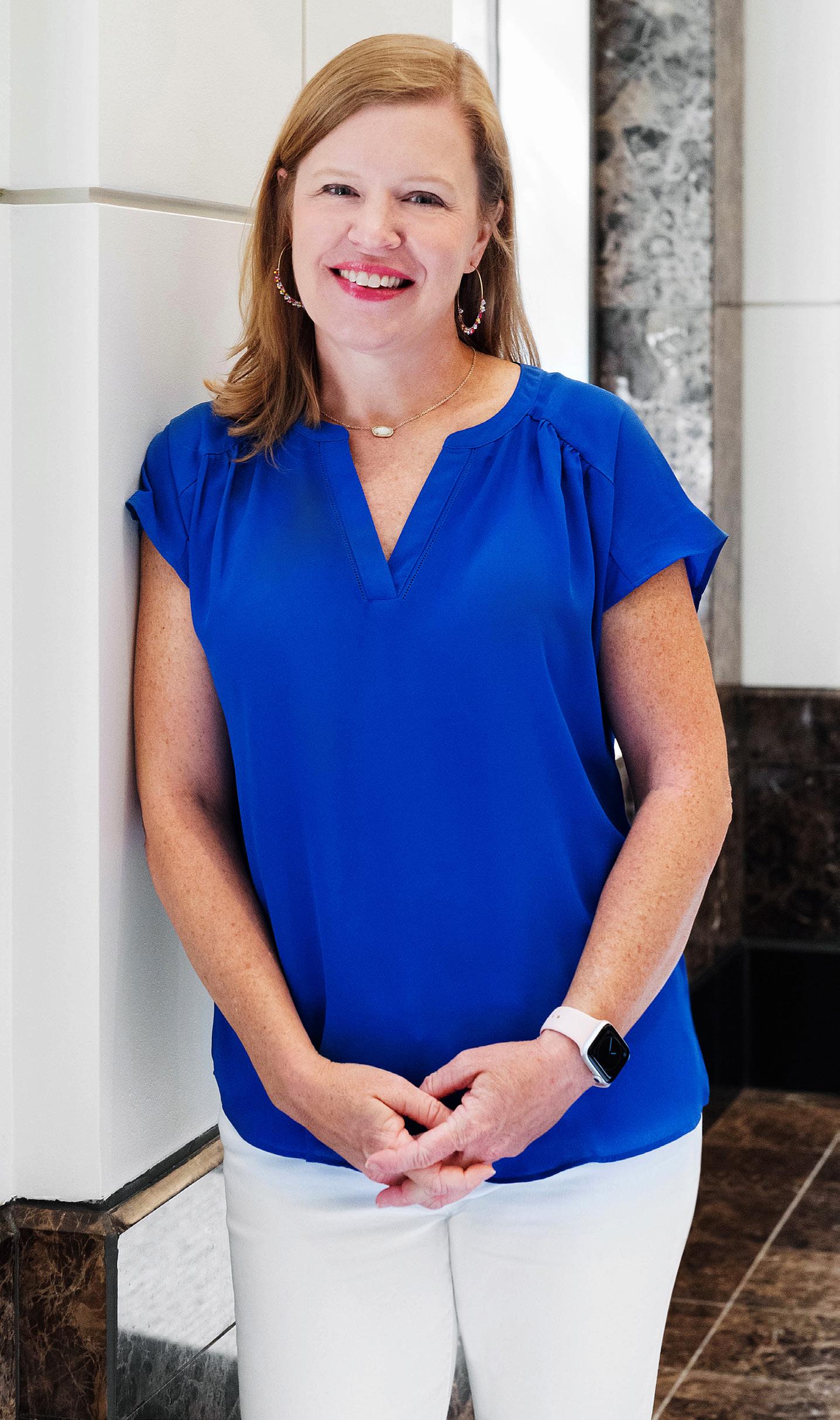 Lindsay Caulder SVP of HR World Acceptance Corporation
Lindsay Caulder SVP of HR World Acceptance Corporation
“People feel joy and love serving their communities—both internally and externally.”
LINDSAY CAULDER
She also hired an internal recruiter and prioritized internal recruitment infrastructure. That team, now four individuals, ensures new team members are a culture fit with key leadership abilities and skills. The initiative is saving the company hundreds of thousands of dollars. “It’s a different measurement of the right candidate,” Caulder says. Along with cost savings, the long-term impacts have been increased retention and an ability to grow talent once a person has joined the company. “Our goal is to hire right and then develop,” the HR leader explains.
With this success in hiring comes a focus on shifting talent within the company. Such mobility strengthens World Acceptance through both experience sharing and increased motivation and engagement.

Development, training, and continued learning at World have transformed under Caulder’s initiatives as well. Expanding from a singular focus on compliance training, an internal team of learning specialists implemented operations training, increased leadership development, and overhauled new manager training. “Because approximately 90 percent of managers are internal hires,” Caulder says, “it’s critical for them to get the right training to succeed in new roles.”
One of the biggest lifts of Caulder’s tenure has been a rollout of the entire Workday suite in July 2018. This has allowed for online integration of HR functions. The organization launched digital time cards, an online recruitment system, and online learning programs. Applications and performance reviews have also moved online. After a year with the project in steady state, Caulder continues to see increased efficiency.
“I feel the responsibility for four thousand team members,” Caulder says. “How do

I help them have a really great work experience?” Responding to this question and “a sense of responsibility to do good by them,” Caulder has initiated an annual engagement survey. “We keep taking the pulse on how employees feel. It’s so important,” she explains. As a result of the most recent engagement survey, the World Finance teams in South Carolina, New Mexico, Knoxville, Tennessee, and San Antonio have been recognized as top workplaces.
The HR team, twenty people with two directors, has been “right by my side through all of this. I couldn’t have done it all without them,” Caulder says. Along with a strong HR team, Caulder credits leadership with successful facilitation of such massive changes. “Support from the senior executive team has been critical, allowing for a rollout of programs without red tape, with quick movement, and without friction.”
She exemplifies this agile behavior in talking about adopting Martin Luther King Jr. Day as a paid holiday that includes closing all branch locations. While Caulder acknowledges it was a long time overdue, when the issue came to the forefront, it only took one afternoon for the senior executive team to decide to make the change, craft a rollout plan, and make the announcement.
In understanding her role as an HR leader, Caulder repeatedly returns to a motto she hears regularly from the CEO of World Acceptance: “Do good.”
“I feel the responsibility for four thousand team members. How do I help them have a really great work experience?”
LINDSAY CAULDER
For Julie Cummings, maintaining a people-first mentality comes naturally. She grew up in a home of elementary school educators—her mother taught third grade, and her father was an elementary school principal—where she had daily examples of putting others’ interests before oneself. “I was always surrounded by their passion and innovative ideas on how to enhance their students' learning with high levels of success,” Cummings says.
She recalls instances where her mother created personalized learning plans, tailored to students’ unique abilities, for students with diverse skill sets rather than relying on standard lessons. “Everything she did was with her students in mind, and the same went for my father. He was always looking for opportunities to improve the student experience,” she says.
With such consistent, generous character influences, it is no surprise that Cummings has developed a personal affinity for human resources. “Between the influences of my
parents and college classes, I was certain that HR was the path I wanted to go down. Twenty-plus years later, I couldn’t have been more right,” she says.
Now, as chief human resources officer at BKD CPAs & Advisors, Cummings is matching BKD’s people-first philosophy with her own. She is working to keep HR agile to meet the changing needs of the firm and improve the employee experience through personalization.
Since joining BKD more than ten years ago, Cummings has gone from a team of one to a department of more than seventyfive across four functional areas. Her main responsibilities are rooted in offering oversight and strategic direction to talent acquisition, total rewards, HR operations, and employee relations, but Cummings also serves as a “voice of the people.”
“In every major change or growth initiative the firm is taking on, our executive leadership team always asks the question: ‘How will this affect our people?’ This is one of the first questions this is brought forward in these types of meetings, and our

executive team relies on me to be the voice of our people,” Cummings explains.
To serve as a voice for employees, Cummings focuses on making sure that employees’ own voices are, in fact, heard. “One of the best ways to engage our workforce is for them to feel as though they have ownership and influence in change,” she says. “We regularly hold engagement surveys and utilize other informal feedback programs to drive change based on what our employees are needing to be successful.
“When we do enact change or start a new initiative,” she adds, “we often form task forces or lean on certain groups of employees to be the drivers of what that change will look like.”
To get an idea of what this looks like in action, Cummings offered some examples of actions that BKD took upon receiving feedback in these four categories: performance management, career mobility, professional development, and “dress for your client”— BKD’s dress policy. In each of these categories, BKD employees were given the autonomy to make decisions that would help them achieve their best work—providing flexibility in daily dress based on client interactions, giving employees the opportunity to choose how to upskill or develop, and offering mobility in employees’ career paths.
“What I have found in my experience is that when you give people the authority to make their own decisions, you can build a greater culture of trust between employees and leadership,” Cummings says.
All these initiatives, including more recent ones like mandatory working from home and the implementation of an EVP task force, are powered not only by employees but also through agility. To Cummings, agility is key in both attracting and retaining top talent as well as allowing for seamless transitions in the workplace to accommodate shifting priorities. The EVP task force has been crucial for addressing employee feedback.

“In our meetings, we discuss specific culture and benefit strategies that could be implemented that would either help increase employee engagement or attract new talent to the firm,” Cummings explains. “This committee is tasked with being nimble regarding the priorities of our workforce and having an open mind when it comes to exploring new possibilities for our firm.”
This, of course, also includes any diversity and inclusion efforts. “Our goal is to promote diversity and inclusion in every aspect of our culture, including career








development, firm sustainability, recruiting, and innovation,” she says. “We want every one of our employees to feel as though they belong at BKD, regardless of their ethnicity, race, or gender, and we work to ensure that message is clear across the firm.”
As the HR team develops these areas for BKD, Cummings is clear about the joy and appreciation she has for her team and the company as a whole. “Over the past few months, I have been so proud of the way our department has delivered for BKD in supporting our people,” Cummings says. “All in all, we want our people to tell the story of our brand and bring visibility into why BKD is a great place to work. We want to showcase their talents and how they contribute to providing unmatched client service.”
“What I have found in my experience is that when you give people the authority to make their own decisions, you can build a greater culture of trust between employees and leadership.”
JULIE CUMMINGS
For Sherry Schultz, a career in human resources truly was a calling. Growing up Jewish, Schultz often attended temple with her grandfather. She recalls on one occasion that a man sitting next to her had quietly rolled up his shirtsleeve during the message. She noticed tattooed numbers on his forearm and tugged on her own grandfather’s sleeve to ask why this man had such a strange tattoo. “I remember it so clearly. My grandfather sat me down after temple under this beautiful tree, and that’s where I learned about the Holocaust,” Schultz explains.
Rather than feeling afraid, Schultz believes that learning about this senseless
persecution of her people for their religious identification emboldened a sort of resolve within her. “After that, I vowed to myself, and still continually do, to always respect the journey of others, to always seek to understand, to remind myself that I do not know anyone else’s journey or culture without living it, and to always listen to others’ stories,” she says. “It’s almost like then, in my eight-year-old brain, my HR mind was formed,” Schultz muses.
Though these vows were personal, Schultz has found that they truly come alive in her HR career, especially in her current role as executive vice president and chief human resources officer at Walser Automotive Group.

For Schultz, diversity and inclusion isn’t just a box for HR leaders to tick. It is something to commit your personal and professional life to, which is why it is important for leaders to listen, be empathetic, and be willing to learn at all times.
“As HR leaders, we are responsible for helping our employees find meaning in all that they do,” she explains. “We have to listen, individually, to employee needs. If we aren’t listening and aren’t empathetic about their situations, how could they feel as if there is any purpose to what they do at the organization?” It is this type of mentality that has helped Schultz implement offerings and programs for her diverse workforce that both help and empower employees.
“We have to pulse check our people and find the things that keep them engaged,” she explains. Cue benefits like paid maternity/ paternity/adoption leave or programs such as Women of Walser or Drive With Pride. “Women of Walser found its way into the company after I recognized that many of the fantastic women I met at the company needed more support—they needed guidance on how to build their careers or how to overcome some of the paternalistic challenges in the automotive industry,” Schultz explains.
So Schultz went to the CEO of Walser to figure out how to implement female representation on the sales floor and how to boost female participation within the industry at large. “The history of women in automotive is fixed at best—women have always felt
really isolated,” she explains. “So we started small. It started out as giving the women within our company a network, or really, a community. Now we have four female directors, and we are working on integrating women into every level of sales at Walser.”
Inclusion goes beyond gender, and Walser’s Drive With Pride aims to address inclusion from the LGBTQ+ perspective. “This platform really focuses on education. This includes using the right pronouns or, from a trans perspective, using the correct vernacular so we are going to focus on using the right language,” Schultz says. “We want to work on allyship. When people feel like they have a company that will engage with them on something that is so personal, the exchange becomes authentic—it’s more than just an initiative.”
To Schultz, diversity in both thought and action should be a main driver for any leader.
“Diversity is informed by the culmination of our life experiences up to that moment, and I think that also informs my leadership style,” Schultz posits. She understands and acknowledges that she is always learning and changing and credits her HR successes to that growth. “I genuinely feel that the leader I am today is vastly different to the leader I was twenty years ago, and that’s a good thing!” she says with a laugh.
In addition to growth, Schultz also believes that vulnerability as a leader has added to her success in the HR space. “Once I realized that it wasn’t about if I would fail, that rather it was about when I would fail, vulnerability came into the picture,” she says. “I was able to recognize when I wasn’t at my best and to learn from it. Ultimately, as a leader, I need to teach and to be taught, both from the business side and the human side.”
At MMA, we elevate our colleagues’ experience by committing to a diverse, equitable and inclusive workplace.
“If we aren’t listening and aren’t empathetic of their situations, how could they feel as if there is any purpose to what they do at the organization?”
SHERRY SCHULTZ
When MGM Resorts was beginning to build its newest property in Springfield, Massachusetts, the company knew it would be met with the challenges that come with opening a nearly $1 billion resort and casino.

That was especially true when it came to hiring. The former industrial town had fallen on tough economic times. Chief Human Resources Officer Laura Lee recognized that it would take an effort before its 2018 opening to supply one of its “small minicities” with the hundreds of local employees it needed.
Lee says that the work of identifying talent and filling hundreds of specialized
Laura Lee has grown with the ever-expanding MGM Resorts for more than two decades, helping mold a company culture that attracts and retains top-flight talentLaura Lee CHRO MGM Resorts
jobs has been one of the toughest responsibilities in her portfolio of overseeing talent management, engagement, and culture for seventy-seven thousand employees and twenty-nine properties worldwide.
But it’s also one of the company’s proudest achievements. As an industry leader, MGM Resorts met or exceeded its diversity goals, veteran recruitment, and local hires in both Springfield and its DC-area resort in Prince George’s County.
In her second decade with the company, Lee says MGM succeeds in those areas because it spends the time necessary on the ground to get to know the community and its needs. In Springfield, that meant helping revitalize a local economy with great opportunities.

“When manufacturing left the City of Springfield, the economy declined,” Lee says. “We wanted to show our commitment to the community by living up to our diversity hiring commitments.” MGM Resorts attracts the talent it needs by sharing the values that the company holds and offering jobs with the ability for advancement and a good middle-class income.
In places like Springfield, not only was the gaming industry new to town but the skill sets needed for the positions were also new to the area.
The goal for local hiring (required by the company’s state gaming license) was also steep—35 percent or more of the new employees would have to be hires from the City of Springfield. Lee says she and MGM
worked hard to connect with organizations in the city, such as local community colleges and nonprofits. Because MGM operates both hotels and casinos, the business overall is “very complex.” But it also means employees have an opportunity to advance in a variety of hospitality or casino careers.
That’s one reason that Lee helped institute the MGM Resorts College Opportunity Program, an online certificate and college degree program, at no cost to MGM Resorts employees. “With any industry, there’s an evolution, and technological changes occur within that industry,” she says. “As MGM evolves its digital platform, you want to make sure your employees have the opportunity to reskill and retrain for future opportunities.”
Lee is also charged with maintaining that pipeline for a company that is constantly growing—by mergers and acquisitions and by building new resorts and casinos, like the Springfield location and MGM National Harbor, just minutes from the nation’s capital. It’s not just retention and advancement programs, like the free college benefit; it’s also finding new ways to incentivize promising new talent.
“The exciting part is finding new ways to measure and reward employee-excellence to
drive our business strategy,” she says. “You have to ensure your performance management practices support those changes.”
Though many industries have taken a hit during the COVID-19 pandemic, the hospitality and tourism industry have suffered the most, putting a temporary halt on much of that long-term planning. As many of MGM’s employees have been unable to work, Lee is the cheerleader for all hospitality employees. “I hope other industries will consider the transferable skills of hospitality employees,” she says. “They are great, hardworking, dedicated employees. This is a 24/7 job. These employees understand that, and they are there to work hard.”
As casinos continue to reopen, Lee will get back to strategic planning. Hopefully, it
will mean more opportunities and growth for MGM, where a part of Lee’s role has been to explain how the casino and hotel business has evolved over the years.
Lee explains that casinos have become so much more than places to gamble—they are full entertainment destinations.
“You look at the casino, thirty, forty, fifty years ago and it was a different type of business; it has evolved tremendously,” she says. “Part of the stigma, associated with casino operations is that most people don’t understand the broad range of disciplines and business-savvy skills needed to operate a full-service casino, with food and beverage, hotel, finance, IT, and marketing components.
“Once it is understood that these are good middle-class jobs, the stigma is no more.”





CALV is proud to partner with Laura Lee and MGM Resorts International to create workforce training and development solutions for company-specific needs.

“As MGM evolves its digital platform, you want to make sure your employees have the opportunity to reskill and retrain for future opportunities.”
LAURA LEE
It’s fair to call John Foster a people person.
The longtime HR executive has helped thousands of people and dozens of organizations perform at their best, thanks to an agile approach to talent management that drives customer obsession and leads to breakthrough outcomes in times of change. A graduate of Miami University with a dual degree in psychology and communications, Foster has led leadership development at companies such as the YMCA, Fidelity Investments, Charles Schwab, IDEO, Hulu, and more.
In 2019, he was hired by Santa Monica, California–based TrueCar Inc., which was going through a major transformation and executive management shift.
“Before TrueCar, I was working on my own business, called Gamut, to build talent development tools and advise start-ups. But I realized what I like most in my career is being a head of HR, so I’ve migrated back,” he shares. “My specialty tends to be transformational-type work, and TrueCar was in a situation where they needed some change management and facilitation support for a lot of executive and organizational changes.”
How TrueCar shifted its strong company culture to a virtual environmentJohn Foster Chief People Officer TrueCar Inc.

When Foster took the job, there hadn’t been a consistent HR leader for a number of years, so there was a backlog of process improvement and talent management that needed attention. In partnership with his People Leadership team, Foster has helped redesign TrueCar’s talent management processes, leadership development processes, and internal communications.
“My job is to be an architect of a great place to work,” he says. “A key role of HR is to do anything and everything necessary to put the right people in the right place at the right time. Thinking ahead about people’s needs, understanding the pulse of the company, and being connected throughout the organization leads to better insights and better solutions.”
One of his major initiatives in 2020 has been helping shift the company into a virtual environment—something that was in effect even before the pandemic forced many companies to do the same thing.
“We were already on the path to doing some big cultural shifts to be a more integrated and collaborative company, as we know our next stage of growth is going to require strong cross-functional collaboration in order to help the business move forward,” Foster explains. “We were aiming toward a bit of a restructure in 2020 and were already considering how to engage with a more distributed talent base when the COVID crisis hit. That accelerated our thinking.”
The company knew being distributed would allow it to bring in more talent from elsewhere, as the tech talent in Santa Monica—as well as at its Austin, Texas, office—can be expensive to manage.
“Our Dealer Sales and Service team was already spread out across the country since we work with car dealers directly, so it wasn’t that big of a shift for us to create a more proactive, constructive, dynamic workplace
and use the momentum of the crisis to help us push more into it,” Foster recounts. “For me, the global crisis made things a little bit easier because there wasn’t much influencing I needed to do with leadership.”
One of the things that has made it work well right off the bat is that now everyone is on a level playing field, meaning the people in Santa Monica are no longer the “center” while the folks in the field are no longer “remote.”
“As a tech company, most of our people were already pretty mobile. Most of our jobs don’t require a physical presence, so there wasn’t a lot of complexity with the change. Also, our executive team is pretty unified and really good at communication,” Foster reveals. “We’ve focused a lot of energy on the quality of our executive communication, and I think for the most part, people don’t miss their daily commute.”
A key to TrueCar’s success has been utilizing the platform 15Five, a performance dialogue tool that connects managers and their direct reports on a regular basis.
The most significant challenge has been parents adjusting to the fact that schools and daycares were closed for much of 2020. The company supplied some resources to help deter some costs and better manage the situation, but it’s still a stressor for most families.
“We had our experience team, which was used to working at our facilities, focus more

on virtual events and supporting everyone with their home-based workstations,” Foster notes. For instance, TrueCar supports themed virtual happy hours and has launched Donut (a Slack application) to run thirty-minute mixers that randomly match people with others in the company they normally wouldn’t meet. One team even hosts a weekly Zoom call modeled on a radio show format to make the experience more fun and engaging.
CEO Michael Darrow has been a strong proponent of frequent communication and is highly involved during all company Zooms. When he started hosting virtual executive “stand ups,” he wore a different football jersey each day and had people guess the theme of the week based on the jersey.
“We believe our communication efforts are central in keeping everyone connected and engaged, and it lets people share things that everyone is working on and feel in the loop,” Foster says. “Facilitating the checkins and making sure they are fun helps avoid the monotony that can make any meeting boring.”
In Foster’s opinion, there are three keys to establishing a successful company culture in a virtual environment: empathy, executive communication, and support. And TrueCar leaders continue to monitor all three as they steer the company toward success.

The best hires require the best data. Searchlight's competencybased talent software makes hiring faster, more predictive, and equitable.
We're proud to partner with forward-thinking People Leaders to unify Talent Acquisition with Talent Management.
“We’ve focused a lot of energy on the quality of our executive communication, and I think for the most part, people don’t miss their daily commute.”
JOHN FOSTER
“From the ground up” is a common theme for Karen Shier.
By JOSEPH CHARNEYIn each academic and professional phase of her life, Shier often had to build from scratch, which nurtured her creativity and diligence. Her vast experience led her to her current role as vice president of human resources at Trillium Staffing Solutions, a business dedicated to serving the employment needs of companies in diverse fields.
In her senior year of high school, Shier spent much of her time working as a floor supervisor at McDonald’s and as a bank teller while also obtaining four different banking certifications. She would go on to be awarded a few finance-related associate’s degrees from Mid Michigan Community College, and then continued working in banking—at first in a customer service role, then as an assistant branch manager, and then in the same bank’s corporate office to help with their mortgage operations.
“At the time, we didn’t have a strong HR lead at the bank, and I remember the CFO and
How Karen Shier built Trillium Staffing Solutions’ HR department from scratch to support the growing company
my supervisor came to me and said, ‘You’d be really good at HR,’” Shier says. Although she hadn’t seriously considered HR before that time and wasn’t really sure of her career path, Shier recalls reflecting that many people in her family worked in HR. “It got me to thinking maybe that could be a good fit for me. It was certainly a good place to start.”
So, Shier pursued a bachelor’s degree at Central Michigan University. Whereas most of her peers there had only recently moved away from home for the first time, Shier arrived on campus with a unique perspective and in a different stage of life. Although her path was nontraditional, it had its perks.
According to Shier, a few of her professors took note of her circumstance as a working, nontraditional student. “I really feel like I got a bit more attention—just because we would have really great conversations,” Shier says. “I think they sensed my willingness to learn and my drive to succeed.”
When an employer for a plastics manufacturing company in Battle Creek, Michigan, reached out to one of her professors—Dr. Kevin Love—asking for résumés, he sent them only one: Shier’s.
Upon graduation, Shier got her first major HR job with plastics company ASMO Manufacturing, and in her first year, she interviewed upwards of nine hundred people
and hired over two hundred. In that role, she helped the company grow to new heights.
“I wore a lot of hats, being involved in almost all HR functions at that company,” Shier says. “It was fast-paced, and I learned a lot—a great experience to get my feet wet.”
While she was there, the company opened a new factory in Texas, and Shier was tasked with staffing the plant and setting up its HR functions. “That was a great experience for me,” she says. At that point, Shier enrolled in a cohort MSA program at Central Michigan University and earned her master’s degree with a concentration in HR.
With that experience under her belt, Shier arrived at Trillium Staffing Solutions, just as

You are not generic. You are not standard issue, You are not off the shelf. And neither are the solutions we offer you. Our ideas emerge from immersion in your business and the business intelligence and experience we have developed over decades. To discover your singular path, get in touch.
Deloitte.com/makeyourimpact

the company was looking toward expansion. After having recently acquired a few different companies, Trillium finally decided to invest in their HR department—and they chose Shier to lead the charge.
“The company kept growing organically and through acquisition into pretty much all fifty states,” Shier says.
Trillium Staffing Solutions now places qualified professionals in many different domains: IT, engineering, construction, driving, accounting, finance, clerical, and light industrial, among others. “When I first started at Trillium in our corporate office, we had twenty people,” she explains. “We now have between sixty-five and seventy.”
Just as she did at ASMO Manufacturing, Shier was responsible for establishing the ins and outs of a previously nonexistent HR department. “At Trillium, I set up virtually all of our HR processes and our procedures and developed that trust and rapport with our divisional leaders,” Shier says.
With more than 360 internal employees and between 5,000 and 6,000 staffed on a week-to-week basis, Trillium Staffing has become a critical resource for companies in diverse fields across the nation—and Shier helps assure that everyone has the resources they need to do their jobs. “It’s a familyoriented company; we treat employees with care and mutual respect,” Shier says.
Although staffing companies typically have high turnover, Trillium’s managementlevel and corporate employees have remarkable longevity. “With my fourteen years of tenure, I’m the baby—most other VPs and corporate managers have been with the company longer.”
Having implemented time-saving training systems and automated, paperless onboarding processes, Shier is eager to continue refining the HR functions that she built from scratch. Luckily, Shier can now do that with the help of her amazing team of dedicated HR professionals.
Unique problems need unique solutions.
“I wore a lot of hats, being involved in all HR functions at that company. It was fast-paced, and I learned a lot—a great experience to get my feet wet.”
KAREN SHIER
It’s not every day that a temporary position leads to a successful and fulfilling sixteen-year career, but that’s exactly what happened for Foot Locker’s Dan Whinnie. Whinnie was working for a different retailer in store operations and management when he realized he was interested in roles that had profit and loss responsibility. He found his chance in a six-month temporary financial analyst position for an IT project with the famed athletic apparel company. The move paid off. Today, Whinnie attributes his successful climb up the ranks both to his own hard work and to a company that values building up its team members.
“I’m probably one of Foot Locker’s poster children for promoting from within and being able to grow your career,” says Whinnie, who is currently vice president of finance, technology, and supply chain. “Now I’m head of the department, and more, where I started sixteen years ago as a temporary financial analyst. It’s something I’m proud of from a career perspective.”
Whinnie’s main responsibilities today include budgeting, forecasting, analysis, and accounting within the function he leads. In addition, he negotiates most of the strategic technology contracts and manages all of the dollars the organization spends. He also communicates on a regular basis from a forecasting and dollars perspective with
Self-described “technical geek” Dan Whinnie couldn’t be happier about his role and the growth opportunities Foot Locker providesDan Whinnie VP of Finance, Technology & Supply Chain Foot Locker
the CFOs of Foot Locker’s various divisions, such as Kids Foot Locker and Champs Sports. Most importantly, his role provides a valuable bridge between finance and technology.

“With the unique nature of technology costs, my group is a somewhat self-contained finance unit within technology that reports to the CIO,” he says. “While I’m a financial professional, I’m a technical geek at heart. Being able to play an integral part in the technologies, and now with some of my supply chain and digital marketing responsibilities, means my role is constantly changing, and that change makes it exciting. I get to do what I’ve been schooled to do but also play a part in the technical side of things.”
Whinnie is proud of his many accomplishments at Foot Locker, and one recent instance stands out in particular. He noted that, like so many organizations, Foot Locker had to pivot when COVID-19 hit and figure out how to protect its financial assets.
“I ended up playing a big role in protecting our cash by structuring a lot of different financial deals that allowed us to keep moving ahead on projects,” he says. “I was able to work with our partners to be creative with how we think about managing our technology financials, ideas that we may not have considered in the past.
“By using relationships I’ve cultivated over the years with many of our partners, we found other ways to do things and keep our business moving through this challenging time,” he continues. “By the nature of the amount of dollars we spend in tech and
supply chain, I helped the company maneuver through that, too.”
He’s also proud of what he’s been able to accomplish since Foot Locker gained its new chief information officer, Pawan Verma, in 2015. Whinnie credits Verma with injecting new energy in the company’s technical capabilities, which has helped him in his own role.
“I put in just countless strategic deals over the last five years with strategic tech vendors and set them up on a global level,” he says. “That makes me proud personally and professionally to be able to contribute to allowing us to move forward with all these new technologies, which help us stay relevant with our consumers.”
As for his leadership style, Whinnie described himself as collaborative and the antithesis of a micromanager. He also believes in forging strong relationships with vendors. Today, Whinnie has a total of fifty-five people reporting to him, which includes supply chain team members as well as technology and digital marketing finance team members.

Adobe Experience Cloud offers AI-driven solutions for marketing, analytics, advertising, and commerce through the most comprehensive set of customer experience applications and services available.
“I believe I've gotten to where I have because of my collaborating abilities, both inside my groups and outside,” he says. “I also like to lead by example. I’m not one to shy away from digging into the details and doing a lot of what I consider the ‘dirty work’ myself. So, a lot of times, I’ll be right in the trenches alongside my team. I would never ask anybody to do anything that I wouldn’t do myself.”
The VP praises the Foot Locker corporate team for providing a positive environment for team members and looks forward to continued growth with the organization.
“We’re still going through our transformation, and I think things are going to continue to morph,” Whinnie says. “We’re starting to spend some of our dollars on corporate productivity, things that we put in play to try to help our internal customers be more efficient, in addition to our continued focus on improving our external customer experience. Those are some of the things that are coming up, and honestly I just want to continue to grow this role and continue to make a difference in our business.”
“I believe I’ve gotten to where I have because of my collaborating abilities both inside my groups as well as outside. I also like to lead by example.”
DAN WHINNIE
Jennifer Goschke has deep retail roots. K-Mart/ Sears, Walmart, and Office Depot are just a few of the accounting expert’s stops on her career journey prior to coming to 7-Eleven.
“It can be difficult to tie the accounting function to the overall vision of the company,” says Goschke, vice president, chief accounting officer, and controller. “But our purpose is to make people’s lives better. If you don’t think that something small like a Slurpee can make someone’s life better, even for just ten minutes, then you haven’t had one in a while.”
The sentiment is a perfect encapsulation of Goschke’s ability to bridge the hard numbers of her department with the wider lens of retail that often relies on cross-functional work, relationships, and the collective vision required to achieve optimal success. “So few projects we work on only involve accounting,” she says. “If I want to get something done within the organization, it will require that I collaborate and partner with someone
Goschke cultivates cross-functional relationships to better guide her team and the company toward success
in IT, someone in HR, and/or someone in operations. It’s so important to build those relationships before you need them.”
Goschke says cultivating those relationships means reaching out for touch-base meetings, or just finding chances to get to know stakeholders. “It’s important to reach out, especially when you don’t need anything,” Goschke stresses. “The perfect time is right now. Taking that time has been hugely impactful on my career.”
Cultivating relationships is also important when it comes to working with external partners. “Crowe enjoys our deep and strategic relationship with 7-Eleven,” says Bill Watts, partner and national retail leader at Crowe. “Jennifer is instrumental in this relationship, bringing her accounting knowledge, business expertise, and retail experience to bear and helping guide Crowe’s efforts to support her organization’s needs and strategic initiatives. Her vision and insight make our partnering efforts more successful for both parties.”
Cultivating relationships was a lesson Goschke learned early in her career when she
left public accounting to help a post-bankruptcy K-Mart right itself. “I learned early that I needed to invest in my team and make sure they knew I was there for them,” the VP says. “How do I help them be successful, whether it’s removing roadblocks or ensuring frequent, quality communication, or providing tools that they need to bring their best selves to work.”
Ensuring the quality experience of her team may have seemed much easier in the past. At 7-Eleven, Goschke now oversees a team of more than four hundred. It’s one of the reasons she is so heavily committed to the idea of mentorship. “My predecessor has put us on such a great journey of excellence, and I’m really trying to dovetail what she had started,” she says.
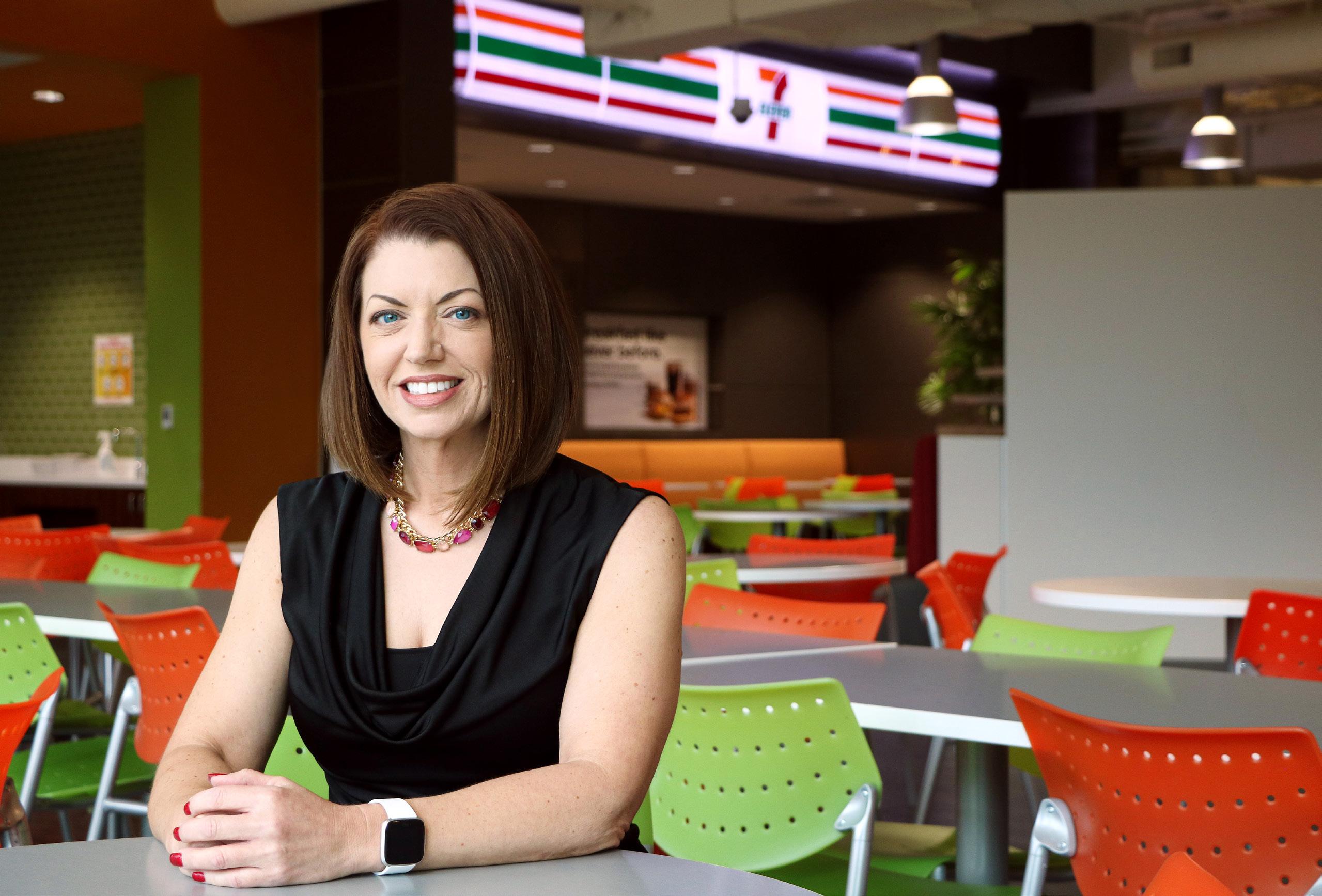
The VP met with IT partners and asked if they would be able to build a mentoring app that’s able to match ambitious younger employees with tenured and experienced veterans of the company. “They were able to find an existing app that does exactly what we need it to,” the VP explains. “It does more
than blindly match people; it pairs people based on strengths and skills that people are looking to better develop.” The program is in its pilot phase, and the project was slated to begin in summer 2020.
“I think it’s really going to help us move forward and invest in our people,” Goschke says. “And, honestly, I’m looking for some reverse mentoring. I’m sure some of our newer team members could show me how to better utilize and integrate new technology, and that would add tremendous value for me.”
In her efforts to continually find new ways to aid her finance team, Goschke says the organization has created a director of process improvement position, where the sole job is to partner with senior directors and their teams to take a fresh look at departmental processes and figure out where “quick wins” can be made and what other projects might require long-term tending.
“An hour that a simple macro or automation can save is an hour we can spend providing more insightful information to our business partners,” the VP says. And as she
Jennifer Goschke VP, Chief Accounting Officer, and Controllercontinually underlines, that value is always passed on to customers in some capacity.
“It always comes back to that original purpose of wanting to make people’s lives better,” Goschke reiterates. The VP talks about solving problems for customers the same way she talks about making life easier for her team.

“If our customer is a busy mother who’s stopping to get gas on her way home from running errands, maybe we can help her by reducing the number of stops she needs to make,” Goschke explains. “We think about our customers and their challenges. What I love most about retail is just putting myself in customers’ shoes and coming up with ways to help them.”
During the COVID-19 pandemic, those challenges have been exponential. “We’ve found that customers were starting to shop in our stores almost like a mini bodega because they either didn’t feel comfortable going into a big-box grocery store or perhaps their local grocery store closed early.”
It’s meant adapting to continually changing needs, both on the customer and seller side. “Retailers typically focus on operating in a clean, fast, and friendly way, but I think this is the first time we’ve heard the word ‘safe’ talked about in terms of employees feeling comfortable coming into work, and customers feeling comfortable shopping,” Goschke says. “COVID has changed our standards, and we’ll continue to adapt to be there for our people and for our customers.”
“It’s so important to build those relationships before you need them.”
JENNIFER GOSCHKE








 By KEITH LORIA
By KEITH LORIA
Growing up in Hampton, Virginia, Sandra Brummitt looked up to a cousin who wanted to be an accountant and, like most kids, wanted to follow in the footsteps of the person she admired. “That’s where my interest in the field of accounting came from,” Brummitt explains. “I recently found a paper I wrote in school when I was a kid where I wrote I was going to be an accountant when I grow up, so I’ve known since I was young that I would pursue this career.”
Though she started her studies in electrical engineering at the advice of high school counselors, she quickly reverted back to accounting and economics while at the University of California–Santa Barbara. Upon graduating, Brummitt took a position with a small firm in Southern California where she specialized in tax and gained a
knowledge base of general tax information before moving on to KPMG on the East Coast in 2000.
A year later, she started an eleven-year run at Constellation, a Fortune 500 energy company, learning a great deal about the energy and utilities industry. While there, Brummitt achieved her MBA and was promoted to director of investor relations, obtaining a more strategic view of the company. In 2012, Constellation was acquired by Exelon, a move that necessitated her move to Chicago, where she would lead multiple state teams.
One trick that helped her succeed was scheduling time on her calendar to get out of her seat and talk with people, because it didn’t come natural to her at first.
“I learned the importance of networking,” she explains. “It’s not just what you produce. Even if you do great work, if no one knows you or your personality, your name won’t come up when they’re talking about a new project that can really benefit your career and give you great experience. I really grew up there and got to understand what it takes to be a professional. I worked on really interesting projects that propelled me to me promoted.”
In 2018, Brummitt spent a year as senior director of global tax reporting for Walmart in Arkansas before being offered her current role as vice president and chief tax officer at NiSource, where she oversees tax and (temporarily) accounting as NiSource looks for a new chief accounting officer.
“My current CFO, Donald Brown, used to work at Constellation, and as he grew in his career, he saw I was progressing in the power/utility space and reached out to me about a role on his team,” she notes. “One of the things that attracted me to the position was the company’s journey to retire a number of coal plants and replace them with renewable energy.”
That’s being done through NiSource’s partnership with Nipsco, which Brummitt notes is exciting because it allowed the company to invest in renewables through an innovative tax structure.
“From a tax perspective, it’s been a great opportunity to understand the incentives to build renewables,” she explains. “Because we can’t use a lot of the tax credits that make renewables very affordable, we’ve been able to develop a structure and partnership with the IRS and our utility commission in Indiana so that we can invest in renewables, leveraging a tax equity partner who can use those tax credits to ensure our customers are receiving the benefit very affordably.”
She’s a big believer in working efficiently and using all the technology available to your advantage, so she has championed automation in the workplace.
“In using tools like Alteryx, which I brought to my team this year, we can take repetitive tasks out of our every day, focus on value-added tax planning, have management understand what’s going on from a tax perspective, and create that story,” she shares.
Brummitt is also dedicated to giving back and volunteerism, and as such is extremely active with the National Association of Black Accountants (NABA).
“I didn’t learn there was such an organization until around 2012. I had just moved to Chicago and reached out to the organization and learned what they do,” she notes. “They have a program where they introduce high school students to careers in accounting, and we try to help people understand that you can get a really great career out of a fouryear college education.”
Getting closer to NABA through the years, even becoming president of the Chicago chapter, Brummitt has brought NiSource in as a corporate partner and held various events so the company and other companies in Chicago could recruit diverse talent.
“It’s been a great organization to develop talent and bring in diverse professionals to the accounting industry,” she says. “Tax law is ever-changing. It often changes significantly around elections, and the fact you can leverage it and apply it to a corporate context has always kept me interested and makes it fun. I encourage others to learn what it’s all about.”
“Tax law is everchanging. It often changes significantly around elections, and the fact you can leverage it and apply it to a corporate context has always kept me interested and makes it fun.”
SANDRA BRUMMITT




“I didn’t enjoy following systems. I wasn’t the most anal. I arrived in a high risk, high reward and I deployed that. And that’s why I was a terrible student, because even at that young of an age, I understood who I was, and I didn’t fear not succeeding in a system that wasn’t going to bring me any value. I basically ask you to do that. I’m probably the loudest advocate for you not being an entrepreneur. And that’s amazing.
“This is not about being an entrepreneur. This is about being self-aware and putting yourself in a position to succeed.”

right tool makes
More than a benefits administrator, we’re a total benefits solution. We deliver significantly lower and more sustainable benefit plan costs to employers through successful cost containment strategies and unique, innovative approaches.
Since January 1, 2010, we have been proud to administer and maintain Phelps Health’s provider network. We’re looking forward to another great decade together.
